Empowering the Community Leaders of




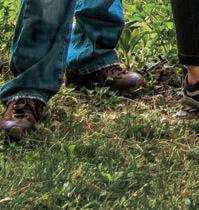
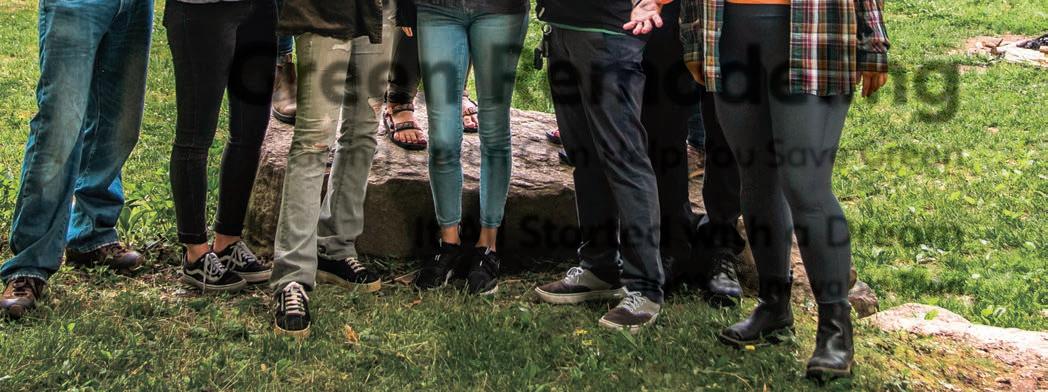


























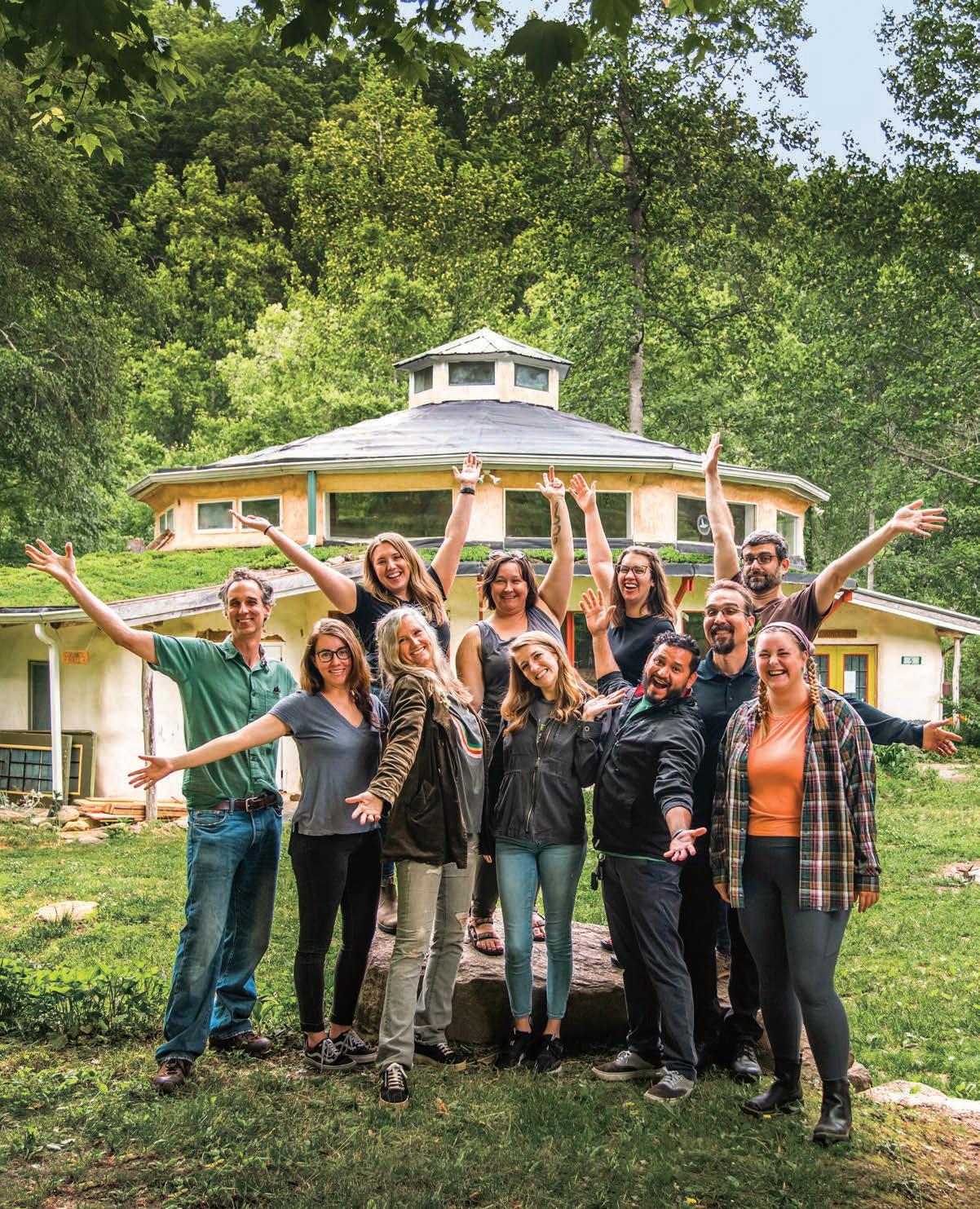
MEMBERSHIP DIRECTORY 2023 -24
Green Remodeling
Green Can Help You Save Green
All Started with a
Sustainability
Supporting Ecology by Uplifting Land, Life, and Social Design Solutions
Going
It
Dream 100% Renewable Plan


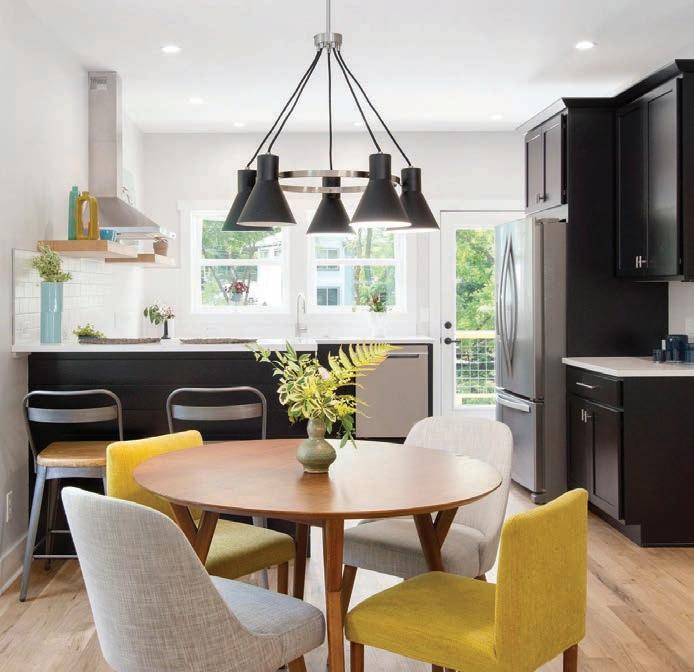

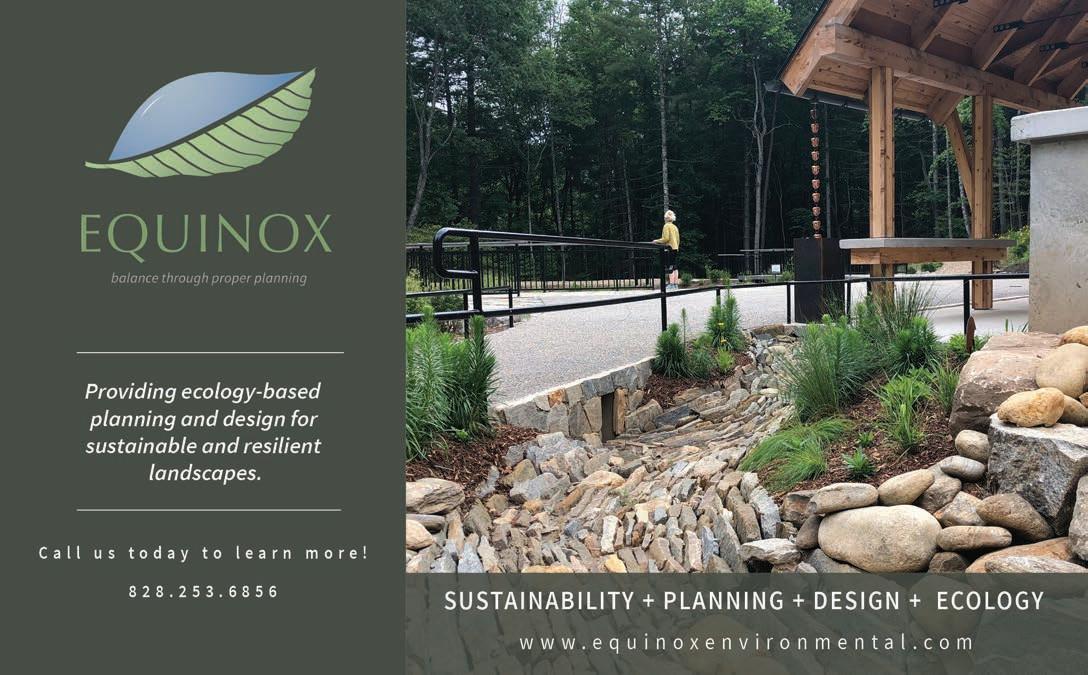
4 | www.GREENBUILT.org



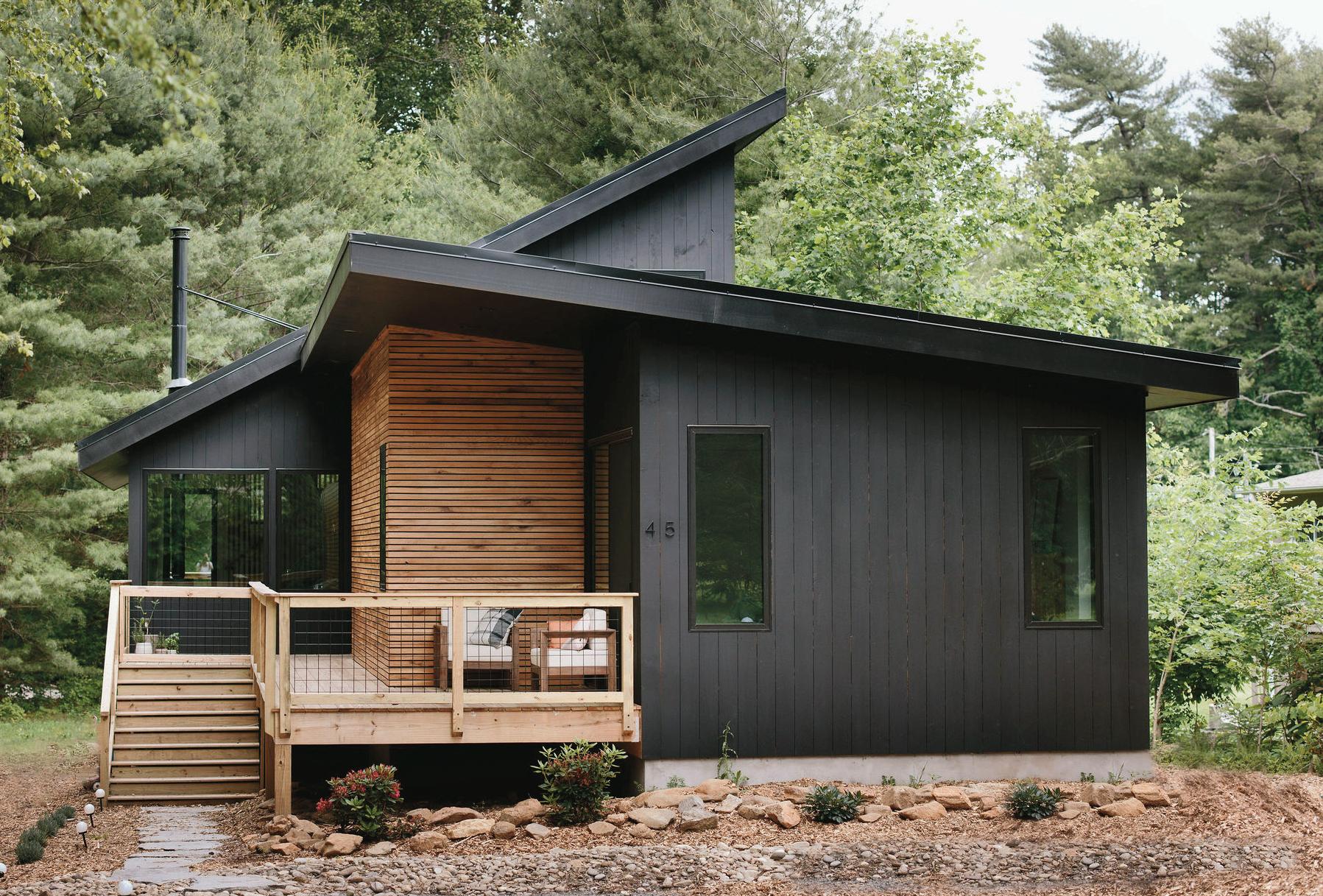
EarthtoneBuilders.com CUSTOM HOMES ‘The Home of Green Building’ since 2003





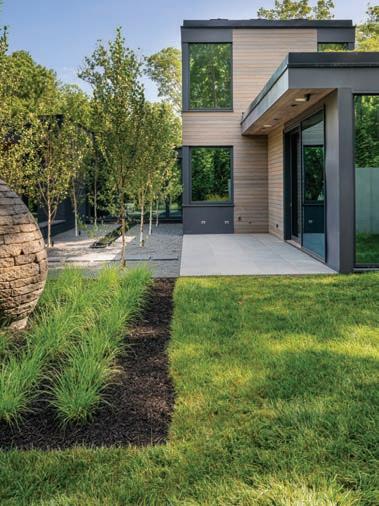
2022 WNC Builder of the Year Custom Homes | Luxury Renovations | Commercial REQUEST OUR FREE GUIDE Everything You Need To Know About Building a Home in Western North Carolina BuchananConstruction.com/Guide








8 | www.GREENBUILT.org 828.645.4546 676 Old Mars Hill Hwy, Weaverville, NC Insured • Certified • 24-Hour Emergency Service • Proudly serving WNC for over 22 years! PRECISION RESTORATION SERVICES WATER, MOLD, FIRE SMOKE & STORM DAMAGE SPECIALISTS Have MOLD? We are a locally owned business certified to do Mold Remediation.
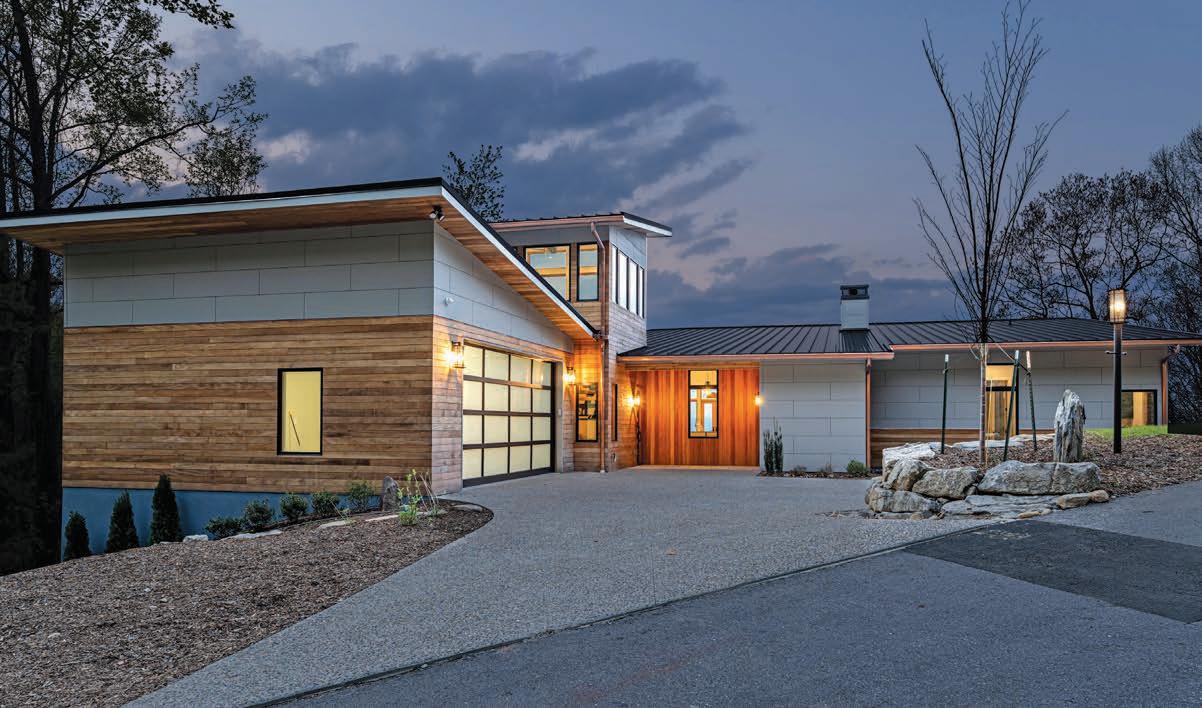


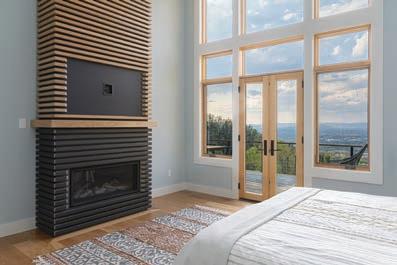

rcjbuilding.net | 828.216.4433 Custom Building Art Form as an
Case Studies
Dedication
This publication is dedicated to Cari Barcas, the highly skilled, focused and compassionate former Associate Director of Green Built Alliance. Cari's work and dedication to GBA and this publication forged the path for all who follow in her footsteps. Cari was the driving force of the annual Green Building Directory magazine from 2017 to 2022, and her knowledge, insights, and wisdom will remain here as a legacy forever.











Elevating her efforts in the environmental nonprofit world, Cari now leads the communications department at the global organization Stand.earth to drive corporations and governments to treat people and the environment with respect. Here’s to all the amazing work Cari has done at Green Built Alliance over the past six years, and her continuing passion for shaping narratives around climate justice and sustainability!

10 | www.GREENBUILT.org
Welcome to the Directory............................ 13 Do Your Part: Reduce Use, Save More.... 14
Wanna Buy a Home in Asheville?............. 16 Asheville Housing Costs Are Becoming Outrageous There’s No Place Like Home........................ 18 The Story of the Reardon Residence Sustainable Savings in Swannanoa........ 20 Affordable Housing Developer Installs Water Tech Device Anyone Can Build a Tiny Home................ 22 Tiny Houses Can Make Home Ownership More Accessible and Sustainable Restoring the Land.......................................... 24 Owner-Builder Lives Out a Dream High-Performance, Biophilic and Permaculture-inspired Homestead Profiles Leaders of Sustainability in Our Community.......................................... 26 Features Induction Cooktops....................................... 30 Countless Reasons to Consider This Technology Elevating Green Building Education...... 32 Love Your Mother............................................ 34 50 States, 50 Stories, and 50 Women United for Climate Justice Greener Remodeling Choices.................... 36 Going Green Can Help You Save Green Circularity in Construction.......................... 38 A Contractor’s Introductory Guide to Incorporating Circularity Building for Everyone................................... 40 Asheville Habitat Adapts to Changing Housing Needs Is Going “Green” the Way to Go?............. 42 Searching for Missing Middle.................... 44 Local Study Aims to Encourage Small Multi-Family Housing Adventure Within the A-Frame................ 45 The Alphabet of Design Begins with A Net Zero Ground Zero.................................. 46 Notes from the Climate Battle A More Sustainable Business Model...... 48 Equinox Woodworks’ Transition to a Workers’ Cooperative Elmer and Other FUD................................... 50 Don’t Believe Everything You Hear About Electric Vehicles The Nature of Car Dependency................ 52 The Case for Sustainable Transportation How EMFs Can Affect Your Health......... 54 Siri and Alexa Probably Shouldn’t be Your BFFs It all Started with a Dream.......................... 56 Highlights of Buncombe’s Renewable Energy Plan Why Trees?.......................................................... 58 The Benefits of Trees in Urban Landscaping The Earth Steward in You............................. 59 Supporting Ecology by Uplifting Land, Life, and Social Design Solutions Leave a Positive Footprint.......................... 60 Nonprofit Hosts Inaugural Earth Day 5K Fundraiser Making Solar Accessible................................ 61 Program Brings Free Systems to Families in Buncombe Members Membership Directory ................................. 63 Inside On the Cover Green Built Alliance staff at Earthaven Ecovillage, a living laboratory for a sustainable human future. Visit www.earthaven.org to learn more. KALEN BRELAND PHOTO ©2023/2024 ALL RIGHTS RESERVED STAFF Sam Ruark EXECUTIVE DIRECTOR Amber Gilot HUMAN RESOURCES & FINANCE MANAGER Annie McGehrin DEVELOPMENT & MARKETING MANAGER Hannah Egan OUTREACH & RESOURCE MANAGER Danny Harvey GREEN BUILDING PROGRAM MANAGER Jamie Wine CLEAN ENERGY PROGRAM MANAGER Summer Winkler CLEAN ENERGY PROGRAM COORDINATOR Kelvin Bonilla ENERGY SAVERS NETWORK MANAGER Steffi
VOLUNTEER & WEB COORDINATOR Kalen Breland MEMBERSHIP & COMMUNICATIONS COORDINATOR Mikal
ENERGY SAVERS NETWORK CREW LEADER
Rausch
Bonilla
GREEN BUILT ALLIANCE 2023 BOARD OF DIRECTORS
Mary Love (Chair), Stephens Farrell (Vice Chair), Jamie Shelton (Secretary), Adam Klaus (Treasurer), Chrissy Burton, Rob Johnson, Alesha Reardon, Deborah Wright, Chelsey Hett, Christine Davis, Leigha Dickens
Cari Barcas


GREEN HOME & LIVING GUIDE 2023-24 | 11



12 | www.GREENBUILT.org Custom Crafted Homes With a Focus On Energy Efficient Design and Environmentally Sound Building Practices. ashevillegreenbuilder.com
Welcome to the Green Guide
Western North Carolina is abundant in leaders of sustainability and community. If you are reading this, you probably care about the future of the earth, community, equity, local organic food and ensuring that wild places remain intact. You are one of these leaders, or on your path to become one.
If we are to sustain life on this planet for the next seven generations and beyond, people who care need to move into leadership positions to guide the way. This directory highlights some of those leaders who have propelled this community and the work of Green Built Alliance in many positive ways.
Reaching a clean energy future in time to slow down the worst effects of climate change is a herculean task that can only be achieved through the hard work of people in all sectors of the economy. It will take community organizations, businesses, and governments at all levels collaborating in small and large ways to make this shift.
We can be effective if more leaders rise, if all people in the community are cared for, if financial resources are poured into the green movement, and wise elected officials adopt policies that support the adoption of clean energy, conservation of forest and ecosystems, preservation of farmland, and inclusion of all people.
Fortunately, we live in an area where models of sustainability are alive and growing. And people are working across various sectors and disciplines to create a pathway forward.
At Green Built Alliance, we developed two strategic plans over the past year: one to guide our nonprofit for 20 23-2025 and another to chart the path for Buncombe County to achieve 100% renewable energy by 2042. Each of these plans was created by hours of conversation, in-depth research, and perspective from volunteers, staff, community leaders, elected officials, energy experts and people like you who want to see us
succeed and thrive. These plans are in place now, and our excellent staff, board, volunteers and Blue Horizons Project Community Council members are working diligently each day to fulfill the mission through millions of daily actions.
We are rolling along, with a focus on strengthening our four programs of Green Built Alliance:
n Energy Savers Network — which has provided Energy Efficiency upgrades for over 950 households.
n Blue Horizons Project — which developed a robust plan for moving toward the bold goal of 100% renewable energy by 2042 in Asheville and Buncombe County.

n Green Built Homes — which has certified over 2,900 homes, including 80 Net Zero Energy Certified
homes.
n Appalachian Offsets — which has raised funding for a solar panel installation of the Asheville-Buncombe County United Way downtown building, to be completed by the end of 2023.
In addition, we are hosting events like our quarterly member meetups and the annual Earth Day 5K to promote more face-to-face community connections in environments where we can have fun while promoting our mission. We also have a new website and invite you to come visit us at our downtown office space in The Collider.
It is with our deepest gratitude that we thank our members, the City of Asheville, Buncombe County, Dogwood Health Trust and many individual donors whose financial support of our work makes all this possible.
We hope that this Guide will provide inspiration, know-how, and connections to the people, companies and projects that are advancing sustainability in many innovative ways.
GREEN HOME & LIVING GUIDE 2023-24 | 13
Connect with Us and Explore Our Online Resources: greenbuilt.org facebook.com/greenbuiltorg instagram.com/greenbuiltorg
Downtown Asheville. SEAN PAVONE/ GETTY IMAGES/ ISTOCKPHOTO

14 | www.GREENBUILT.org

























GREEN HOME & LIVING GUIDE 2023-24 | 15 2 Locations: 68 N. Main St. C ANTON 828.492.0837 64 Bella Rd. SYLVA 828.586.8303 NC LANDSCAPE CONTRACTORS LIC. #0313 NC IRRIGATION CONTRACTOR LIC. #1280 BHGLANDSCAPES.COM
Wanna Buy a Home in Asheville?


Asheville Housing Costs Are Becoming Outrageous
 BY STUART ZITIN
BY STUART ZITIN
What can I say about real estate in Asheville? It seems a bit crazy for an old-timer like me. When I moved to Sandy Mush in 1981, you could buy an acre out there for $1,000. Now it costs $30,000 per acre. A year later, we moved into a rental home in Montford with 5 bed-
rooms, 3 full baths, and 2 large living rooms with a fireplace in each one. The owner offered it to us for $30,000 (yes, you read that right). Clearly, times have changed.
I’ve been confronted with this reality lately as I attempt to provide healthy housing at a reasonable cost. We started this 4-acre, 18-home subdivision in 2017, and

we sold the first home at the end of 2018. For the next home, I chose a plan from Rick Thompson, with double-decker porches looking at the stunning eastern view. It is 1,584 square feet with 3 bedrooms and 2.5 baths on a poured-concrete and frame-walled basement. Therein lies the rub.

Originally, I had planned to only

rough in under-slab plumbing in the unfinished basement, sizing for the expansion of the high-efficiency heat pump HVAC system, with a sale price around $490,000. My HERS rater, Matt Vande, informed me that it’s tough to leave unfinished space without losing points toward Green Built/Energy Star 3.1. Therefore, I decided to finish a 1-bedroom apartment in the daylight basement, which brings the heated square footage to about 2,200.
Selling this GB/ES home for at least $315 per square foot yields a sale price of $693,000, quite pricey for the Oakley neighborhood. In fact, my lender from ALFIE loans felt that my proposed sale price of $690,000 was too high. However, their own official appraisal came in at $6 95,000! Quite honestly, this makes me uncomfortable. Who are these new buyers of these former middleclass homes, now approaching jumbo mortgages? They’re probably not Asheville’s service workers, teachers, law enforcement, artists, social workers, tradespeople, factory workers, or even many health care workers, unless they’ve been extremely frugal super-savers or have some family money. We set out to build homes for them but have found ourselves in a very different real estate market. People are struggling to find any decent housing for $3 50,000.
I think I can fit some more af-

16 | www.GREENBUILT.org
case studies
Creating A Sustainable World One Home At A Time 828.279.6723 Lovethegreen.org mary@lovethegreen.org REAL ESTATE CONSULTANTS #LoveTheGreenTeam #greenhomesforsale
Rendering of 3-bedroom, 2.5-bath project. RICK THOMPSON IMAGE
fordable, smaller housing into this development. In last year’s Green Building Directory, I detailed the difficulty in building affordable housing to sell. I concluded: “Currently the American Dream of home ownership is simply not attainable for many folks.” We regret that in a wealthy nation like ours, it is still challenging to buy a home, even while almost 66% of households in the U.S. own their own homes. It is the most common way to accrue wealth, as real estate is a superior investment. In fact, the buyers of the first home we sold in December 2018 sold it again a year and a half later for a whopping $3 5,000 more than they paid for it!
Despite our concerns about affordability, of course we want to make money, and in fact, this development will help us secure a more comfortable retirement. I’ll be 70 (gulp!) this year, so I’ll have to start building multiple homes at once in order to finish in a timely fashion (read: before I die). We are eternally grateful that Asheville’s real estate market appears so solid despite the dramatic rise in interest rates. It seems that everyone wants to move here. We support density within the City of Asheville, but outside the city limits, we’re still seeing expensive homesteading land and sprawling, gated communities out in the county. Our new subdivision is not among them. The lots are narrow, but still about .2 acres, and we expect neighborly interactions among the 18 households. They will enjoy a cool, quiet common area with a small pond and a stream flowing through it.
Maybe new home prices in Asheville will stabilize; maybe the market will cool a bit. My heart goes out to the many folks struggling to find a home they can afford to buy here. It’s a doubleedged sword — we will profit in this hot housing market yet many folks cannot even afford to rent in town, much less purchase a home. Such is the duality of living under, as author Naomi Klein calls it, “casino capitalism.”
Over my 50-year career in construction, I have worked on everything from small jobs to major additions, expensive kitchen remodels to essential bathroom repairs. I am humbled by the various work crews that have built this new home so far, and the many tradespeople to come who will finish it. I love to create shelter for folks, and I’m glad to be making
Project Team
Contractor — Building for Life, LLC

Roofing, Exterior Trim, Siding, and Deck Railing
— Holy Mountain Builders
HERS Rater —
Vandemusser Design
Site Design — Brad Howell with Advantage Civil Engineering
Licensed Utility
Contractor — Chonzie Inc.
Home Plans — Rick Thompson
Foundation — Tinajero
Masonry
Framing — Primo Framing
Site Grading — Asa Bleier with Broad River Builders
Land Surveying — Cole
Surveying & Design, PA
HVAC — Mike’s Heating and Cooling
Electrical — Savage Electric
Plumbing — Dusten Miller with Pure Plumbing
Realtor — Asha Hertel with Town and Mountain Realty
Lender — State Employees
Credit Union Investment Loans — Jon Sarver with ALFIE
enough to pay the workers well. Although I am in the construction business, which admittedly contributes to global warming in a big way, I have always liked working with my hands and building things. While I no longer wear a tool belt on site every day — as I did up until 2016 — I know, understand and like the trades. I respect the precision and the problem-solving we must reckon with, and it’s thrilling to create something from nothing, to watch a house rising from a once overgrown pasture.
Building science has exploded since my carpentry apprenticeship in 1972, especially in terms of sustainability. Despite rising costs, this is a good time and place to build new homes, and I’m optimistic about the industry’s future in Asheville.
Stuart is a husband and father, as well as a rescue dog guardian (who rescued whom?) who walks in the woods every day, thus remaining relatively sane. He is a licensed general contractor, impassioned by affordable, green housing, and lives in Asheville, North Carolina. He is a minimalist in most regards.

GREEN HOME & LIVING GUIDE 2023-24 | 17
3-bedroom, 2.5-bath home certified through Green Built Homes and ENERGY STAR® systems.
STUART ZITIN PHOTO
There’s No Place Like Home

The Story of the Reardon Residence
BY MIKE AND ALESHA REARDON
In 2019, we started to talk about selling our beloved West Asheville home. We knew if we played our cards right — and maybe if the universe hooked us up just a tiny bit — we could build another home and come out with an even more efficient house and less debt. We were extremely lucky and already had a really good home, but knew we could create something amazing with the right planning, creativity and tenacity. All we had to do was find the right property and the right builder. Our wish-list included a

south-facing lot with high solar capability, easy-ish access to town, favorable topography and more room for our kids to run wild. The major goals were to challenge ourselves, and the market, to help us lower our mortgage, increase outdoor play space and maintain or exceed our West Asheville home’s energy performance.
After some number crunching, design visioning, and a six-month land search, we got very lucky and found a gorgeous 3-acre lot. It had checked all our boxes and more; it even had several large oaks screaming ‘treehouse!’ and a view
to a handful of southern Pisgah National Forest’s peaks. The southern exposure and solar potential of the home site was the cherry on top. Somehow Alesha found this beauty two hours after it was listed on the Multiple Listing Service (MLS) dat abase. We quickly made the first offer, which was accepted. With our ideal property in hand, we worked on selling our West Asheville home and embarked on a nearly two-year journey to bring our new home to fruition.
Our home is the focal point of this story. Some of our major design priorities included a well-insulated, tightly-sealed home that

incorporated passive-solar design, with the majority of our electricity needs met by solar PV. We aspired for it to be ‘big enough’ but not ‘too big’. Who needs a third half bath to clean, additional square footage to heat and cool or more furniture to dust? Nah, we were OK with a smaller than average footprint, ideal for a family of four.
As with our first home, we utilized the talent and skill of EarthTone Builders Design Studio, but this time we enlisted our new neighbor and long-time undercover general contractor, Drew Ray. No, you have never heard of him and he does not have a website or business cards. We were extremely
18 | www.GREENBUILT.org
case studies
Jack, Mike and Zinnea Reardon enjoying their first night in our home.
ALESHA REARDON PHOTOS
Project Team
Builder — Drew Ray
HERS Rater and Energy
Star Certification —
Vandemusser Design


Solar PV System —


Sundance Power Systems


Design Firm — Greg mcGuffeys with EarthTone



Builders Design StudioLEFT
lucky to have Drew build our home. Drew is one of the hardest working, detail-oriented, and hands-on builders you’ll ever meet. On the coldest days he was out laying the block and on the hottest days he was putting the finishing touches on our screenedin porch.
Drew was also building Alesha’s parents’ home at the same time as ours, and in total, from start to finish, it took 18 months. In May 2020, we moved into our new home and stood in disbelief at the gorgeous home we conjured up in our hearts and minds. We were lucky to work with many talented and dedicated people to pull it off, and grateful to have been able to improve upon our previous home. Somehow, we had done it and didn’t break our budget either! Today, we enjoy sweeping mountain views, all sorts of wildlife (bears, turkeys, deer, coyotes, bald eagles, great blue herons, and red-tailed hawks), extremely low utility bills and snuggly-warm days in the winter time when our passive solar design is showing off. We are eternally grateful that we were able to create a place that we know we will call home for many, many years to come.
Attributes of our home:
n 4 bedroom, 2 bathroom, office, open floor plan, screen porch & back deck


n 1,860 square feet
n HVAC: Trane XR electric heat pump - 17 SEER (downstairs), Mitsubishi mini splits - 20 SEER (upstairs) and Jotul 3CB wood stove
n All LED lighting and vacancy sensors throughout
n Passive solar design/‘floating’ concrete floor over crawl space
n R-37 spray foam insulation in roof
n Sealed crawl space with R-37 spray foam insulation under floor
n R-20 in walls (6” studs with 6” fiberglass batt)
n Windows: Anderson Series 100 (with proper U-value/SHGC)
n Domestic water: 50-gallon A.O. Smith Energy Star heat pump water heater


n Solar PV System: 5.8kW installed by Sundance Power Systems
n House tightness: 1.37 ACH50


n Screened-In Porch, AKA ‘carbonfree’ living space — no heating or air conditioning but all of the other perks of an indoor/outdoor space

Alesha Reardon is a Certified Energy Manager (CEM) and works as a Business Energy Advisor with Duke Energy, promoting commercial and industrial energy efficiency throughout WNC.
Mike Reardon is the Executive Director of the Carolina Climber’s Coalition, whose mission is to preserve, protect and expand climbing opportunities in the Carolinas. Mike and Alesha have been a dynamic duo for nearly 23 years.
GREEN HOME & LIVING GUIDE 2023-24 | 19
WWW.SUREFOOTBUILDERS.COM SUSTAINABLE SAVINGS 81 Broadway St • Suite 201 • Asheville, NC 28801 828-257-0055 • exactwater.com Applying the physics of water usage into a revolutionary cost saving device.
South-facing (rear) of our home.
Sustainable Savings in Swannanoa Affordable Housing Developer Installs New Water Tech Device
 BY SALLY MAHER
BY SALLY MAHER
On October 20, 2022, an Asheville-based affordable housing developer on October 20, 2022, selected one of its newest and greenest multifamily communities to undergo a water efficiency improvement experiment with an innovative company that specializes in maximizing efficiency for high water volume users by better controlling how

water is delivered to their facilities.
The water management company contracted a local plumbing group to install a triple-patented mechanical valve that utilizes hydrostatic pressure between private and public water utility systems to equalize backpressure and improve how effectively the water enters the owner’s building where it’s metered by the city’s water utility company. Because the affordable
housing owner includes the water utility cost as part of the monthly rental for all residents, the master water meter bill and subsequent sewer charges (sewer bills are calculated by the same metered water volume used but at a much higher rate) are the sole responsibility of the building ownership.
With the recent news that Asheville intends to drastically raise water and sewer rates, the
developer tried this innovative hydro-efficient-technology to counteract the ever-volatile rate increases at this 95-unit asset. In the future, they intend to implement it at several other properties in their portfolio as well.
The water management company claimed their product and service could provide the multifamily developer with a 15% reduction in water volume usage with-

20 | www.GREENBUILT.org
case studies Empowering People with Solar since 1995 • Solar Electric • Battery Storage • Radiant Floor Heat • Full Service Dept. Residential and Commercial OWN YOUR POWER! SundancePower.com 828.645.2080
East Haven Apartments goes greener to capture more Sustainable Savings. MATT MAHER PHOTOS
Project Team




CCFs used per day. At 180 days post install, water usage was down to an average of 8.17 CCFs used per day. This amounts to 190 CCFs saved monthly after 180 days, or savings of $19,100 and 1,7 05,440 gallons of water each year!
The developer initially set out to reduce its property-wide monthly usage baseline by 15%, but the device exceeded expectations with a 43.5% reduction in water usage, all without a single complaint from the community residents or management staff for six months under normal operations. The developer/owner is currently evaluating other affordable home communities within their portfolio at which to install the technology from this single pilot program.
out adversely affecting PSI or flow rate. This is achieved through specialized technology, project management, and calibration service, all backed by a no-risk 120-day efficiency guarantee. If this reduction is not achieved, they promise to refund the entire project investment, including the cost to remove their device and restore the pipes to their original state.

The installation only took four hours, which included: verifying what water pressure the building was receiving before the pressure reducing valve, shutting off the city water supply, cutting out a section of the three-inch diameter CPVC cold water supply pipe beyond the backflow preventer, and draining down the building. After installation, they recorded weekly meter readings and took steps to optimize water usage. Before installation, the water usage was 14.48
In conjunction with the owners accelerated return on investment — that is set to deliver in approximately 13 months — the energy advisors involved with the case study are pursuing state and federal tax credits and other earmarked funds on the ownership’s behalf for implementing this water efficiency improvement.






Sally Maher is a former educator who happily made Asheville her family’s home in 2021. She is Operations Director for Skyland Environmental’s eastern region, promoting water efficiency to reduce water and sewer operating expenses for commercial, and industrial entities. They focus on multifamily properties, hotels, and breweries across the United States and Canada. Learn more at www.exactwater.com.

GREEN HOME & LIVING GUIDE 2023-24 | 21
Technology — Exactwater Developer/Owner — Mountain Housing Opportunities Test Community — East Haven Apartments Fee-Based Management Firm — Partnership Property Management Contracted Plumbing Group — TP Howard Plumbing Energy Advisors — Skyland Environmental Water and Sewer Utilities/ Reporting — City of Asheville Will from TP Howard installs water efficiency technology. PROTECTING YOUR SUSTAINABLE FUTURE WWW.SUREFOOTBUILDERS.COM
Anyone Can Build a Tiny Home
Tiny Houses Can Make Home Ownership More Accessible and Sustainable
BY KALEN BRELAND
Most of us dream of owning a custom-built home, designed just for us, but that dream can be very costly and nearly impossible for first time homeowners. However, I achieved it at just 24 years old, with some caveats. First — I built it all myself. And second — it was a tiny home, a miniscule 60 square feet.
Since 2020, I’ve self-built two tiny homes inside vehicles. The first was a cargo van shell, but with creative design and modular furniture, I was able to have: a full sized bed, seating for four people; a full desk; an oven, two-burner cooktop, fridge, and freezer; a solar-powered electrical system; storage for my outdoors gear; 18 gallons of freshwater plumbed to a kitchen sink; a four-foot bookshelf; and more countertop space than many people living in urban apartments! The entire home, including the van itself, cost me less than $25,000. And when I finished, the van was worth nearly $50,000.
I purchased my second, and current, tiny home shell — a short school bus — in 2022. This was a huge upgrade — to 100 square feet — so it has everything the first one had but more countertops, storage, water and solar panels, as well as a rooftop deck and small bath-

room. By reusing items from the van, and thrifting or salvaging many materials, this one cost just $17,500. As the average rent for an Asheville one-bedroom has reached $1,400, my bus pays for itself within a year, and is significantly cheaper than owning and maintaining a traditional home.
Building these spaces on my own was not an easy task. When I began the first build, I had never used a power tool before, and certainly didn’t own any. I bought tools second hand, learned everything from online videos and blogs, and built it with only a jigsaw, circular saw, and drill. I had a professional look over my electrical and propane systems to make sure they were safe upon completion, but saved thousands by doing the work myself.
My electrical system consists of 400 watts of solar panels and 300 amp hours of lithium batteries. By using DC (direct current) appliances, I can power nearly everything in my home, including my refrigerator, off of solar! DC power is naturally more efficient, and it comes directly from the batteries, saving energy that would be lost in conversion to AC (alternating current) power. My house outlets
and air conditioning are the only loads that require an inverter or shore power, respectively.
But electricity wasn’t the only sustainability consideration I included in my tiny home. I used sheep’s wool insulation, which is highly effective, quickly renewable, entirely nontoxic and moisture wicking. It does have a higher price point, but you need much less of it to insulate a tiny home. I thrifted insulated blackout curtains and used a sewing machine to modify them, cut up my old twin mattress to make custom couch cushions, and built my subfloor and bed frame out of plywood removed from a cabin set to be demolished. Even my kitchen sink came from a recycled building materials store, and my curtain rods are made of reclaimed copper pipes.
Of course, if you’re intimidated by doing your own plumbing and electrical work, there are also local professional builders who specialize in tiny homes. Jeramy Stauffer is a local full service tiny home contractor who delivers turn-key homes with all of the necessary design, site work, and construction. Stauffer explains that the price per square foot often seems high for a
22 | www.GREENBUILT.org
case studies
Kalen’s current tiny home is a 23-foot retired school bus, pictured here on a road trip to the White Mountains of New Hampshire. KALEN BRELAND PHOTOS
Project Team

Builder — Kalen Breland
Building Assistant and Seamstress — Constance
Breland

Demolition Assistant —

Martin Breland
Sheep’s Wool Insulation — Havelock Wool


Solar Power Kit (including batteries and inverter) —


Renogy
DC Appliances — MaxxAir, ICECO, Dometic, RecPro

Recycled and Salvaged
Materials — Habitat for Humanity ReStore of Huntsville, AL; Mike’s Merchandise of Guntersville, AL; Martin and Norris Breland
Interview — Jeremy Stauffer of Nanostead
tiny home because you still need the major infrastructure of a foundation, framing, electrical, kitchen, and bathroom. However, in the end, you still pay less than a third of the cost of building a traditional home.
Many homeowners are worried about building codes for their tiny homes, but professional tiny home builders are knowledgeable of these restrictions and prepared to work with them. Stauffer, for example, can build both tiny homes on wheels that meet RV restrictions, and homes on traditional foundations that meet local building codes.

In addition to custom builders, there are tiny home communities. These communities offer the same perks of living in an HOA without the typical higher costs of living in those neighborhoods. Here in Western North Carolina, we have planned communities which build and sell stationary tiny homes, as well as ones that rent out spaces
for tiny homes on wheels.
Of course, tiny living to my extreme is not for everyone. If you have kids or large dogs, 100 square feet may not be practical. However, a home is considered a “tiny house” up to 400 square feet, and remember that the careful and intentional design of most tiny homes allows for far more storage, functionality, and privacy than a traditional 400 square foot space.

The tiny house movement largely attracts people for the mental benefits. Owning fewer material possessions, tiny house advocates argue, allows you to live with more freedom, peace, and mental clarity. But tiny homes have tangible advantages for even the most practical people — financial freedom and a lower environmental impact.
“Not only are you being sustainable to the earth by building something smaller, but you’re being sustainable to yourself by not spending all your time paying for something that you don’t really need,” Stauffer explains. The average cost of a tiny home in 2022 was $52,000, compared to over $400,000 for a traditional single-family home. But the savings don’t stop at the deed — small spaces are easier to heat, cool, power and clean, leaving you with significant savings on energy bills and personal time.
I have loved living tiny for the financial freedom, mental clarity and more sustainable lifestyle it offers. My home uses only 15 gallons of water a week; I’m far more intentional with my purchases due to limited storage; I spend more time outside; I can travel for extremely low costs; my energy bills are nonexistent; and my “rent” each month ranges from $0-$500.
But at the end of the day, the self-sufficiency of tiny living is still one of the biggest driving factors. According to Stauffer, his biggest client group for tiny homes is sin-

gle women over 30 looking for the independence and freedom of home ownership at a lower price point. Stauffer even teaches DIY Tiny House Building classes, and says 90% of his students are women looking for the basic skills and confidence to take control of their lives by building their own homes, just as I did.
If you think tiny living may be for you, reach out to a local builder for a consultation, watch some tiny home tours online, or book a tiny vacation rental to try it out for a weekend! With the freedom of minimal living, the financial inde-
pendence of low-cost homeownership, and the low environmental impact of tiny homes, it’s hard to imagine anyone who wouldn’t benefit from a smaller, more carefully designed home.
Kalen joined Green Built Alliance in the spring of 2023 as a Membership and Communications Coordinator. She loves to travel and hike, but after three years of building and traveling in DIY tiny homes, she has settled in Asheville. When she’s not at work, you can find her foraging, reading, or with her two beloved cats, Biscuit and Poppyseed.
GREEN HOME & LIVING GUIDE 2023-24 | 23
The living and bedroom space of Kalen’s home is particularly cozy. She lives in this bus with her two cats. Biscuit is pictured here.
AshevilleSolarCompany.com • 828.552.4851
Kalen’s kitchen includes a 24-inch oven, threeburner propane stove with removable cover, a full 24-inch kitchen sink, a 12V 65L chest-style fridge/freezer, and plenty of storage for one person.
We
are a family-owned residential and light commercial solar installation company focusing on sustainable idealism, a personal customer experience, and an unwavering commitment to quality workmanship.
Restoring the Land
Owner-Builder Lives Out a Dream High-Performance, Biophilic and Permaculture-inspired Homestead in the Mountains
BY LEIGHA DICKENS
The land that Sheri bought had once been a tobacco farm, part of the neighbor’s family for three generations. Then it was sold to a would-be homesteader whose big promises and big dreams ultimately outstretched his resources. Instead of building his homestead, he half buried a foundation and then abandoned construction. And instead of putting the land to productive use, he completely buried an existing stream, a tributary of the Cane River.
Sheri, too, had mountain homestead dreams, and she wasn’t deterred by the obstacles presented by the state of the property when it once again went up for sale. The self-titled “computer geek” envisioned herself gazing, from a sunlight-filled and solar-powered living room of her own creation, upon rows of native and edible plants, bordering a living, verdant mountain stream.
Sheri got to work acting as her own general contractor for her dream home, registering as an individual member of the Green Built Alliance. For the layout and structure, she chose a panelized home system from a local com-
pany that builds the structural envelope components inside a factory in Asheville. This process allowed her to configure her home like a giant Lego kit and have the structural components (open-stud wall panels with pre-installed windows, roof trusses and roof sheathing) delivered to her site and assembled for her. She then finished out the interior herself, at her own pace, with the help of various local tradespeople for the parts that required specialized training.
Unique Construction Process
The panelized system allowed Sheri to build a highly insulated and airtight building envelope, two critical strategies for energy efficiency that are best accomplished during construction. The window and room layouts were carefully crafted to follow passive solar design principles. A solar pathfinder was used to help site the southfacing flat section of this ovalshaped home precisely between the potential shading of two
nearby mountains.
“My windows are just full of light streaming in in winter,” said Sheri.
The foundation was an exposed and super-insulated slab, providing thermal mass. Sheri painstakingly installed her own insulation for the roof and walls, choosing mineral wool for its sustainable properties and higher insulation value than other materials.

Sheri chased a far-too-underutilized point in the Green Built Homes checklist with her foundation, ensuring that her concrete contained at least 25% fly ash. This is an easy yet impactful construction measure, as concrete suppliers in the area report already using mixes that might contain up to 20% fly ash. They can easily go up to 25% if asked, often at no additional cost, repurposing what is otherwise a waste material and reducing the “embodied” energy of the concrete, which is one of the building industry’s most energyintensive materials to produce. One just has to bother to ask, and Sheri made sure to do so.
Unique MEP Systems
Many homeowners in our region dream of radiant floor heat, and yet are dismayed by these systems’ de-
Project Team and Specs
Certifications: Green Built Homes Platinum Net Zero, Energy Star, HERS-12. Rated by VandeMusser Design.
Construction and Design: Owner-builder, with assistance from Deltec Homes, including assistance w/ building science and passive solar design.
Stream Restoration: Blue Ridge Resource Conservation and Development, US Fish and Wildlife Service, Jennings Environmental, Charles Baker Construction, the homeowner.

Heating, Cooling, Energy
Systems: Air-to-water heat pump system for radiant floor heating and fan-coil unit cooling, PV array. Installed by Sundance Power Systems.
Plumbing Systems: Manifold plumbing design and demand-controlled hot water recirculation pump. Installed by Appalachian Pipeworks.
Permaculture Design: Bareroots Design

24 | www.GREENBUILT.org
case studies
A 1,248 -square-foot home built by a determined owner-builder in Yancey County has many unique features. The property also received a federal grant to restore a streambed. DELTEC HOMES PHOTOS
The landscape before stream restoration.
pendence upon fossil fuel boilers. The air-to-water heat pump system that Sheri sought out accomplished radiant floors using heat pump technology — a highly efficient and 100% electric system — to heat water for radiant floors, while also providing cool air through wallmounted fan-coil units.

Another common complaint in homes is long wait times for hot water, sending thousands of gallons of water waste down the drain annually in a typical home. Sheri’s home used a manifold plumbing design, using smaller-diameter pipes to bring water to each fixture and wasting less hot water than a traditional trunk-and-branch plumbing design, and it used a built-in hot-water recirculating pump to serve the far bathroom. This pump comes on only when the homeowner presses a button to turn it on, saving more energy than recirculating pumps that are controlled by timers or temperature sensors.
The home also featured a gridtied solar PV system, earning it a final HERS score of -12, and an energy recovery ventilator system to bring in constant fresh air.

A Dramatic Restoration Resurrecting Possum Trot Creek to the surface was the right thing for our aquatic and wetland resources, and Sheri accomplished this with local plantings to stabilize the soil along the bank. But she was able to go much further than she had dreamed, with the help of local conservation groups and a little-known US government partnership program for landowners.
Sheri teamed up with local nonprofit Blue Ridge Conservation and Development to pursue a grant with the U.S. Fish and Wildlife Service’s Partners for Fish and Wildlife
The Grant Program

The Partners for Fish and Wildlife Program provides financial and technical assistance to private landowners who want to improve habitat on their land for rare or protected species. Interested landowners should contact Laura Fogo, Fish and Wildlife Biologist at US Fish and Wildlife Service Asheville Ecological Services Office, laura_fogo@fws.org.
program. This program awards grants to private landowners on a yearly cycle, prioritizing the unique properties of the site, the landowner’s commitment to the restoration, and the ecosystem value of potential improvements. Her project was awarded a substantial grant to completely daylight the stream, and to cover the landscape alongside it with restorative plantings. The permaculture plan that Sheri had worked with local designers to make for the site, including native, edible, pollinator-friendly, and soil-enhancing plant species, was a contributing factor in winning the grant.
“This site once was a mushy swamp. But now, I can walk about my property and hear water flowing everywhere,” Sheri remarked. Restoring streams on private property offers myriad ecosystem services downstream. Allowing the stream to flow freely allows greater habitat connectivity and passage for aquatic species. The newly planted riparian buffer along the stream — a critical restoration portion of any awarded grant through this program — reduces sedimentation downstream, supports pollinators, and creates prime feeding ground
for rare bat species. Downstream, habitat is better preserved for a federally endangered mussel species, the Appalachian Elktoe.
The three principles of permaculture are care for earth, care for people and fair share. Everywhere along the new stream there are native elderberries, willows, and more. Rare fish were recently spotted in the once-dead stream for the first time in years. Apples,


pears, nut trees, and berries now dot the hillside that was once just grass. Eventually Sheri hopes to set up a farm stand by the road to share what the land has grown.
Leigha Dickens heads up sustainability and building science at Deltec Homes. She is a former Green Built Homes program manager, HERS Rater, and alumna of the UNCA Physics department.

GREEN HOME & LIVING GUIDE 2023-24 | 25
Drone flyover picture of the project. JESSICA JANC OF BLUE RIDGE RC&D PHOTO
Drone flyover picture of project team. JESSICA JANC OF BLUE RIDGE RC&D PHOTO
PROFILES
There are many people in Western North Carolina doing important work in green building and sustainability. Having so many people doing such meaningful work is one of the reasons our region is a leader in this field. We’ve chosen 13 of these individuals to highlight in this year’s Green Home and Living Guide as a way of thanking them for their contributions.

KELVIN BONILLA
Kelvin Bonilla has worked in the energy-efficient field for over 12 years and has served as the project manager for Energy Savers Network since June 2020. His certifications include BPI building analyst, BPI envelope professional, HERS, certified lead renovator, class III asbestos worker, CPR instructor and OSHA-30. In 2023, Bonilla is creating a pilot workforce development program to educate, train and prepare youth to secure jobs in the green economy.

Students will explore many different green-collar jobs involving residential solar, HVAC, stormwater management and green construction. Bonilla says, “I work every day in my professional and personal life to bridge the environmental equity gap. To provide accessible services to those communities that are marginalized and forgotten. Sustainability to me means solutions that work for everyone.”
HEATH MOODY
Heath Moody is in his 12th year as department chair and 18th year as an instructor in the construction/sustainability department at A-B Tech. Moody’s

educational background is in anthropology and sustainable development. He holds a master’s of arts in industrial technology with a concentration in appropriate technology.
Moody says he enjoys teaching tangible skills that empower students for gainful employment and/or selfsufficiency. He believes climate change and ecological collapse are very real issues that must be addressed. Moody says, “Green Building and Sustainability are important to me because they’re not only essential but an exciting opportunity for cutting edge industry innovation that creates jobs that are solution-oriented which is appealing for people that want to contribute to the socio-economic evolution of society.”
GEOFFREY BARTON
Geoffrey Barton is an architect and the director of real estate development at Mountain Housing Opportunities (MHO). He has been passionate about green building during his entire career. He feels we must urgently address climate change and that the building community (how and where we build) provides the greatest opportunity to take local action. His work at MHO pairs affordable
housing and sustainability. They have 346 affordable apartments in active development, a 68-home single-family homeownership subdivision, and over 100 safety-related repairs to preserve affordable homeownership. “We are working hard to incorporate energy efficiency and renewable energy across all of our work, and the new incentives under the federal Inflation Reduction Act programs should allow us to redouble our implementation of renewable energy,” Barton says.
MIKE FIGURA
Mike Figura has been the owner/broker at Mosaic Realty in Asheville for 13 years.


Mosaic Realty is a professional, fulltime, real estate brokerage firm specializing in urban, historic, and green/sustainable homes. Figura holds degrees in environmental science and environmental thought and Mike

26 | www.GREENBUILT.org SICK HOUSE SYNDROME IS REAL! 828.243.5192 AHealthierHomeNC.com We examine your home or business for issues that can lead to an unhealthy home. You’ll receive a plan on what you can DIY, and when you may want to call in the pros.
Figura
Geoffrey Barton
Heath Moody
Kelvin Bonilla
practice from the University of Virginia. Currently, Figura and his team are involved in the West Asheville Craggy Park project. Craggy Park is a sustainable urban community featuring streamside trails and organic gardens in a park-like setting. Craggy Park was an award recipient at the 2019 Environmental Excellence Awards in Asheville. Figura says, “Caring for our environment is about caring for people, both the ones who are alive now and future generations. Sustainable development and green building is an important part of living lightly on the earth.”
MARY LOVE
Mary Love is a real estate broker and the founder of the award-winning Love The Green Real Estate Consulting Firm. Since 2004, Mary and her team have worked to be the company of choice for Western North Carolina’s eco-minded individuals. They strive to promote the concept of agrihood communities and not only excel at educating others but also walk the talk by instituting eco-friendly practices into their everyday work environment. These include carpooling, utilizing paperless systems, planting organic gardens, and more. Love has created an online course on the topic of creating a green niche with the goal of small businesses making sustainability a focus. Love says, “We live in buildings. The way our homes are made and the way we live in them can have a massive positive impact on our environment.”
SUMAYA EL-ATTAR
Sumaya El-Attar is the construction administrator for the Asheville Area Habitat for Humanity. She has been in this position for 10 years and has worked in architecture and design for 23 years. For
El-Attar, green and sustainable building means reducing one’s carbon footprint and keeping energy costs low over time, which contributes to all individuals being able to stay in their homes. She says, “Building sustainably is important because everyone in our community deserves a safe, stable, and affordable place to call home.” A recent exciting project for El-Attar involves working with Tightlines Designs Inc. to refine the design for their award-winning Age in Place (AIP) homes for individuals ages 55+. They continue to refine the design based on homeowners’ recommendations and the team’s construction experiences.
KERI EVJY
Founder and CEO of Healing Roots Design, LLC and Regenerative Life Design, LLC as well as author of Regenerative Life Design Playbook, Keri Evjy has been an environmental educator and advocate for many years. Evjy says, “Humans are designers in action, capable of restoring our Earth and life connection as Stewards, achieving a more collaborative, integrated and interdependent life through the process. When we lean into Nature's Intelligence in the design of our lives, our relationships, and our indoor and outdoor spaces, we witness ourselves as whole, intersectional and critical thinkers in service to resiliency in our world, and it ripples outward. As we tap into Nature and ap-
ply simple regenerative patterns to our lives and landscapes, we are meeting ourselves anew, and we can embrace ecological time of our lives, meeting small and large changes with acceptance, opportunity and humility.”
BRIDGET HERRING
For the past year, Bridget Herring has served as the sustainability director for the City of Asheville. She holds a bachelor of science degree in environmental studies from the University of North Carolina Asheville. Currently, Herring is excited about the construction of two onsite solar systems on City of Asheville facilities at the Grand Recreation Center and Broadway Public Safety Station. These systems were energized this summer. Herring says, “The built environment is intimately intertwined in all of our lives yet the construction and maintenance of it is barely on the radar of most folks. I have the privilege to consider the link between safety, health, and climate change in my day job and green building is one of the best strategies to improve all of these for our community.”
CLARY FRANKO
Clary Franko has been at Sugar Hollow Solar for three years and has served as the chief operating officer for the last year and a half. Sugar Hollow Solar was recently welcomed into Amicus Solar Cooperative, which is great for their customers, staff and Clary Franko




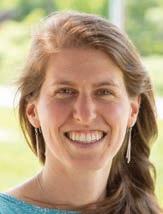

GREEN HOME & LIVING GUIDE 2023-24 | 27
Keri Evjy
Bridget Herring
Sumaya El-Attar
Mary Love
PROFILES
the greater community. Sugar Hollow Solar is working on their B corp certification which they feel is another way to solidify their commitment to being a force for good. Franko grew up in a solar-powered, off-grid home in rural Southern Appalachia. She says, “Over time I realized how incredible it was that I valued & understood the energy we used. It's been most of my life's work to be an educator on the problems with resource extraction and I'm thrilled to be in a career where we offer tangible solutions to reducing our own carbon footprints.”
DON NICHOLSON

Don Nicholson is founder and chief technology officer at Nicholson and SUN, LLC. He is also a research professor in the physics and astronomy department at University of North Carolina Asheville. He holds a Ph.D in theoretical physics as well as a North Carolina contractor’s license. Nicholson is excited to be working with the dedicated people at Nicholson and SUN to complete a net zero neighborhood in Asheville. He is also part of a team working to eliminate the carbon footprint of the Sherrill Center at UNCA and the South Campus at Warren Wilson College. These projects will advance the art and science of net zero building and will share information about climate change. Nicholson says,“ Net Zero residential building is one way that I can contribute to the effort to leave a livable earth for future generations.”

JODY GUOKAS
For 18 years, Jody Goukas has been a home builder and developer. He’s the founder of JAG Construction, a premier contracting firm that focuses on sustainable residential building. Guokas holds a bachelor of arts degree in environmental science from Warren Wilson College. Guokas is excited to be working on the Craggy Park development, which features 45 greenbuilt certified homes in the heart of West Asheville. Craggy Park was an award recipient at the 2019 Environmental Excellence Awards in Asheville. Guokas says, “I feel it’s our responsibility to live in a way that will allow future generations to thrive on this planet. I also find beauty and magic in natural places that have been minimally touched by humans. I believe there is value in preserving these places and environments just for the sake of it.”
CHRISSY BURTON
Chrissy Burton has been a licensed architect for 12 years and has been at her current firm, Fisher Architects, for over four years. Burton describes our environment as “an amazing machine” and says we’re discovering

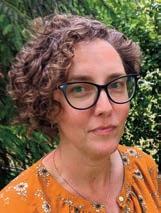
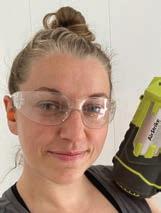

new wonders every day. She wants her work to harmonize with the natural world in an effort to preserve these wonders for future generations. Burton is currently working on an addition and renovation to her home. She says, “I love renovation, preservation, and adaptive reuse. Continuing the life of an existing structure is the most sustainable form of practice in my opinion. When I am working on a renovation, studying and adapting the original design, I feel connected to the long history of the human built world.”
KAT MCREYNOLDS
Kat McReynolds has been a general contractor for three years. Her educational background was originally in business administration before she obtained her general contractor’s license. McReynolds is the owner of Green Room Builders, which specializes in new construction of compact, green built projects, including small multi-family rental homes. She and her team select materials and finishes for durability, sustainability, low maintenance and a minimalist aesthetic.
McReynolds’s first duplex build as a general contractor was also her first certification experience with the Green Built Homes program. She says, “Sustainable building is about meeting our housing needs while putting the least amount of stress on Mother Nature — the best artist, therapist and ancestor we've all got!”
28 | www.GREENBUILT.org eco-sense 828-505-3853 | ecosensedesign.com Guiding Successful Green Building Since 2009 HERS Ratings · Building Science & Testing Duke Energy Rebate Submittals Call Hunter Dendy today for more information.
Kat McReynolds
Jody Guokas
Chrissy Burton
Don Nicholson

GREEN HOME & LIVING GUIDE 2023-24 | 29
Induction Cooktops Countless Reasons to Consider This Technology
 BY MATTHEW VANDE AND AMY MUSSER
BY MATTHEW VANDE AND AMY MUSSER
If you’re concerned about indoor air quality in residential kitchens, you’ve probably heard that gas stoves are going out of style. A new study linked them to one in eight childhood asthma cases, and for decades indoor air quality experts have been listing the numerous pollutants that they generate. But is there an alternative to gas cooking that is actually even better? The answer is yes — electric induction!
Induction cooktops are new, but most people don’t understand exactly how they work or why they’re a vast improvement over traditional cooking methods. This article explains how induction works and why it’s a technology you really need to consider for your own home.
While gas and traditional electric cooktops heat food indirectly by applying an open flame or a hot surface to the bottom of cookware, induction cooktops use electromagnetism to heat the cookware itself. This heats the food more evenly by turning the cookware itself into the source of the heat. Coils located just beneath the cooktop’s elements carry an alternating current, creating a changing magnetic field. When induction-ready cookware is placed in that field, it acts as the second conductor and a current is induced on it. That current is converted to heat inside the cookware, which is then used to cook the food. This is much more efficient than traditional cooking methods.
So, what makes induction cooktops better than other cooktops?
n They are the most controllable option. Unlike other electric stoves, induction responds instantly to changes in setting. For example, you can bring rice to a boil on “high” and then turn it down to simmer on the same burner and get an instant response. And unlike gas, you don’t have to eyeball the flame to avoid boiling over.
n You’re less likely to burn yourself on one. They’re great for people with kids, increasing independence for people aging in place, and for anyone who has ever simply forgotten to turn their cooktop off. The cooking surface heats up a little because a hot pot of food is sitting on it – but it’s not enough to burn you. If you don’t have a pot on the burner, the stove shuts itself off automatically. There’s no open flame or ultra-hot surface that you have to be careful to keep hair and loose clothing away from.
n They’re the easiest to clean. Induction cooktops look like regular glass top ranges, with one crucial difference. Regular glass tops can be hard to clean when you boil food over and it bakes onto the top. Induction cooktop surfaces don’t directly get hot enough for things to burn onto them if something spatters or
boils over. And unlike gas cooktops, there’s no taking the burners apart and fishing out crumbs that fell down in there.
n You don’t need a gigantic kitchen range hood. A lot of the larger gourmet gas ranges require in their installation manuals that you install oversized kitchen range hoods which can cause all sorts of problems. By code, they require a fresh air makeup system. This can add $ 1,000-$2,000 to your project and ironically makes your house less energy efficient.
It’s still important to have a vented range hood to remove contaminants generated by the cooking food itself, but induction cooktops require less ventilation.

n It’s one less reason to have gas or propane in your house. If the goal is to reduce your home’s operational cost, it doesn’t always make sense to pay service charges
for two energy utilities – the service charges can become a significant portion of your energy expense. Take the cost of that gas piping and those monthly service fees and apply that to a really nice induction cooktop. For people with solar, these electric technologies are also easier to directly offset with solar PV or to power from batteries.
n Induction cooktops offer superior indoor air quality performance. The type of cooktop you use won’t change any contaminants generated by the food itself while cooking, but induction cooktops generate far less contaminants themselves. Other non-induction electric cooktops may have burnoff of dust or spilled food that create smoke and generate contaminants. With gas, the flame itself even generates combustion byproducts like nitrogen oxide, carbon monoxide, and formaldehyde, which have demonstrable health impacts. Because induction surfaces don’t get very hot, less of this burn-off occurs.
n They’re more energy efficient. By heating just the pot, induction puts the heat exactly where you need it, using less energy and adding less heat to your home, so you’ll use less air conditioning in the summer.
n The federal government may incentivize you to get one! The Inflation Reduction Act (IRA), the biggest climate bill in U.S. history, offers appliance rebates to households making up to 150% of their local area median income. Those eligible could get up to $840 off the cost of an induction range!
Let’s explore some of the other reasons clients are hesitant about induction:
n It’s new and I don’t understand how it works, therefore I assume it’s bad for you. The scientific principle of induction has been around for a long time. It’s used in motors, generators, transformers, and a lot of rechargeable home electronics items. Because we’ve been cooking on flames for such a long time, it doesn’t scare us. But that doesn’t mean it’s the healthi-

30 | www.GREENBUILT.org
features
Electric induction cooktops are a slamdunk decision, better in almost every way than the other cooking technologies that are out there. VANDEMUSSER DESIGN PHOTOS
est choice.
n I like cooking on gas. I don’t know anyone who has tried induction and not been won over. It does almost everything gas does, only better. A lot of professional chefs have even converted – both at home and in their restaurants.
n I’ll need to get new cookware. It’s very possible some of your cookware is already inductionready – cast iron and stainless steel are great examples. Hold a magnet to the bottom of your pots and pans. If it sticks, it’ll work on induction. And if you do need some new cookware, they are available at all different price points. We’ve had our favorite nonstick induction pans for four years and they still work great, but even better, they only cost us $10 apiece.
n Induction cooktops are expensive. If you’re considering gas, tally up the cost of the gas range, the larger kitchen hood, makeup air for the hood, and the gas piping before you assume that gas is cheaper. There are great induction cooktop/stove options available for as little as $1,200. This com-

pares favorably to the cost of comparable gas ranges including piping, hookup, venting, and makeup air.





n I want to be able to cook when the power is out. Using an outdoor gas (or charcoal) grill is probably the best backup option. Your power is likely coming back on soon, and if your range hood won’t work, you may not want to cook on an indoor gas stove anyway.

Electric induction cooktops are a slam-dunk decision — better in almost every way than the other cooking technologies that are out there. Intrigued? Head to your local appliance store and try it for yourself. You’ll be convinced as well!
Amy Musser and Matthew Vande are the owners of VandeMusser Design, PLLC. They provide Home Energy Rating System (HERS) services, greendesign consultation, and home-energy audits to homeowners in Western North Carolina. Amy is a licensed mechanical engineer and Matt is a licensed architect. Connect with Amy and Matt at vandemusser.com.


GREEN HOME & LIVING GUIDE 2023-24 | 31
GRAMMATICOHOMES.COM
Induction cooktops are the most controllable option, you’re less likely to hurt yourself on one and they’re the easiest to clean.
A-B Tech Elevates Green Building Education
BY SUSANNA SHETLEY
With many public school curriculums moving away from skilled trades, it can be a challenge to find individuals with construction and building-related skills. Additionally, as climate change continues, those entering the construction field need more knowledge on sustainable building and utilizing natural, energy-efficient resources and materials.
Luckily, there appears to be somewhat of a pendulum swing with more community colleges and universities offering degrees, diplomas, and certificates in construction and sustainable building. Asheville-Buncombe Community College offers an array of options for sustainable building education.


Sustainable Programming at the Community College Level
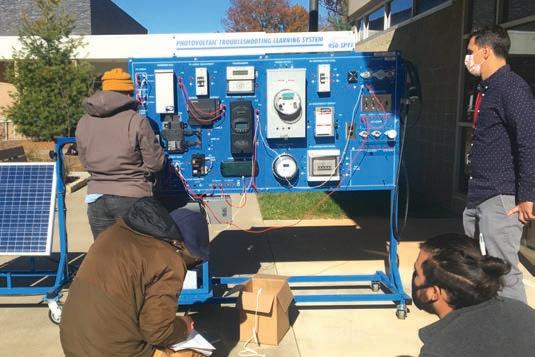
“We run a constant theme of sustainability throughout all of our courses and programs,” said Heath Moody, department chair for construction and sustainability curriculum programs at A-B Tech. “That’s the direction the industry is moving, so all of our classes touch on it but several of our courses are specific to sustainable building.”
The community college offers an associate of applied science (A.A.S) degree in construction management technologies, which prepares individuals to supervise, manage, and inspect construction sites, buildings, and other facilities. Student coursework includes sustainable building and design, print
reading, building codes, estimating, construction materials and methods, and other topics related to design and construction occupations.
Not only are these students eligible for entry-level management positions in traditional commercial and residential construction, they are also eligible for non-traditional construction projects such as large wind turbines and photovoltaic (PV) solar projects.
A second A.A.S. degree is available in the field of sustainability technologies. This is a two-year program centered around sustainability within the energy and construction fields. Students learn and acquire skills associated with renewable energy, energy auditing and green building. A one-year diploma in building construction science is also available. Some of these students transfer into twoyear programs in Construction Management and/or Sustainability Technologies. Some AAS students transfer to a university and attain four-year degrees.
Along with the diploma and associate’s degrees, A-B Tech offers several certificate options related to construction. These include a construction and millwork certificate, a construction management certificate, and a solar photovoltaic certificate.
“Many of our students interested in renewable energy and green building are wanting careers that present solutions to some of society’s biggest challenges. They don’t want careers that contribute to outdated infrastructure which

compound existing problems,” said Moody.
Hands-on Learning and Collaborations
In addition to gaining skills and knowledge in a classroom setting, Asheville-Buncombe Community College offers a number of handson/lab-intensive programs that provide students training with tools, equipment, and materials used in the industry. Three of their carpentry classes (CST-111, CST-112, and CST-113) cover residential construction and advanced framing. These courses use traditional lectures and presentations in class then take that knowledge to the shop where students build small 8-foot-by-8-foot nano structures.
“We build small structures mainly because of time and space,” said Moody. “The small
buildings give the students enough hands-on experience to grasp the concepts and hone their skills with materials and methods for each phase of construction without being too overwhelming. We hope to one day have a building on campus that we can use for these labs.”
A-B Tech PV solar labs are taught alongside a licensed electrician and training modules, using the same brand components and processes as local solar installers. Students learn to read schematics and install the various components as well as mounting systems and other elements. The school recently received a grant to build more solar trainers. The PV certificate enables students to obtain micro-credentials such as a North American Board of Certified Energy Practitioners ( NAB CEP) certification.
32 | www.GREENBUILT.org
features
Other classes offer shadowing opportunities to introduce students to local businesses in construction and sustainability. Some students volunteer with Habitat for Humanity.


“The Asheville Habitat group has agreed to showcase some of our nano-pods at the Habitat Restore, which will be a great exposure for our programs,” said Moody. “The Builders Association of the Blue Ridge Mountains (formerly known as Asheville Home Builders Association) recently raffled two of the nano-structures. Proceeds went to scholarships in trade programs to train for the skilled trades. Our programs have a rich history of these types of collaborations, which truly emphasizes the ‘community’ in community college.”
Looking Ahead
The North Carolina education system is facing post-COVID financial challenges, which typically means austerity and budget cuts for educators and other North Carolina public services. Educators have not received a significant raise since the last recession, which makes it hard to attract teachers into the system. Further, there’s a shortage of skilled trade workers which is problematic in a number of ways.
“Many don’t seem to understand how important these skilled-trade jobs are to keep society moving,” said Moody. “Our curriculum programs in the skilled trades are some of the oldest on campus and helped create the

successful community college AB Tech is today.”
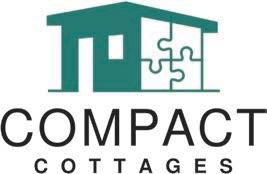
After their time in the program, some students carry their skills directly into employment while others put sweat equity into building their own home or working on renovation projects. Other students become contractors, solar installers, and construction managers.
Many A-B Tech courses transfer to universities such as Western Carolina and Appalachian State. Entering larger institutions as transfer students helps save money and time for those wanting to earn a bachelor’s degree.
“The great thing about community college is the diversity of the student population. We have students of all ages, genders, races and backgrounds,” said Moody. “This adds a lot of value and cross pollination as younger students may be better with newer technologies and older students have a wealth of experience to share. During their time at A-B Tech, students will certainly gain skills but they also gain a valuable network with other students and the industry advocate groups such as Green Built Alliance and the Builders Association of the Blue Ridge Mountains.”
Susanna Shetley is a full-time writer living in Waynesville. She is an award-winning columnist for The Smoky Mountain News and writes for a number of other publications. In 2 019, she published a children's book called “The Jolt Felt Around the World” which encourages children to care for Mother Earth.
GREEN HOME & LIVING GUIDE 2023-24 | 33
Design & Price your own Cottage Online Today! COMPACTCOTTAGES.COM
Love Your Mother
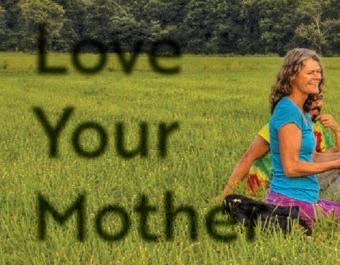
50 States, 50 Stories, and 50 Women United for Climate Justice
BY MALLORY MCDUFF
“Is there anything you’d like to share with your elders?” I asked my two students, pointing to the room with at least 80 adults. “Any words of advice for our generation as we face the climate crisis together?”
At 57 years old, I didn’t consider myself an elder, but I definitely grew up in a different era from my students at Warren Wilson College and my two daughters, now 24 and 17. In the spring of 2023, we gathered at a local winery for the launch of my book Love Your Mother, an event sponsored by the United Way of Asheville-Buncombe County. I’d brought a current and former student with me to share their lens on the climate emergency.
“We’ve grown up hearing all our lives about the urgency of the climate crisis and its impact on our world,” said Catherine Tsarouhtsis, a junior majoring in Environmental Studies and working on food justice at the Warren Wilson College garden. “We need all generations to act, and we don’t have time for uncertainty or despair.”
My former student, Lakyla Hodges, works as an equity and education manager at Southern Appalachian Highlands Conservancy, promoting access to youth programming outdoors. She emphasized the role of working with diverse communities. “Once you bring the community with you, you start caring more about everything around you,” she said.

I wrote this book, featuring the stories of one woman from every U.S. state working for climate justice, for my students and my daughters. I wanted to research climate stories from Alaska to Arkansas, from Maryland to Mississippi. Climate justice and social justice are interconnected because climate change disproportionately affects
marginalized and vulnerable communities, which often have fewer resources to adapt to or mitigate the impacts of climate change.
In simplest terms, climate justice is about access to a healthy environment for all. Across the globe, women and girls represent 80 percent of those displaced by the climate crisis: But women are building innovative climate leadership through communication, collaboration and community. What I found in my research were women from diverse vocations: scientists, students, poets, sculptors, community organizers, politicians and more. Half of the women in my book are BIPOC ( Black, Indigenous, and People of Color). Their life stories showed me how individual acts can generate collective climate momentum. Here are a few of the ways women are leading on climate:
Climate Communications Consultant — Alabama
Growing up in a prominent evangelical family, Anna Jane Joyner mentored several of my students when she worked in Western North Carolina with the faith-based Creation Care Alliance. She now lives in coastal Alabama, where I also grew up, at ground zero of the climate emergency, given the increased frequency and severity of hurricanes in the Gulf Coast. In response, she founded an organization called Good Energy, which aims to increase the accuracy and relevance of storylines about climate in Hollywood TV and movie scripts.
“Where did most people learn about World War II?” she asked me. “From films and movies.” She argues that in five years, movies that don’t depict climate in some way will feel irrelevant and out-
dated. Her team has found support from Bloomberg Philanthropies and actors like Mark Ruffalo and has written a free guidebook for screenwriting in the age of climate change called the Good Energy Playbook.
Electrical Engineer — Kansas
Volunteering with the Boys and Girls Club in Kansas City, Pooja Shah connected an electrical bulb to a solar panel to show middle school students how to generate energy from renewable resources. As an electrical engineer for one of the largest construction and engineering companies in North America, she mentors young people in STEM and also works to increase renewable energy for some of the largest energy projects in the US, building systems that could power 300,000 to 500,000 homes.
“Solar and renewables are not just the right thing to do, but the economical thing to do,” she told me. Her home in Kansas City is far from where she grew up in the western part of India in the state of Gujarat. Yet, electrifying the economy with renewable energy, rather than coal or natural gas, is one step toward confronting the climate crisis across the globe. In her work, she focuses on equity, such as how to make electrified vehicles accessible through public transit and school buses.
Farmer, Birth Doula, Restaurant Owner — Kentucky

Tiffany Bellfield-El-Amin works across rural eastern Kentucky to help Black farmers grow collective entrepreneurial strength as well as local food. She’s a third-generation Black farmer in a state with only 600 Black-owned agricultural businesses — less than two percent of all Kentucky farmers. In her work
with Community Farm Alliance as a food justice organizer, she provides technical assistance to help Black farmers adapt to the climate crisis with resilient food systems, which isn’t easy given the extreme weather caused by global warming.
“My great-great-grandfather was a slave,” she said. “My grandfather’s family owned land and farmed tobacco. Now I’m partowner of 26 acres, where I grow herbs, edible flowers and pollinator-specific plants.” In meetings, she is often the only Black farmer and woman at the table, she told me, but she uses her voice to ensure access to resources and justice for all.
•••
Sharing these stories with my students and my daughters has changed me; I feel more connected to others who are working to create a healthy environment for us all. It’s overwhelming to know that only 100 companies contribute 71 percent of global greenhouse gas emissions. But one of the most important things we can do about the climate crisis is to talk about it with our friends and neighbors. In addition to communicating about climate, we can collaborate with others in our communities to act and amplify the message: We are in a climate crisis. It is late, but it is not too late. This is a love story of community, and it isn’t over yet.
Mallory McDuff is the author of five books including Love Your Mother: 50 states, 50 stories, and 50 women united for climate justice and Our Last Best Act: Planning for the end of our lives to protect the people and places we love. She teaches environmental education at Warren Wilson College in Asheville.
34 | www.GREENBUILT.org
An outdoor class at Warren Wilson College. WARREN WILSON COLLEGE PHOTO
features



GREEN HOME & LIVING GUIDE 2023-24 | 35 31 Meadow Rd, Asheville & 61 Weaver Blvd, Weaverville // ashevillehabitat.org/restore
visit is a new opportunity to support affordable housing Shop new and used building supplies, appliances, furniture & more Donate new and used items in good condition Deconstruct Hire our skilled Deconstruction team
every
Greener Remodeling Choices

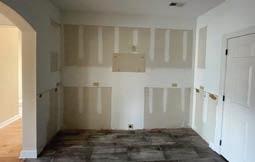
Going Green Can Help You Save Green
are even local nonprofits that will actually do the deconstruction for you. They will come in with a team of experienced volunteers, and remove all the items that you want to donate. Items will typically be removed from your house and put up for sale the same day. Since these nonprofits utilize volunteers and resell the removed items, this service is very inexpensive. By deconstructing and donating, you’re helping other families save money, reducing construction waste, and supporting the cause that makes it happen.
Local businesses that sell reused building materials
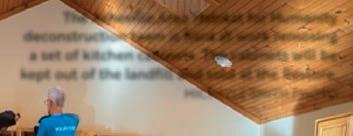
n Coats Surplus
n Hill Top Barn Wood Shop
n Scroungers Paradise
n Old Town Salvage Company
n Asheville Area Habitat for Humanity Restore
BY COLIN BRISTOW
Did you know that construction waste is the top type of waste added to any landfill? According to a 2018 EPA study, “the construction industry contributed more than 600 million tons of waste to landfills, and of that 600 million, 90% was contributed from demolitions.”
During a remodel, however, there are a couple of easy solutions that can reduce this waste and save costs. When removing what is currently in your home, follow the three D’s to reduce waste and save money: deconstruct, donate and deduct. Shopping for used items for your remodel will cost less than new items and save waste from the landfill, and in turn, your removed items can help another homeowner save money.
Deconstruct: We have all seen those remodel shows where they take a sledgehammer to a perfectly good cabinet set. It makes for some great television, but if you are like me, it hurts to watch reusable items be destroyed. Instead, you can choose deconstruction rather than demolition. Deconstruction is a process where items will be carefully removed from a home so they can be reused. There are so many items from a home remodel that can be saved and reused: kitchen cabinets, bathroom vanities, doors, windows, light fixtures, and more.
Any item that can be removed in good condition can be reused on another project. This will even make your remodel project more cost effective by reducing dumpster costs.

Donate: Once items are removed from homes they can be donated to local nonprofits to be sold to the public. Most local nonprofits that sell construction materials, such as Habitat for Humanity, will have a pickup service. So once the items have been removed from the house all you need to do is call and they will pick the items up and take them to their resale stores. There
Deduct: Did you know if you donate the items removed to a local non-profit, that donation becomes tax deductible? You will be able to save on your taxes during your remodel. When the value of your donation exceeds $5,000, you will be able to fill out a form 8283 for noncash charitable contributions. You can determine the value of items that you donated by working with a tax professional.
When it comes time to purchase for your remodel, consider the more environmentally conscious approach. Shop around for great used items looking for a new home. Check out your local nonprofits that sell reclaimed building materials like bathroom vanities, kitchen cabinet sets, doors, and appliances. It can add to the excitement of your remodel, as there are some real hidden gems at

these stores. When you purchase from one of these nonprofits, not only will you save lots but you will help move their mission forward with your purchase. The items that you buy for your remodel will then also be kept out of the landfill so you can feel good about knowing you have helped give a second life to items that may have otherwise ended up in the dump.
We can all make an impact on the environment with our choices. Let your remodel be greener for you and the environment.
Colin is the Deconstruction supervisor for the Asheville Area Habitat for Humanity. For more information about deconstruction or purchasing reclaimed materials connect with Colin at Cbristow@ashevillehabitat.org

36 | www.GREENBUILT.org
features
The Asheville Area Habitat for Humanity deconstruction team is hard at work removing a set of kitchen cabinets. The cabinets will be kept out of the landfill and sold at the Restore.
MICHELLE SMITH PHOTO
A kitchen cabinet set for sale at the Asheville Area Habitat for Humanity ReStore. This kitchen was removed by their deconstruction team.
COLIN BRISTOW PHOTO
A before and after of a kitchen removed by Asheville Area Habitat for Humanity deconstruction team.
COLIN BRISTOW PHOTOS

Circularity in Construction A Contractor’s Introductory Guide to Incorporating Circularity
BY CHRISTINE DAVIS
Circularity in the built environment aims to minimize waste and maximize the life of materials by keeping them in use — or circulating them — for as long as possible. The concept of a circular economy highlights the shift away from the current linear model of consumption, which follows the process of take-makewaste — where materials are extracted, produced, and then thrown out after initial use — and rather towards recirculating materials — where products are maintained, reused, repaired or recycled. This approach helps to decrease the amount of waste generated, conserve resources, and reduce the environmental impact of production and consumption.
The Ellen MacArthur Foundation has visualized the circular
economy principles through their butterfly diagram depicted to the right. The right side of this diagram shown in blue, known as the technical side, is most relevant for contractors as it depicts products that are used rather than consumed. This diagram also illustrates a clear hierarchy with maintaining/prolonging use being the highest value, followed by reuse/redistribution, refurbishing/remanufacturing and finally recycling.
The construction industry has a unique opportunity to make a significant impact on the circular economy, given its high use of resources and amount of waste generated. According to 2018 EPA estimates, construction and demolition waste accounted for more than double the amount of municipal solid waste (i.e., household trash) in the United States. But
as all contractors know, the construction world is centered around time and money. Therefore, when it comes to rethinking “waste” as a valuable resource, successful implementation of circular practices requires integrating these best practices into existing processes. The strategies explored below are categorized by construction phases and intended to be an introduction for potential best practices to incorporate circularity.
Preconstruction
Preconstruction strategies should be considered as early as possible during the design phase to maximize efficacy, avoid budgetary surprises, and minimize rework. Therefore, delivery models where contractors are involved in the preconstruction phases are most likely to be successful in meeting circularity goals. Examples of strategies include:
n Salvage assessment: For all projects involving demolition (full or partial), complete an assessment of the areas to be demolished and provide an inventory of salvageable materials to the design team for consideration in the new design. For materials not included in the new design, explore reuse markets, local donation centers, and manufacturer take-back (or extended producer responsibility) programs.
n Circularity pricing lens: During pricing phases, add a circularity lens to value engineering exercises. Although this may require considering trade-offs between value engineering and circularity, many times these approaches align. Some examples of considerations include:
•Ask subcontractors if there are ways to be more efficient from a material standpoint. Is there a lot of waste (and wasted time) from inefficient cuts that can be reduced with standard dimensions?
•Identify details where finishes could be deleted, providing a simpler finish schedule and reducing material demands.
•Identify opportunities to use materials from reuse markets, decreasing material cost and production while also support-
ing local small businesses.
•Review the plans for any components that could be assembled offsite, reducing waste and maximizing labor efficiency onsite. For example, consider pricing panelized walls as an option. The additional material cost may be offset by decreased labor cost or overall schedule savings.

•Identify opportunities that will improve chances of future disassembly. For example, use mechanically fastened systems in lieu of glues and adhesives when possible.
n Construction and demolition waste management plan: Develop a waste management plan early so that it can be coordinated with the job-site logistics plan and project schedule. Considerations for successful waste management include:
•Source separation drastically increases the reuse and recyclability potential of materials. Separate material types out into individual bins as much as possible.
•Demolition can oftentimes generate a larger amount of waste than new construction. Complete a salvage assessment and carefully consider strategies to reduce demolition rubble taken to landfill, such as identifying materials that can be deconstructed and reclaimed or sent back to manufacturers through a take-back program. Ceiling tiles and carpeting are examples of products that may be part of these take-back programs.
•For new construction waste, identify how each type of material will be handled in the instance of waste generated or surplus material. Consider this in the context of the project schedule and logistics.
•Include the waste management plan or relevant sections as part of the pricing requests to subcontractors, ensuring everyone is set up for success and understands the expectations.
n End of use plan: Ask the design team and/or owner about the project’s end of use plan. For example,
38 | www.GREENBUILT.org
features
Installing panelized wall systems. CHRISTINE DAVIS PHOTO
are interior finishes expected to be updated every 7-10 years and if so, has disassembly been considered in the design? Understanding how the owner will use and update the space will help ensure those expectations are implemented in construction.
Construction
Ideally, the bulk of circularity planning has been completed before this phase. The construction phase focuses instead on the tracking and implementation of those preconstruction plans.
n Construction and demolition waste management plan: Continuously track waste monthly and analyze progress towards the waste management goals. Use a spreadsheet to track hauling tickets for all materials leaving the site and identify which materials were diverted from landfill vs which materials were sent to landfill.
n Procurement of materials: Ensure the correct materials coordinated in the preconstruction phase are purchased and installed. If availability issues arise, ensure alternative products meet circularity goals. Collect relevant product data, install instructions, material ingredient disclosures, etc.

n End of use plan: Throughout the construction phase, track changes and/or add helpful redline notes to the drawings that would assist with future disassembly.
Closeout
The closeout phase of a project includes turning the building over and submitting relevant documentation to the owner.
n Construction and demolition waste management plan: Calculate
the final project waste diverted from landfill as a percentage of the total waste generated and hauled offsite. Identify any challenges or reasons why the implementation may have varied from the waste management plan to track lessons learned.
n End of use plan: Ensure any tracking notes from the end of use plan are incorporated in the owner’s as-built drawing set. In the closeout packet, document in-
stalled products through approved submittals and include relevant backup documentation required for future materials that are eligible for manufacturer takeback programs.
In summary, adopting circular economy principles in construction practices can help to reduce waste, conserve resources and promote sustainable building practices. It is important to consider this approach in the preconstruction phase, as it has the greatest potential to reduce the environmental impact of construction. In addition, implementing circularity best practices introduces other benefits such as increasing client services, supporting the local economy by circulating valuable materials, and promoting a more sustainable future.
Christine Davis works on LEED development at the U.S. Green Building Council. Her previous experience includes project management on a variety of commercial construction projects, from small renovations to high-rise new construction. The views expressed in this article are her own and independent of her work at USGBC.

GREEN HOME & LIVING GUIDE 2023-24 | 39
Building for Everyone
Asheville Habitat Adapts to Changing Housing Needs
BY ARIANE KJELLQUIST
Adapting to a community’s changing housing needs is critical for a non-profit focused on ensuring everyone has a decent place to call home. As land costs soar, the population ages, affordable rentals remain scarce, residents leave in search of cheaper housing options, and historically Black neighborhoods are re-developed, Asheville Area Habitat for Humanity (AAHH) has responded with new products and programs to address evolving needs and help increase access to stable and affordable housing.
In 2010, we introduced an affordable Home Repair program that preserves the character, affordability and diversity in our community and allows long-time residents to stay in their most affordable option — the home they already own, and avoid being priced out of the community they know and love. Our affordable repair program makes it possible for homeowners to complete repairs that had financially been out of reach. We fix leaky roofs, install ramps and replace heating systems for a low one-time fee, enabling existing homeowners to live more safely, comfortably and with dignity. Asheville Habitat’s average repair job costs $7,000 to complete, for which the homeowner pays a small amount. The average homeowner Partner Fee is $190, or 10% of their average monthly income. The fee is waived for repair jobs with a scope of work worth less than $1,500. Today, 75%
of the families served through Asheville Habitat are repair clients. For decades, AAHH, along with most Habitats around the country, only built Arts & Crafts-style detached single-family homes. In 2019, Asheville Habitat successfully introduced two-story town-

to many families, and the units offer less yard to maintain while still providing some outdoor space.
The organization’s largest and most ambitious neighborhood todate, New Heights in West Asheville, has taken product diversification even further. This multi-
Aging in Place (AIP) units, singlelevel townhomes specifically designed for adults age 55+ and made possible with generous support from local retirement community Deerfield and its Charitable Foundation. Older adults comprise 21% of Buncombe

homes in a small community in Candler. Now a mainstay in current and future developments, this housing type enables Habitat to serve more families on the available land. For homebuyers, the 2and 3- bedroom townhomes offer slightly more square footage than their single-family counterparts, the multi-floor layout is desirable
generational community includes detached single-family homes, two-story townhomes, single-level townhomes specifically designed for aging adults (55+), and walkout townhomes. Upon completion, 98 households of all ages, stages of life, and backgrounds will call this community home.
Eight homes in New Heights are
County’s population but have limited access to affordable housing options designed to meet their needs. “Every time I had an increase in income, there was a greater increase in the cost of housing. I had pretty much given up hope that I would ever be able to buy a house… I saw this program as a way to age in place in a safe

40 | www.GREENBUILT.org
features
Neighbors in New Heights feel a strong sense of community, sharing books in the Little Free Library, gathering for potlucks, and more. ASHEVILLE AREA HABITAT FOR HUMANITY PHOTO
community with safe and decent housing,” shared Kay Ponder, a first-time homebuyer at age 60.
Habitat brought together a group of stakeholders including experts in Universal Design and elder care to identify key elements and develop a product that would suit the needs of aging adults. Then TightLines Designs, an architectural firm out of Raleigh, designed the 744-square—foot AIP units using eco-friendly building systems which helps make this housing model an affordable and sustainable housing solution for the homeowners.
Asheville Habitat’s AIP model was recently recognized as “2023 Best in Accessibility” in Habitat for Humanity International’s 2023 Housing Design Contest. Each unit is one-level living that includes a full bath, kitchen, laundry, living space and 1-bedroom, as well as a bonus living space in the front of the home that if needed, could be closed off in the future for an inhome caregiver. These units are built on a slab rather than a crawlspace, which guarantees an atgrade or ramped entrance to the main floor, as well as a ½-inch maximum threshold between porches and finished floor of living units. All doors and openings are 36-inches wide and each hallway is 44-inches wide. Each unit has a bathroom that will accommodate a wheelchair within a 5-inch radius circle and a roll-in shower. Lever door handles are installed rather than the traditional knob styles, making it easier for aging hands to grasp.
Like all Asheville Habitat houses, these homes are Green Built Home certified, a program administered by Green Built Alliance. In fact, the AIP units are the most energy-efficient of all the models built by Asheville Habitat today. Construction Administrator



Sumaya El-Attar shared, “One of the main differences between AAHH’s other house models and the AIP model is that this unit is heated and cooled by a ductless Mini Split system, rather than a conventional heat pump. This method of heating and cooling is a space saver for such a small footprint. As with AAHH’s other housing models, an HRV (Heat Recovery Ventilating Unit) is used to balance the indoor ventilation, while removing excess moisture.” She added, “To date, the AIP unit has been the only AAHH model to achieve gold level Green Built Home certification.”
Across the street from the AIP units is another new housing model, walk-out townhomes. A common challenge to builders in the Blue Ridge Mountains is steep terrain. Seeking a sustainable building approach to serve more families, Asheville Habitat asked Robin Raines, of Rowhouse Architects, to modify a current twostory townhome design to fit the mountainous landscape. In the revised design, the main living level is accessible from the street, and the bedrooms are located on the lower level. The house is built on a slab at grade and eliminates the need for a crawlspace. El-Attar said, “Rowhouse’s design resulted in reduced cost of grading and lessened the environmental impact, while giving these townhomes a vernacular cottage-style aesthetic.”
In addition to expanding products, the organization has expanded its geographic service area. Asheville Area Habitat for Humanity and Madison County Habitat for Humanity joined forces to strengthen Habitat for Humanity in our region. As a combined organization serving Buncombe and Madison Counties, more families will be served with life-changing
homeownership and home repair programs in the coming years.

Furthermore, Asheville Habitat regularly reviews policies and when possible, makes changes to eliminate or reduce barriers. For example, more low-income homeowners were able to afford home repair when the pricing policy changed from a sliding scale to a one-time low fee. Asheville Habitat also advocates for inclusive housing policies and programs at the local and state level, as advocacy is an important tool for ensuring everyone has access to de-
*Housing Needs AssessmentWNC (2021) estimates the need for additional for sale housing units affordable to households <80% AMI in Madison and Buncombe Counties at 1,770 homes. American Housing Survey estimates 3% of all U.S. owner-occupied housing units have moderate to severe quality deficits. This equates to 6,114 units homes in need of repair in Madison and Buncombe counties.
cent housing.
With four decades of experience, today’s diverse product portfolio, and a vision for the future, Asheville Habitat is well-positioned to serve our region’s affordable housing needs. Between 2018 and 2028, the organization will serve 1,000 families, addressing 10% of our region’s affordable homeownership and repair needs.* A key factor in achieving this goal will be continued adaptability. “We don’t know what the next iteration of innovation looks like yet, but we know we’ll continue to adapt our programs and products to ensure more neighbors have access to stable, affordable housing,” concluded Andy Barnett, Executive Director.
Ariane Kjellquist is the communications director for Asheville Area Habitat for Humanity. She has worked since 2006 for the local nonprofit, which builds and repairs homes, operates two ReStores and a deconstruction service, and advocates for inclusive housing policies. Connect with Ariane at ashevillehabitat.org.
GREEN HOME & LIVING GUIDE 2023-24 | 41
With four house models, Asheville Habitat’s New Heights neighborhood reflects the changing housing needs of the community.
Is Going “Green” the Way to Go?
BY SEAN SULLIVAN
Today many builders and home buyers are concerned about preserving the environment. With increased attention on the condition of our planet, “green building” has become a popular choice for homeowners, especially in our market.
But what does green building mean? In its simplest terms, green building is making your home the best it can be. It means increasing your home’s efficiency so it makes better use of things like water, energy, temperature control, and construction materials. It’s about using resources effectively so you
built green and green homes are worth more than non-certified green homes.
To answer the other question, let’s take a look at a few things you can do to make your home more environmentally friendly.
Heating and Cooling Equipment
One of the most important things you can do to make your home more “green” is to carefully consider your choice of heating and cooling equipment. The heating/air conditioning system should be built and installed with the highest SEER (Seasonal Energy Ef-
Insulation
If it’s within your budget, one great option is to have your home insulated with a CARB II compliant foam product. When installed correctly, the foam can be quite effective. On top of the good R-values (a term used to measure how well insulation resists the flow of heat or cold through it) foam can fill cracks and crevices in ways that traditional insulation can’t. If a foam product can’t be used, great care should be exercised to make sure the installation is done to eliminate as many gaps and penetrations as possible.
Home Orientation
To reduce energy loads, it’s important to design and position the house in such a way as to minimize exposure to the hot sun while taking advantage of cooling breezes. Whenever possible, the front door or the house’s longest wall should be set to within 5 degrees of true south. It may also be important to landscape in such a way to create windbreaks for the home or create shade to increase efficiency. Good window placement can increase natural light while reducing the need for electric lighting. These decisions are taken into account when designing a home for passive heating and cooling.
Windows and Doors
and creating a healthy indoor air environment.
While building an environmentally friendly home sounds good to most people, they usually want to know two things: what can I do and how much will it cost? Let’s address the last question first.
You may have heard that building green is more expensive. While that may be true in some instances, it doesn’t have to be. In today’s market some elements of green building can cost more initially, but many do not, and some even cost less. Factor in energy savings over time and the increased durability of many of the green building products, and any additional upfront cost becomes much easier to justify. Also, some mortgage companies now offer reduced mortgage rates to homes
ficiency Ratio) rating possible. The greater the SEER rating, the more energy efficient your unit will be.

The system should also be sized appropriately to effectively cool or heat your home without being oversized. In fact, it is often better to err on the side of being undersized by half a ton than oversized. (Note: A “ton” is a unit of energy used to measure output. Typically you need about one ton of output for every 400 square feet of your home). Many builders don’t recommend that you oversize the tonnage of your home’s AC system. The most efficient homes often run on a system designed to be 10 percent smaller than typical installations. A good air system could also be installed with as few bends and connections in the duct work as possible to minimize the risk of gaps and voids.
Windows help make a home beautiful but they can also waste a lot of energy if they let heat in during the summer, cold in the winter, and drafts anytime. To get more energy-efficient windows, select ones with good insulation values. Some have special coatings that can help repel heat. Others are double or triple-pane which helps insulation. Some energy-efficient windows have non-toxic gas between the panes such as argon or krypton that provide better insulation than air. Even the window frames can affect how efficient they are. For example, aluminum frames typically provide the lowest insulation level. Wood, vinyl and fiberglass are better. Warmedge spacers are even better. Certain window coverings like reflective blinds and shades can also generate incredible savings on energy usage. When it comes to doors, make sure they have a tight
fit and use excellent weather stripping. Some new door frames include a magnetic strip that creates a tighter seal and reduces the amount of air that leaks out. Some of the best core materials for a door include fiberglass and foam. If a door has glass, it will become more energy efficient if double or triple-pane insulating glass is used. To get the best performance, only use products that are NFRC rated.
Roofing and Exterior Paint
Consider using reflective roofing and lighter exterior paint colors. These two items offer a cooler home by reflecting the sun’s rays rather than absorbing them. Roof choices (reflective) and lighter paint colors can create double digit drops in exterior surface temperatures which can result in greater energy savings.

Building Materials
Choose to use “earth-friendly” products and building materials whenever possible. Typically, try to look for:

n Products made with recycled materials
n Products that are natural to the environment
n Products that avoid toxic emissions
n Products that are rapidly renewable such as bamboo, cork and straw
n Non-exotic hardwoods (avoid mahogany or IPE)
Water Systems
Consider installing Energy Star rated appliances like dishwashers and laundry machines. Energy Star is a program backed by the government that identifies products with high energy efficiency. These products often last longer and are more economical to operate than non-Energy Star rated appliances.
Sean D. Sullivan is an Accredited Master Builder and president of Living Stone Design+Build. He and his wife, Laura K. Sullivan of ID.ology Interiors & Design, have combined their passion for quality and green living by launching a 2 0,000 -square-foot studio — Atelier Maison Co. — featuring healthy furnishings. Connect with Sean at livingstonedesignbuild.com.
42 | www.GREENBUILT.org
features
This home is built with “earthfriendly” products and building materials to promote sustainability.
RYAN THEEDE PHOTO





GREEN HOME & LIVING GUIDE 2023-24 | 43 SOUTHLIGHTBUILDERS.COM | 828.775.8665
Duplexes are currently one of the easiest missing middle projects to undertake, because they do not require fire sprinklers and do not trigger some of the regulations applicable to larger multi-family projects.
Searching for Missing Middle Local Study Aims to Encourage Small Multi-Family Housing
BY KAT MCREYNOLDS
Coined by Opticos Design, the term “missing middle” refers to “house-scale buildings with multiple units in walkable neighborhoods.” Duplexes, triplexes and townhomes are great examples, as are small apartment buildings and accessory dwelling units. In essence, anything sized between a single-family home and apartment complex can qualify.
Historically, these configurations were far more prevalent in neighborhoods across America. But housing and zoning codes, including those originally aimed at racial segregation, have caused a steady decline in missing middle projects for decades.
Fortunately, some municipalities are looking for ways to revive this dwindling housing type. The
City of Asheville is among them, having allocated $115 ,000 towards a 2023 study that will gather stakeholder feedback and scour local ordinances for ways to better promote missing middle developments.
Why all the hype?
As cities work to encourage missing middle construction, it begs the question: What makes it such a desirable housing solution? It’s not just one selling point, but a variety of advantages for different stakeholders — and the planet.
As climate concerns continue to inform building techniques, multi-family projects show a few distinct advantages with respect to sustainability. Of course, upgrades like thicker insulation,
tighter envelopes, efficient appliances and low-flow plumbing fixtures can be incorporated, just as they would be with a single-family build. But the multi-family layout also offers a compact footprint and shared walls – both of which significantly reduce energy use year-round.
The site itself is similarly efficient, fitting housing for multiple families or individuals onto one lot, thereby reducing urban sprawl and its domino effects. Due to their small scope, missing middle projects often fit nicely into existing, walkable neighborhoods, putting residents near amenities and jobs, and allowing the area to grow incrementally instead of abruptly. This is particularly important in a place like Asheville, where buildable lots are scarce but demand for housing continues to swell. Missing middle developments house more people on what little land is vacant.
Although it isn’t usually as affordable as a subsidized project or large complex, missing middle
More:
www.ashevillenc.gov/projects/m issing-middle-housing-study
housing does strike a balance. Even when priced at full market rate, small multi-family homes are typically less expensive than a comparable single-family home would be. They are also often managed by mom-and-pop landlords — whose money is more likely to recirculate in the local economy — compared to remote, corporate landlords. Anecdotally speaking, small-time landlords may be slower to raise rents over time, as they are not always driven solely by profit or answering to shareholders.
From the city’s perspective, the density of a missing middle project can generate significantly more tax revenue per acre than one home. And perhaps more importantly, infill projects make use of existing infrastructure like sewer mains, water mains and roads. This mitigates the municipality’s maintenance costs in perpetuity, which is a major win for any community’s long-term finances.
What’s next?
With all of its benefits, small multi-family construction is not absent by coincidence. Even in areas zoned for multi-family, significant barriers exist that hinder these projects. Some — most notably sprinkler requirements — are coming from the state level. Others are buried in Asheville’s development ordinances, including strict multi-family design and setback rules, questionable commercial lot requirements, poor availability of separate water meters for multi-family residents, excessive regulation of townhomes, and much more.
As Opticos undertakes its study, the research team will focus on local changes that could encourage more missing middle housing in our neighborhoods. But once city leaders get the list of suggested code tweaks, it will take popular support to see those changes adopted and put into policy. Interested individuals can track progress of the missing middle study and learn about opportunities for public input at the link below.
Kat McReynolds is owner of Green Room Builders, which specializes in new construction of compact, green built projects, including small multi-family rental homes. We select materials and finishes for durability, sustainability, low maintenance and a minimalist aesthetic.

44 | www.GREENBUILT.org
features
SAGE TURNER PHOTO
Adventure Within the A-Frame
The Alphabet of Design Begins with A
BY SCOTT MCGEHEE
Time has brought about an advent of architectural styles that vary by designer, region, cost and a multitude of other factors. However, one style outperforms all through its ability to contrive a detailed and consistent visualization of itself through its name alone: the A-Frame. The A-Frame not only resembles a nostalgia we have yet to experience, it also conceals a cluster of creativity within its design and engineering practices. To uncover the magic hidden within the familiar triangle, it is important to first examine the events that led to its public notoriety.
Following the triumphant end of World War II, a seed bloomed inside the average middle class American. An agenda — with equal parts want, need and a dash of desire — fueled a mindset of owning seconds. A second car, a second fridge, and most importantly, a second home. At the beginning of the baby boom, more of the general public began seeking out a vacation home due to a narrative encouraged by advertisements, storefronts and magazines. The idea of leisure in one’s lifestyle ignited an uprising in the vacation aesthetic, flooding the design homefront with ways to rethink the cabin and cottage.
As traction grew in the 1950s, the A-Frame began to boast its adaptability in any setting. Even when placed in various surroundings, from mountainous slopes to coastal shorelines, the structure retained a universal familiarity — an aesthetic that was complemented by its uniqueness, affordability, and ease of construction. Ordinarily, if two roof pieces were placed on the ground, pushing against one another, it signified a hut, a shed, a farming storage, or a peasant’s quarters, but this newfound acceptance of the simple shape denounced its stigma. The A-Frame boom was further sustained by lumber yards, the building industry, and postwar architects, who breathed new life into the structure we know today.
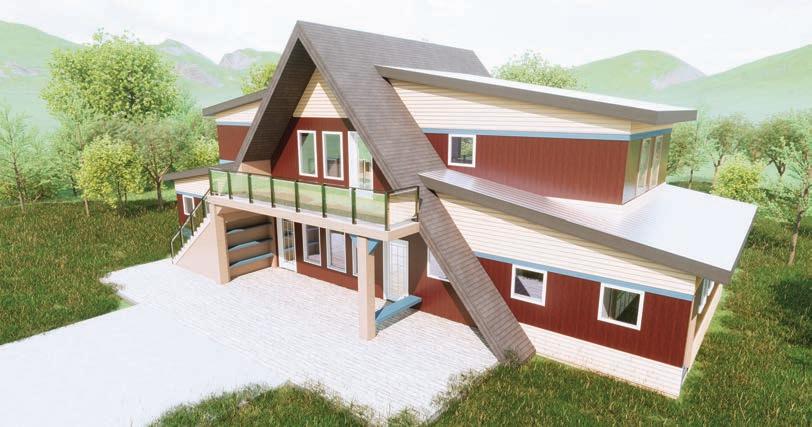
In home design, the idea to slanted exterior walls, suggesting an implied fate of falling, must allude to a greater benefit. The
schematic design process for an A-Frame begins with the determination of what spaces to include where the slanted ‘roof walls’ intersect each gable end wall. Essentially, we are asking: “what rooms in this dwelling are to make a statement?” First to the finish line is typically the general living and gathering space, shortly followed by the primary suite. Each space leaves the user with the intimate sentiment of belonging within the sloped walls, swapping
ponents (top-left rafter, top-right rafter, and bottom floor joist) create a primitive truss and institute an elegant solution in strength. However, this noble configuration faces a major opponent: the typical lumber length needed to assemble the triangle without splicing exceeds the conventional length stocked at lumber yards. Although it is standard practice to splice rafters under structural supports, doing so in an A-Frame unravels its inert stability found
additional barrier to the acceptance of the A-Frame is its perceived natural setting. The average consumer visualizes an A-Frame on a mountainside, at the end of a serpentine road, without even the scent of another house in sight. They don’t picture it next to a townhome or sitting on a busy side street in the city. Rather, they tell the story of a metaphorical unicorn; a sight only seen during a rare road trip vacation. However, Asheville is home to mountains
out commonality for adventure. Rooms where straight and plumb walls are most necessary become positioned away from the sloped walls, and include the kitchen, bathrooms, storage areas and closets. An A-Frame design asks one to step out of their comfort zone, challenging our senses and igniting innovation in the residential architecture community. In addition, the structural mechanics of the AFrame are equally unique.
If time rewound back to the prehistoric ages, where homes were either a simple shelter or a spacious cave, building in the shape of a triangle would prove wiser than that of the common square. Fundamentally, the triangle is the most stable shape. Within an A-Frame are sloped roof rafters, attached at each end through nails or bolts to a bottom horizontal floor joist. The connection of these three structural com-
through the connection of these three members. An unspliced rafter that is secured to a floor joist will satisfy its desire to push itself away from the structure (thrust) through its connection to the floor joist. A spliced rafter will degrade this stability and will require further structural detailing to relieve its rebellious state. Despite a healthy dose of benefits, the AFrame has not found its way into modern culture alongside other common residential architecture trends.
Many of us live inside a product, not a home. These two words have substantially different meanings — built with or without the homeowner in mind. The construction practices for an A-Frame can follow a path of non-standardization and demand creativity for maximizing the interior space inside. Such complexities reduce its selection in the marketplace. An
that can warmly embrace the AFrame, this familiar friend of the foothills. Coupled with the ever changing state of residential architecture, perhaps the benefits of the triangular structure will create a shift in public perception. Where once the A-Frame was strictly meant for recreation, it can instead be a home.
Paper Fox Collective is led by Scott McGehee, a licensed professional engineer with a passion for home design. Through the combination of his knowledge and experience in the fields of residential design and structural engineering, Scott is able to provide a practical and effective design solution.
Check out a few of Scott’s AFrame designs that breathe life into the iconic style, adding practicality and applicability into the familiar shape.
www.paperfoxcollective.com
GREEN HOME & LIVING GUIDE 2023-24 | 45
Custom Designed A-Frame by Paper Fox Collective, PLLC. SCOTT MCGEHEE OF PAPER FOX COLLECTIVE IMAGE
Net Zero Ground Zero Notes from the Climate Battle
BY DON NICHOLSON
The burning of fossil fuels threatens the viability of the human, animal and plant kingdoms. There is broad support for the electrification of homes and the greening of the grid, or electric generation without fossil fuels, but support for this approach relies on the continuation of decreasing costs for renewables and batteries. In addition, growing demand for electric vehicles means that energy production must rise to charge those vehicles. Clearly, a tremendous investment in electric generation, transmission and energy storage will be needed. So what role do home builders play? What are the choices and challenges we face?
Builders are searching for rational approaches to the complex issues of balancing solar, batteries, and energy efficiency. They are even attempting to consider the carbon footprint of building materials (embodied carbon) and other items brought into the home (scope three carbon). These carbon sources are difficult to evalu-
ate and measure, though they could be reduced by a carbon fee and dividend program, as proposed by the Citizens’ Climate Lobby. Builders therefore should seriously consider a Green Built Homes Net Zero certified home, which reduces negative impact by reducing the amount of electric energy that must be generated and transported. How? Through effectively using insulation, heat pumps and solar to improve energy efficiency.

Utility net metering charges are changing, making rooftop solar less financially attractive and further elevating the importance of insulation and heat pumps. Since solar panel systems are not always an option, most homes still require energy transmission infrastructure and don’t necessarily reduce the amount of new energy generation required to meet peak demand. Therefore, you might think of insulation and heat pumps as our first defense against excessive energy usage, or as the main course and solar as the dessert to be enjoyed when available (see Figure 1).
“You can’t have dessert if you don’t eat your dinner!”
Builders should pay extra attention to the design of their building envelopes. The envelope is like human skin; it controls the flow of heat, water, water vapor, and air between the inside and outside of houses. Someday, artificial intelligence will be used to optimize home envelopes, but for now, we must understand the physics of the various flows so we can work toward more efficient and affordable solutions.
Water and water vapor: H2O is a very small molecule, about the size of a single oxygen atom, so it can follow microscopic paths through most materials. When H2O bunches together as condensation to form water, it cannot move through these microscopic paths. With proper carpentry and help from gravity, water will usually flow past, rather than through building materials. Only sitting water can un-bunch to soak building materials, causing big problems.
Air: Air is basically individual N2 and O2 dumbbell molecules
dancing around. I’m not disparaging their intellect; it is their actual dumbbell shape and size that prevents them from following water vapor through the smallest openings. N2 and O2 also get caught up in thermal gradients, which whip them into streams or winds that can press air in and out of a house under pressures as small as hundredths of a PSI.
Heat: Heat is the vibration of molecules. Air flowing through small openings can move rapidly vibrating atoms (heat) to the outside, resulting in significant heat loss. In addition, the vibration of molecules inside a house can even be transmitted through walls to the outside. Wood components that extend from inside to outside can transmit considerable heat this way, as the wood provides a bridge for heat to pass outside without having to go through insulation.
We have modeled the complex thermal and moisture movements for different wall designs with a software called Wärme Und Feuchte Instationär (WUFI), and
46 | www.GREENBUILT.org
features
GBA Net-Zero 2700 sq ft home with HERS score of -7 utilizes three mini splits (SEER 33, HSPF 14), heat pump water heater, and heat pump dryer. South roof has 7.65kW Solar PV. MARY YOUNG PHOTO
developed a highly effective system. Traditional house wrap and proprietary OSB coatings are designed to allow water vapor through, but to prevent the passage of water and air. However, neither water vapor, water nor air can pass through polyethylene. Therefore, our approach is to build a wall inside a wall (see Figure 2). The studs in the two wall layers (each insulated to R15) are staggered to minimize thermal bridging. We place polyethylene sheeting between the two insulated walls; in this protected position, poly eliminates almost all air movement through the wall. Because the poly is sandwiched between R15 batts, it never gets cold enough to result in condensation of humidity from inside or outside air. In addition, our OSB sheathing is protected by house wrap so wall interiors can dry by allowing water vapor to escape.
Our attics are insulated to between R60 and R70. We go to this extreme because we use either two or three single head mini splits to heat and cool (see Figure 3). Single head mini splits provide about 50% more heat per kW of electricity than multi splits or ducted heat pumps, because they are ductless air to air heat pumps, which deliver heat at up to 400% efficiency! I know it sounds impossible, like a loophole in the law of conservation of energy. However, heat pumps don’t change one form of energy into another, which would be strictly limited to 100% efficiency. Instead, heat pumps move energy from a cold medium to a warmer medium.
We depend on our airtight,






highly-insulated envelope to allow time for heat to move throughout the house before being lost to the outside. The heat must be distributed to all rooms, so air circulates by wall transfer fans and rooms often have triple pane windows to further slow heat loss to the outside. We also use attic fans that turn on and off in response to attic temperature and humidity. For all applications in which a heat pump is used — such as refrigerators, heat pump water systems, and heat pump dryers — we use very high efficiency heat pumps to reduce the amount rooftop solar required (see Figure 4). Finally, we are working to develop a system that can deliver outside air to heat pump water heaters; air flow will be regulated by the difference between the outside and mechanical room air temperatures. Eventually, we hope to use AI to design and regulate these systems.
The future of net zero building lies in fully modeled and instrumented envelopes that respond to the environment and distribute heat to and from a group of heat pumps. Through these measures, we are proud to create highly efficient, Net Zero certified homes that reduce our region’s energy use and impact on the climate.
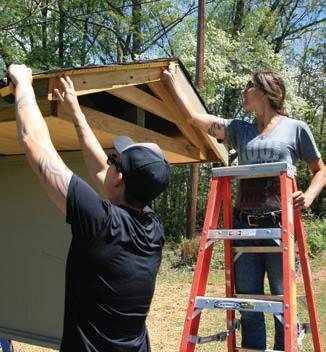


Don retired from Oak Ridge National Lab in 2014 as a Senior Research Scientist to found Nicholson and SUN LLC (www.nicholsonandsun.com) with his son, Donald. Their mission is to fight climate disruption with science and building science. Don is also a Research Professor of Physics at UNCA.

GREEN HOME & LIVING GUIDE 2023-24 | 47
ction Science and Building! • • • Constru Train for Jobs in (828) 398-7349 or contact us at abtech.edu/construction Learn more at • •
First layer of exterior wall with insulation and poly in place. The poly on walls, subfloor, and house wrap on ceiling form a perfect air barrier. DON NICHOLSON PHOTO
A More Sustainable Business Model
Equinox Woodworks’ Transition to a Workers’ Cooperative



 BY MEGHAN LUNDY - JONES
BY MEGHAN LUNDY - JONES
It’s hard to imagine the building industry as anything but a constant grind, pushing fast and furiously to meet housing needs as our population grows. Even though we identify as green builders moving towards sustainable house designs, we don’t often take the time to consider what it might look like to apply the same principles of sustainability to our businesses. Folks at the helm of our organizations are often working overtime, but what if we could run our businesses in a way where everyone on our crew had the same level of investment as the owner? What if decision-making was less hierarchical and the company vision was shared by all the employees? Would sharing the responsibility of ownership create more sustainability in our business? We decided to try it out and see if that was the case.
From the beginning, when Todd Kindberg started Equinox Woodworks in 2013, he had an ethical desire to step out of mainstream capitalism and explore a different kind of business model. Todd lives in one of the oldest intentional communities in the country, Celo Community, and also worked for six years at the Arthur Morgan School, a staff-run school where he learned about the benefits and rewards of consensus decision-making. When he read The Company
We Keep by John Abrams, the then-CEO of South Mountain Company, a design/build, workerowned cooperative in Martha’s Vineyard, he knew that transitioning to a workers’ cooperative was his long-term vision for Equinox. Not only were the values of shared ownership and non-exploitative practices a match for his values, the cooperative business model takes the sole responsibility of business success off of the shoulders of a single owner, allowing for a more equal distribution of work. As a sole proprietor, this shared work model appealed tremendously to Todd, who could see that he was on the road to burnout if he didn’t delegate more responsibility.
Upon further research, he discovered that owners transitioning
into retirement were also choosing to transition to a cooperative model at the end of their tenure because it ensured the long-term sustainability of their businesses. Ultimately, sharing ownership of the business allowed employees to maintain sustainable employment. So not only was a cooperative business model looking good
think about our transition plan and provided resources for our education. For two years, six of us worked together, pouring over bylaws and operating agreements, talking with accountants and valuing the business, and thinking about what the culture of the new cooperative might look like. This spring, we signed the paperwork
visible. Other owners are stepping up to chair committees, to take on communications, and to facilitate research and decision making. We’ve also noticed an increase in the investment and involvement of our employees, and it’s clear that they’re more interested in the outcomes of our decisions as they affect not just the overall wellbe-
in the short-term, its long-term impacts were beneficial too.
In a serendipitous meeting with Molly Hemstreet of The Industrial Commons a few years ago, Todd finally got the ball rolling and formed a Steering Committee of workers within Equinox Woodworks to make the transition.
Aaron Dawson of Industrial Commons and Rob Brown of the Cooperative Development Institute helped the Steering Committee
“sustainable” or not, but we’ve observed some things that lead us to believe we’re headed in the right direction. First, although we’ve increased the number of meetings we have in a weeks’ time, the changes in the burden on the sole proprietor have been immediately
ing of the business but also their longevity and satisfaction in their employment.
As we move forward in this new phase of our business, we’re excited to keep exploring how to further increase investment amongst owners and looking forward to lateral, rather than hierarchical, growth. For us, this change in structure feels far more sustainable than it did before and more in line with our values. If this sounds like something you’d like to explore in your own business too, feel free to reach out to us and/or to The Industrial Commons to learn more.
Meghan Lundy-Jones has spent the past 20 years of her life as an educator, helping kids learn how to be awesome humans. She is now an owner of Equinox Woodworks along with her husband, Todd Kindberg, and four others. She is mostly the Finance Manager but likes building science too. Learn more at www.equinoxwoodworks.com.

48 | www.GREENBUILT.org features
Todd Kindberg teaches the Equinox Woodworks crew how to use the new ShaperTool. DENALI BERRY PHOTO
The Equinox Woodworks crew at work. ZAC O’DONNELL PHOTO
2023 BOARD OF DIRECTORS
Love The Green Real Estate Consulting
“Green Built Alliance’s dedication to educating the general public, contractors, realtors, and fellow nonprofits is why I am a loyal supporter.”
“Green Built Alliance does more to mitigate climate change and promote social justice than any other organization of its size and, in fact, more than many much larger organizations.”
"Green building offers holistic solutions that save money, preserve resources, and create spaces that feel amazing for their owners. In our organization, creative thinking, project planning, and technical skills all align for maximum personal benefit.”
“It's a pleasure and a necessity to support an organization that's doing so much to move our community's buildings in a more sustainable and healthier direction.”
“Green Built Alliance’s programs serve diverse groups within our community and respond to its unique needs. We are building a brighter environmental future together.”
“I share the vision of making green building the baseline for residential construction in our region and beyond.”

Chelsey Hett
“I enjoy being a part of the Green Built Alliance board because it allows me to play a more integral role in green building, energy efficiency and sustainabilty in our community.”


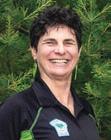



“We have to leave a better planet for our kids and the next generation to enjoy. Being affiliated with Green Built Alliance is a great way of being a part of that promise.”
Christine Davis




U.S. Green Building Council

“I’m inspired by the targeted programs GBA has created, which not only advance sustainable living and building practices, but do so in a way that is well connected to the needs of our local community. I’m excited to be part of an organization providing practical, holistic solutions dedicated to this mission.”
“Building practices based on building science and connection make people's homes better, and more sustainable homes make our community better.”
Love the Green Real Estate Consulting
“I love being a part of a mission that supports a higher standard for healthy, more efficient homes in our community. Working with their weatherization program, Energy Savers Network, has also been incredibly fulfilling to help lower utility costs for limited-income families while learning simple practices I can do for my own home to improve efficiency.”
Mary Love Chair
Stephens Smith Farrell Vice Chair Architect
Adam Klaus Treasurer CPA
Jamie Shelton Secretary SouthLight Builders
Chrissy Burton Fisher Architects
Rob Johnson JAG Construction
Alesha Reardon Duke Energy
Deborah Wright A-B Tech
Leigha Dickens Deltec Homes
Thanks to our board for their leadership, guidance and support!
Elmer and Other FUD Don’t Believe Everything You Hear About Electric Vehicles
BY DAVE ERB
High gas prices, energy security, a desire for greater resilience, and a host of other factors are driving record interest in electric vehicles (EVs). But that interest has brought backlash: rampant misinformation intended to sow fear, uncertainty and doubt among potential EV buyers, scaring them into buying “just one more” internal combustion vehicle (ICV). For those who want the clean, quiet, low
EVs’ lower maintenance and operating costs.
2: Charging is unavailable, unreliable, and takes too long.
EV charging takes the driver 20 seconds: 10 to plug in, and 10 to unplug. The car takes longer, but that only matters on a road trip, or if you can’t charge at home or work. So let’s put things in perspective. It takes three hours to drive 200 miles at highway speeds. Most newer EVs can go 250-300
It just takes a few minutes of homework on a website like ABetterRoutePlanner.com or PlugShare.com. Better yet, use both: plan your trip with ABRP, then check PlugShare’s crowdsourced status reports to be sure that ABRP isn’t sending you to any unreliable or broken chargers which, unfortunately, do exist. And remember, we’re still in the early stages of a very dynamic transition. New chargers are being installed daily, and competent competitors are quickly putting inept operators out of business.
3: EVs are just coal-fired cars with longer tailpipes; hence, dirtier than ICVs.

parked almost 22 hours a day, and charging can take place any time they’re parked. The grid has adequate capacity to charge tens of millions of EVs, today, even without managing the charging times through demand response programs, attractive rate structures, and other means. As the EV population grows, utilities and individuals will build any necessary additional capacity, just like they did in the past to accommodate the widespread adoption of air conditioning, and as they do every day to accommodate human population growth.
5: EVs are just city cars, unsuitable for rural owners.
maintenance, high performance of electric mobility but worry about this new technology, here is the truth about some common misconceptions.
1: EVs are too expensive.
All new cars are expensive, and the average new EV costs about 20 percent more than the average new car. But averages are deceptive. Well over half of the EVs sold in the U.S. are Teslas — expensive luxury cars. But plenty of new EVs sell for well below the average new car price, even without the Inflation Reduction Act tax credits. And new car depreciation is one of the only places in society where trickle-down economics actually works as advertised. Used EVs are the most obvious path to affordability, even before considering
miles on a charge, and virtually all have DC fast charge (DCFC, also known colloquially as Level 3) capability, which can replenish 200 miles in 30-80 minutes (usually closer to 30). Unlike a gas pump, you don’t have to babysit an EV charger while it’s filling your car. Plan your meal breaks right, and you won’t add any significant time to your road trip. But when you’re not traveling, you won’t have to stop at gas stations, and you’ll save money compared to the much higher operating cost of an ICV.
It’s true that you can’t yet hop in your EV and set off on a road trip in blind ignorance, trusting there will be chargers wherever you wake up. But it’s also true that today, you can travel conveniently almost anywhere in the U.S. with 200+ mile range and a DCFC port.
Vehicle emissions, for EVs and ICVs alike, are best analyzed over the entire “field to wheels” energy cycle, starting at the oil field, coal field, corn field, or wherever primary energy is collected, and following that energy through all the conversions needed to get to where the rubber meets the road. The Union of Concerned Scientists has done some of the best studies of the subject. They show that charging the average EV in North Carolina results in greenhouse emissions equivalent to those from a 98 mile per gallon gasoline vehicle. Field to wheels emissions from the average EV are better than the best conventional ICVs in all but one place in the U.S. (the island of Oahu, Hawaii), and better than the best hybrids in almost the entire country (Fig. 2).
EV owners can also take matters into their own hands by installing photovoltaic solar panels. In WNC, 2,700 watts of PV panels will provide 12,000 miles per year of emissions-free driving in a typical EV consuming 300 watt-hours of energy per mile.

4: The electric grid can’t handle widespread EV adoption. Utilities are required to prepare for the worst possible hour of demand in a 15-year planning window. As long as EV owners avoid charging during the highest demand peak hours, the grid will have sufficient capacity. EV charging is a discretionary load; cars are
Electricity for an EV typically costs between $0.03 per mile (midsize car) and $0.06 per mile (full size pickup or SUV). At $3.00 per gallon, gas for a 30 mpg ICV costs $0.10 per mile. Rural residents drive far more miles than urban drivers, making the operational cost savings from an EV even more attractive. EVs with vehicle-to-load capability, such as the Ford F-150 Lightning pickup, can even power a house during a power outage, and drive to a working charger to bring home a truckload of electricity if the outage lasts more than a few days.
There are numerous other widespread misconceptions about EVs, most of them false or, at the very least, overblown. If you’re considering an EV, please ignore the doubters, and talk to someone with actual experience owning and operating one. Here in Western North Carolina, the Blue Ridge EV Club holds regular meetups and car shows. Members can help prospective owners separate fact from fiction, and help new owners quickly navigate the learning curve of first time EV ownership.
Automotive engineer Dave Erb has developed vehicles using gasoline, diesel, biodiesel, alcohol, methane gas, alcohol, electric, and hybrid electric powertrains. He wrote Chapter 1 of David Hrivnak’s “Driving to Net 0: Stories of Hope for a CarbonFree Future,” and hasn’t bought gasoline since 2 019.
50 | www.GREENBUILT.org
features
EVs can’t drive on pixie dust, but they can drive on sunshine. JOE BAUM PHOTO


GREEN HOME & LIVING GUIDE 2023-24 | 51
The Problematic Nature of Car Dependency The Case for Sustainable Transportation
 BY JOE FRANCO
BY JOE FRANCO
Since the 1950s with the introduction of the Interstate Highway System, as well as large-scale suburbanization, America has become incredibly dependent on and addicted to its cars. This phenomenon comes at a cost, which can be measured in human safety and health, economic productivity, equity, and environmental well-being.
Changing our current transportation system is vital to addressing climate change. According to the EPA, in 2021 the transportation sector accounted for 28% of US greenhouse gas emissions (GHG), more than any other sector, and was overwhelmingly dominated by cars and trucks, accounting for 75% of global transportation emissions. However, investments in infrastructure for cars and trucks are incredibly costly. As stated by the Urban Institute, in 2020, state and local governments spent $204 billion on highways and roads, the fifth largest share of government expenditure. But our current transportation system also presents
health and safety concerns. For one, car dependency is associated with inactivity, which has an enormous cost in lives, personal health, and money. As reported by the American Public Health Association, the cost of obesity is estimated at $142 billion annually. Not to mention, road deaths are so common they have become normalized. According to the National Highway Traffic Safety Administration (NHTSA), road deaths reached a 16-year high in 2021 as “an estimated 42,915 people died in motor vehicle traffic crashes”.
Car dependency also exacerbates problems of equity. To give a local example, according to the Close the GAP plan, the average car owner in Asheville, North Carolina spent $700 per month, or $8,400 per year, on vehicle-related expenses in 2022. Due to the high cost of living in Asheville, more workers are being forced outside the city in search of affordable housing, resulting in higher transportation expenses, less transit and bike accessibility, and more car dependency. The burden of road deaths is also not
distributed equally in the US. According to Smart Growth America, statistics show that Black, Indigenous and low-Income Americans are disproportionately affected by dangerous street design. Low-income neighborhoods and communities of color also face the biggest burden of air and noise pollution from the transportation sector, resulting in adverse health effects and issues of environmental justice.
Clearly, there is plenty of room for improvement. According to the EPA, 94% of all fuel used for transportation in the US is petroleumbased, meaning there is enormous potential for electric transportation technology to grow. The shift to electric is quite difficult to ignore, as more and more electric vehicles (EVs) can be seen in neighborhoods across the country. The 2022 Super Bowl even included seven EV commercials. The Inflation Reduction Act allocates roughly $43 billion dollars towards making electric vehicles more affordable. While this shift to electric is a very worthwhile endeavor, and would significantly cut down
on GHG emissions, it’s important to note that it does not entirely solve the problem. Electric cars still require just as much road infrastructure, and do very little to solve many of the other concerns mentioned above.
Thankfully, there are other solutions to address these concerns and build a more just, sustainable, and equitable world. Before the US decided to invest so heavily in car-dependent infrastructure, the US had unquestionably the most advanced and esteemed rail system in the world. Today, after 15 years of work towards America’s first high-speed rail line in California, the project is still far from completion. Comparatively, China has over 24,000 miles of highspeed rail lines and is on track for 43,000 miles by 2035. Other countries with advanced rail systems include Germany, Spain, Japan, France, Sweden, South Korea, and the United Kingdom. And despite its global popularity, CO2 emissions from rail account for only 1% of global emissions, due to its ability to be easily electrified. In addition to incredible energy effi-
52 | www.GREENBUILT.org
Only .7% of people living in Asheville choose to bike to work.
features
ANNIE MCGEHRIN PHOTO
ciency, embracing rail transportation comes with a long list of other benefits: reduced road congestion, optimized land use, increased safety, cost-effectiveness, and less maintenance.
The same benefits associated with rail can also be seen with other forms of transportation. Walkable and bikeable infrastructure, as well as public transportation such as buses, subways, and trams, share all of the benefits of rail transportation but are also far more accessible. From an affordability perspective, all of these alternatives are more cost-effective, both for the individual and for the municipality. It should go without saying, biking and walking are incredibly cheap and accessible transportation, but they are only safe when they are designed properly. We need barriers between car traffic and bike paths, and to reduce traffic speeds to protect pedestrians. Places like the Netherlands are the gold standard for bikeable and walkable infrastructure. There, nearly 35% of all trips are made by bicycle, compared to only 5% in even the most bicycle-friendly cities in the US such as Portland and Minneapolis. However, when high-quality bike
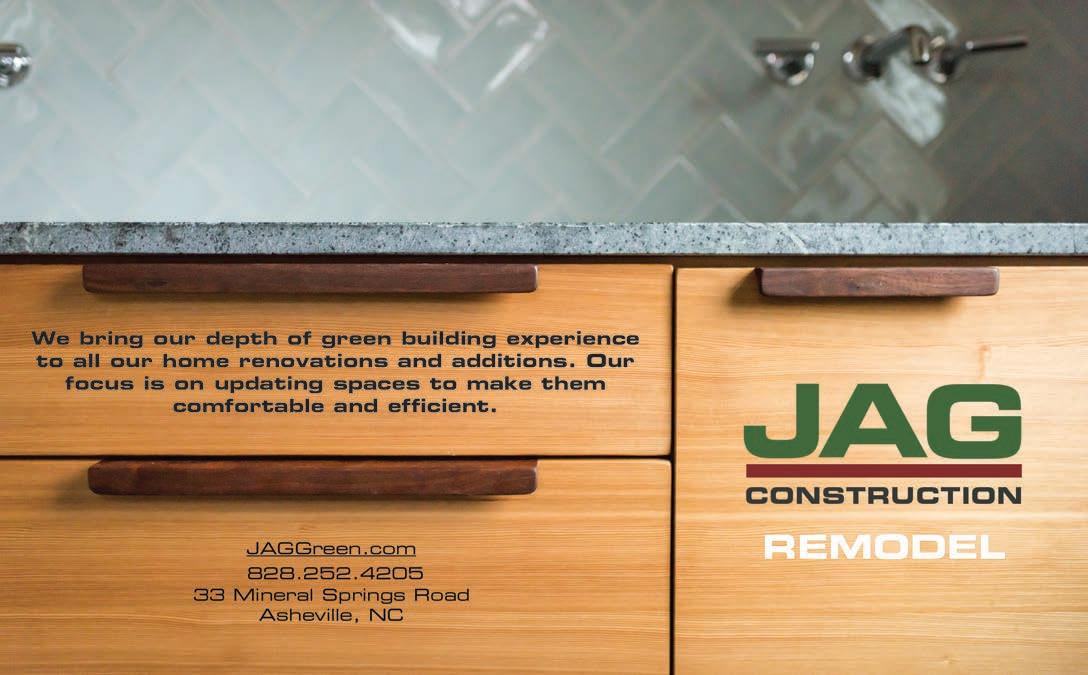
infrastructure is in place, everybody rides. In the Netherlands, the percentage of women and men riding bikes is evenly distributed whereas, in the US, women make up just over a quarter of bicycle commuters. Furthermore, the average elderly Danish person is more than 30 times more likely to ride their bike than their American counterparts, and the statistics are relatively similar for children. Significant populations in the US do not enjoy the freedom of mobility due to car-dependent infrastructure, but bike and public transportation infrastructure can fill that gap.
The City of Asheville still has a long way to go toward truly be-
coming a multi-modal city, but it has been making some steps in the right direction. Apart from improvements in bicycle infrastructure, the ART (Asheville Rides Transit) bus service provides significant connectivity throughout the city and even to neighboring Black Mountain and the Asheville/Hendersonville Airport. Service runs from around 5:30 am to 10:30 pm Monday-Saturday and 8:00 am to 6:00 pm on Sundays and Holidays. Fares are only $1, and significant efforts have been made to improve accessibility, including bike racks, wheelchair access, and ADA certification for all buses. There are numerous mobile apps such as Transit, Moovit, and Google Maps
that provide real-time service updates, or you can call 828-253-5691 and press #1. Unfortunately, these resources are not fully utilized, as reported in the 2019 US Census American Community Survey, in Asheville NC, over 74% of city workers drive alone to work, and just 1.1% ride public transit to work, and 0.7% choose to bike.


Transitioning to sustainable transit is a necessary step toward addressing the climate crisis and building an equitable future. This is no small endeavor, but it would mean thousands of new green jobs, increased domestic energy security, less reliance on foreign oil, and a dramatic revisualization of what success looks like. We can create vibrant communities that prioritize people over cars; all we need is the social and political will to make it happen.
Joe Franco is a senior at UNCAsheville majoring in International Studies with minors in Environmental Studies and Political Science and a certificate in Sustainability. Last year, Joe was successful in making UNC- Asheville a Bronzelevel Bike Friendly University, and is currently the supervisor of the Campus Recreation Bike Shop.
GREEN HOME & LIVING GUIDE 2023-24 | 53
Traffic congestion in Asheville, NC. WLOS PHOTO
How EMFs Can Affect Your Health

Siri and Alexa Probably Shouldn’t be Your BFFs
BY RICK BAYLESS
Whether you’re a green builder or working with one, you are probably already familiar with the structural elements of building green. The holistic approach to energy and water use, material selection and the building’s effects on its site are integral to the green building movement — but so is focusing on indoor environmental quality.
As our homes become more
senses, but, like sound, radiate and pulse as waves within our atmosphere, and they are everywhere. Now that everything has gone electric and wireless, there is no let-up from the “pulsing” EMF our bodies are exposed to at home and work, at school and in community spaces.
Electromagnetic sensitivity is being linked to a wide range of health problems from allergies to autoimmune disease, cancers,
precautionary measures, especially if you are in the building stage, rather than having to fix things later? Let’s take a look at some things to consider to make your green home even healthier.
What are some sources of EMFs?
We’ve had nature’s EMFs all along: Earth’s magnetic field, air ionization, lightning, radon and solar radiation.
n Beds with metal frames or springs
n X-rays
n Microwaves and appliances
n Wireless Internet modems
n Television and computer screens
n Cellular and cordless phones
n Radio Communication Transmitters
n Radar
n Machines and Variable speed motors
n Noise from auto or air traffic
*Discuss with your builder
Collaborating with your builder
Take a look again at the list. The first five are topics to discuss in the design-build process. Here are some questions to consider with your builder, along with some options for reducing your EMF exposure.
Electrical wiring system. Is it reasonable to use metal-clad wiring? If it’s too expensive, install a “kill switch” for bedrooms so you can turn off bedroom circuits at night. Can the electrical panel be positioned away from bedrooms, preferably on the exterior garage wall? Can wiring run along the floor instead of through the middle of the wall?
sophisticated and connected, so do issues surrounding new possible health-related concerns and how we should deal with them.
Electromagnetic sensitivity is one such concern becoming mainstream. Our building materials have always evolved as we discover health hazards, such as asbestos and lead paint in previous decades. And today, for example, we’re seeing increased concerns over gas stoves. Electromagnetic Frequencies (EMF), also referred to as Electromagnetic Radiation (EMR), is another increasing 21st century home health problem.
To simplify the discussion, we are going to refer to the issue as Electromagnetic frequencies (EMFs). EMFs are invisible to our
chronic fatigue syndrome (CFS) and neurological disorders such as Alzheimer’s. It can even affect quality of sleep, cellular health and the body’s electro-chemical communications.
This topic is not without controversy. While everybody — from building biologists to scientists to tech companies — is talking these days about electromagnetic radiation frequency, not all agree on its impact. However, the World Health Organization and other experts have encouraged a measure called The Precautionary Principle. It’s the idea that there’s enough known or perceived risk to indicate concern and encourage preventative action. So, why not consider the possibility and take
However, today’s man-made technology brings new sources of EMFs that now inundate our bodies with a wide range of AC/DC electric and magnetic fields, radiofrequency radiation, radioactivity, geological disturbances, sounds and vibrations. New shielding and avoidance behaviors must be learned. Here is a list of some of the most common sources:
n Electrical wiring and panels*
n Underground cable, piping and plumbing*
n Radon gas and natural radiation from the earth*
n Photovoltaic (solar panel) systems*
n Lighting fixtures, dimmers and 2-3 way switches*
n Wireless devices
Underground cable, piping, and plumbing. Will everything be appropriately grounded and connected so that parallel neutral pathways — which cause high magnetic fields — are avoided?
Radon and natural radiation from the earth. Will the home be tested for radon and, if the levels are elevated, will a mitigation system need to be installed?
Photovoltaic systems. Will there be solar panels, and where will the inverter be? As these systems convert DC electricity into AC electricity at the inverter, they can create a high magnetic field and electromagnetic interference (EMI). Place the inverter at least 510 feet away from places people will spend significant time. EMI can be mitigated if it is elevated. Lighting fixtures, dimmers and 2-3 way switches. To minimize exposure to the EMF they emit, see
54 | www.GREENBUILT.org
features
RF Meter. RICK BAYLESS PHOTOS
whether you can install fewer lights on each circuit, or even individual lights on each circuit, eliminating the need for dimmers or two-way switches. Also, ditch fluorescents, which can emit high magnetic fields.

Consider bringing in a certified EMF specialist who can work with

you and your builder in the design-build process. It’s a growing field and becoming mainstream.
Here’s what you can do yourself
Even in this age of overwhelming, overpowered, in-your-face technology, there are still steps
you can take to reduce your overexposure to EMF.
Reduce your EMF exposure from your cell phone. When you decide that it’s YOUR time, turn your cell phone to airplane mode, Bluetooth off, location off. When you’re available again, use the cell phone in speaker mode rather than holding the phone up against your head.
Put the phone across the room rather than leaving it on the nightstand. Putting 6 feet between you and the EMF offender makes all the difference, especially at night when we need to rest, recover and repair. Placing cellphones in another room or turned off at night would be even better. Get a battery powered alarm clock and lamp. On top of all the incoming messages, the EMF output from these communication technologies in your sleeping place adversely affects the quality of your sleep too.
Reduce EMF exposure from home-based WiFi. Kick your router out of your bedroom, or power the WiFi down at night and reboot it the next day. You can even plug it into a circuit timer so you don’t have to think about it.
Schedule an EMF Screening
Exam. You can get a measurement of electrical fields, magnetic fields, and RF inside and outside the home.
Those of us in the field of healthy home examination — who analyze and inspect crawl spaces, water drainage, erosion, HVAC, indoor air quality and other issues that impact a home environment — are adding EMF to the list of concerns. The industry has evolved since its early beginnings and we continue to discover better solutions to 21st century issues. Through collaboration and continuing education, all of us can benefit from building a more sustainable world.
Rick Bayless is a nationally award-winning Environmental Home Healthiness Expert, Board Certified Indoor Environmental Consultant, Certified Healthy Homes Specialist, and schooled in Building Biology. Regarding house and occupant wellness issues, including Sick House Syndrome, Rick and his team diagnose the trouble, define effective solutions, and guide folks through to resolution.
“When it’s your health that matters most.” Connect with Rick at www.ahealthierhomenc.com.
GREEN HOME & LIVING GUIDE 2023-24 | 55
Disconnected cable wires can become a parallel neural pathway, causing high magnetic fields.
It all Started with a Dream Highlights of Buncombe’s Renewable Energy Plan
 BY DAVID GORDON
BY DAVID GORDON
Buncombe County, in collab-
oration with the City of Asheville, voted in 2017 to adopt a resolution for the county and community as a whole to be powered by 100% renewable energy by 2042. This is quite an ambitious goal, one that more and more cities, counties, and states are adopting by setting similar targets. In fact, according to the Clean Energy States Alliance, more than 51% of the U.S. population now lives in states that have 100% clean energy goals. This now includes North Carolina, which has set a goal for carbon neutrality in the electricity sector by 2050. But Buncombe County was way ahead of the state on this one, both in its time frame and its ambitions. Buncombe County was the first community in Western North Carolina, and the second in the state, to commit to such a goal. And now, in collaboration with the Blue Horizons Project (BHP), Buncombe County is not merely focusing on
clean energy in the electricity sector, but in all sectors.
Making lofty goals can be a great way to achieve high level success, but the devil is in the details. How in the world does an entire county, not just government operations — everyone and everything who resides within it — transition away from nearly 100% fossil fuels to run completely on renewable energy? Well, that’s where the Blue Horizons Project Community Council (BHPCC), a program of Green Built Alliance, comes into play. The BHPCC is the successor to the Energy Innovation Task Force (EITF), which successfully accomplished its first goal of blocking a new peaker energy plant at Lake Julian. With that accomplished, and under a new name, BHPCC, they set their sights on the goal of transitioning to a clean energy future in a just and equitable way.
In addition to its ongoing efforts to help equitably transition the community to clean energy,
the BHPCC has worked for the past two years on creating a Strategic Plan detailing how to achieve its 100% renewable energy goals by 2042. The process has been incredibly collaborative and includes the input of over 100 community members who have contributed endless wisdom, insight, and expertise. The BHPCC and various committees and subcommittees have worked tirelessly to bring the plan to fruition.
It all started with the dream of a 100% renewable energy future. But what does that actually look like? After envisioning the future, the committee set upon understanding the current energy landscape of Buncombe County. In order to chart a path, we need to understand both where we are and where we want to go. At times, the process went thick into the weeds, trying to sort out all the nitty gritty details — things like geospatial boundaries, data analytics, energy units of measurement, and all the complex aspects
of the energy sector. But as anyone who has ever hiked to a bald in order to get to a breathtaking Appalachian vista knows — you have to keep the end goal in mind, power through the burn, and keep trudging, step after step.
With all of the time, energy, and effort that went into the creation of the Strategic Plan, the BHPCC was proud to have a first draft completed at the end of February 2023. Following that, several rounds of reviews began, including reviews by a BIPOC-led equity focus group, Green Built Alliance, the BHPCC, the City of Asheville and Buncombe County staff members, and various other external organizations. The Plan was finalized and approved in July 2023.
The process of creating the Strategic Plan has revealed many nuggets of wisdom that are worth sharing:
n Meeting the energy goal will be a community-wide effort beyond the control of any entity.
n Electrification and efficiency improvements can reduce the total energy required for the transition by about 50%.
n The BHPCC considered nearly 100 potential initiatives and narrowed them down to those that represented the best use of our resources. The highest ranking initiatives include: heat pump water heater promotions and bulk buying, expanding the Energy Savers Network program, microgrids, electrifying HVAC, expansion of EV charging infrastructure, agrivoltaics, expanding the Duke Multifamily Retrofit and DSM program, expanding the Duke Energy Small Business Energy Saver Program, the Neighbor to Neighbor Solar program, increasing walking and biking options, reducing vehicle miles traveled per capita, and focusing on opportunities for community action.
n Many initiatives for renewable energy also improve equity and accessibility.
n There are four local policies that can be implemented to support the community moving towards renewable energy in a just and equitable way: incentivizing green development in new construction; improving permitting and inspections for cost savings and efficiencies; establishing staff positions at the City and County to provide a liason/ombudsman for developers and individuals to navigate the
56 | www.GREENBUILT.org
Electric Buses exhibited at Land of Sky event.
features
LAND OF SKY CLEAN VEHICLES COALITION PHOTO
permitting process for renewable energy, energy efficiency, and electrification; and creating a financing structure to support the energy transition.
n State and federal policies can have a large impact on the ease in
which the goal is achieved, so the BHP should engage in advocacy and organize community advocacy for state and federal policy change.
n Our current energy use is dominated by transportation fuels — which contribute around half —
and electricity and natural gas each represent about one fourth of energy demand.
n Implementing the energy transition will require substantial capital investment, but the energy costs will be lower in the 100% re-

newable case than in the business as usual (BAU) scenario.
The community of Buncombe County has committed to a goal of 100% renewable energy by 2042. The Strategic Plan identifies three essential technical pathways: embracing energy efficiency, electrification, and greening the grid, as well as three action pathways: implementing initiatives, supporting policy changes, and community engagement. Together, these pathways represent our whole systems approach to change. If these pathways are integrated into every step and decision made within our community, we believe that Buncombe County can and will successfully achieve its goal of 100% renewable energy by 2042 in a manner that is just, equitable, and benefits all members of our local, national, and global community. The time to act is now.

David Gordon, M.S. Sustainability Studies from LRU, grew up in Oakland, CA. He has worked as a Teacher, Naturalist, Backcountry Guide, CiviCorps Crew Leader, Park Ranger, Green Builder, and currently works as a Project Management consultant with the Blue Horizons Project at Green Built Alliance.
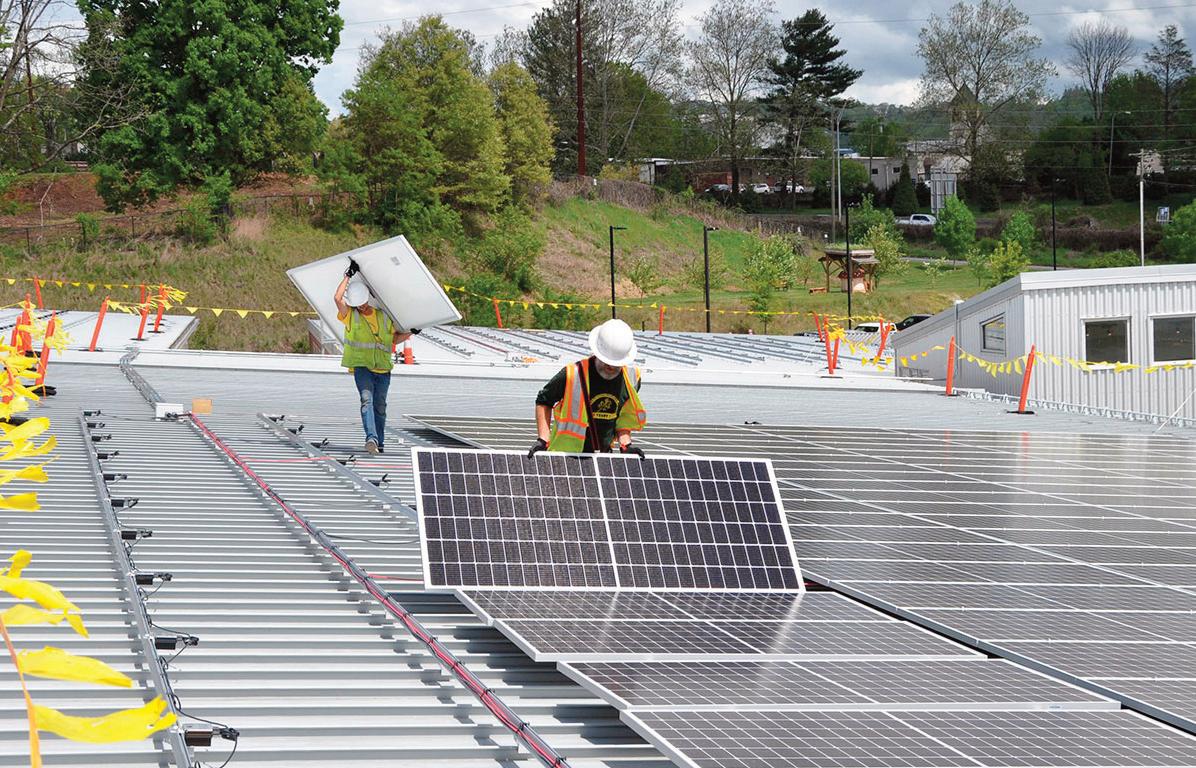
GREEN HOME & LIVING GUIDE 2023-24 | 57
The 300 kWh community-funded solar installation at Isaac Dickson Elementary School is expected to save over $1.3 million in utilities costs over its 30 year life span.
SUNDANCE POWER SYSTEMS PHOTO
Why Trees? The Benefits of Trees in Urban Landscaping
BY AMY SMITH
The natural beauty of Asheville and Western North Carolina is a major reason why so many of us call this area home. We are surrounded by lush forests, sparkling rivers and lakes and abundant wildlife. While development is a benefit for our economy and our region, smart growth is necessary to ensure that we preserve the qualities that make this area unique. To ensure this ecological balance, trees and other vegetation must be managed in our cities, towns, and subdivisions in a forward-thinking and sustainable manner.
Trees in urban settings play an important role in our daily lives. Most people associate trees with providing shade and beauty, but this is only the beginning of urban tree canopy benefits. Trees work to clean the air we breathe, and studies show that roadside trees can reduce nearby indoor air pollution by more than 50%. Trees reduce stress and improve human health, including a reduction in cardiovascular disease for people living in neighborhoods with urban canopy cover. The shade that trees provide has been linked to a reduction in deaths from heat, by
mitigating the urban heat island effect — the measurable difference between the temperature in the city compared to outlying suburban and rural areas. Without trees, this difference can be up to 10°F.
Not only do urban trees improve human health, but they are also necessary for the environment. Urban trees provide important habitat for wildlife, including migratory birds, pollinators, and endangered species. Trees reduce the impacts of climate change by absorbing carbon dioxide and countering the emissions from transportation and fossil fuel energy production. Annually, an acre of mature trees can absorb carbon dioxide equivalent to a car driven 26,000 miles. In addition to reducing carbon dioxide in the atmosphere, trees can reduce the need to use energy in homes and buildings. According to Energy.gov, a household can reduce energy consumption for heating and cooling by up to 25%, or between $100 and $250 saved per year, with just three carefully placed trees. Urban trees are also necessary for erosion control and the reduction of flooding. Tree roots reduce landslides and improve soil stabil-
ity, and all vegetation soaks up rainwater and reduces runoff. In the coming decades in Western North Carolina, we can expect increased rainfall and cloudburst rain events due to climate change, making the preservation and planting of urban trees even more necessary.
Finally, urban trees are good for neighborhoods and cities. Trees improve property values, and a fully landscaped property will sell faster and for higher prices than a home without trees. A study in Atlanta showed that homes in neighborhoods with mature trees sold for almost $105,000 more than homes in neighborhoods without mature tree canopy. Urban trees also reduce crime at all levels. Areas with trees and landscaping are less vulnerable to graffiti, vandalism, and littering. Major cities show a reduction in violent and aggressive crimes of between 12% - 25% in areas where street trees are present. In Western North Carolina, our economy thrives on tourism, which is supported by our beautiful mountain forests and tree-lined city streets.

As a builder, there is much you can do to enhance the urban tree canopy and ensure that the bene-

fits of trees are passed on in the neighborhood. Meeting the minimum development codes is a start, but with thoughtful planning and design, the landscaping budget can be used to increase property value, improve stormwater runoff, and save energy. Green building practices encourage sustainable design and construction, beginning with the planning stage. Preserving mature trees on a site will provide the maximum benefits of shade and carbon sequestration, and this can then be supplemented with additional plantings that enhance the landscape and improve stormwater runoff or encourage pollinators. Luckily, our region is well supported by academic, non-profit, and professional partners who are available to assist with sustainable landscaping practices.
Homeowners can also enhance climate resilience, maximize energy savings, and enjoy shade benefits of their urban tree canopy. While many homesites already have mature, native trees, those that lack trees can use plantings to increase the beauty and function of their landscaping, while also decreasing maintenance and annual costs. Partnering with certified green landscaping and construction partners will return investment dollars through reductions in energy use and an increase in property value. Trees truly are a win-win for homeowners, the community, and the environment.
Here in Western North Carolina, we are surrounded by nature and gorgeous forests, but we still have to be thoughtful about how we care for our environment. Taking the time to plan for tree preservation and green landscaping at the beginning of a building project can provide innumerable benefits for both homeowners and the land. Protecting our urban forests is essential for a sustainable and healthy future.
Amy Smith is a Professor of Science at Purdue University Global and a REALTOR® with Modern Mountain Real Estate in Asheville. She is a GREEN certified real estate agent, is LEED AP accredited, and holds an MS in Forest Ecology and Management as well as an MS in Environmental Policy. Amy formerly served as the Chair of the Asheville Urban Forestry Commission and is a volunteer member of the Asheville Tree Protection Taskforce.
58 | www.GREENBUILT.org
features
Treasured English elms on Church Street in downtown Asheville.
ANNIE MCGEHRIN PHOTO
The Earth Steward in You
Supporting Ecology by Uplifting Land, Life, and Social Design Solutions
BY KERI EVJY
Forest Ecology is a long, dynamic process. It takes millennia of nutrient cycling and succession to grow the scaffolding for the diverse plant and animal species dependent on the bedrock material, elevation, soil and solar conditions. Forests provide innumerable and intangible ecological services: they build and cover soil; keep water hydrating and sustaining life; provide oxygen; host the bacteria and mycelia that decompose waste and are food for other species; and are home to “standing lakes’’ trees, which retain moisture high in the watershed and prevent erosion. The temperate broadleaf forest biome is the building block for the fertile and flourishing Appalachian mountainsides that draw so many in their search for home.
As development continues through the Appalachians, more marginal lands and steep slopes are being considered for human housing and settlement patterns. For those purchasing land, the best time to begin their land stewardship and engage with ecologically literate professionals is at the beginning, before any development, excavation or build occurs. They should understand the ecological patterns impacting the land, site opportunities and limitations so they can protect the watershed and forest services.
While excavators can perform a variety of essential functions and maximize non-renewable energies to create ponds, grade land for a home site, build retaining walls, etc., they can also do decades and centuries of expensive and irreparable disturbance and damage in an hour. Rushed excavation can result in the need for emergency services to stabilize and cover denuded slopes; reforest; add immediate earthworks to mitigate flumes of water down scarred slopes; terrace; and hold back the mountain from generating a creek full of topsoil. This often is a result of steep hillsides being stripped of vegetation and cleared, generating unchecked water and soil erosion coursing down the mountain, causing gullies on the land and deep downhill neighbor frustration.
It is important to be on the same page with the excavator operator and be present with them when the tool is at work. Take the time to make a map of wild plants to keep and delineate boundaries where the machine can disturb and where to not forge. For new building sites, the best ecological option is to ask the operator to take an hour and scrape off the native topsoil and set it aside during construction, with a plan to put it back once complete, so that the biodiversity and the embodied energy of soil making can be preserved. I have known land stewards
that wished they had this empowering information before the operator came to “clean up” their land — meaning removing everything growing in a steep slope environment (not wise) and deeply burying the native topsoil that once teemed with life. The machine operator in these cases lacked stewardship, understanding of the ecological services at play on the site, and understanding of how to account for the steep terrain for ecologically sensible earthwork movement.
At an initial land consult, the best ecological response, depend-



ing on the situation, is usually to create the scaffolding for succession of a forest, to make and disseminate seed balls of fast-growing cover crop, lay down a biodegradable erosion mat and plug with native hardy perennials, install shrubs and earthworks, and to check dams and on contour swales — to slow, infiltrate and redirect the water. It is ideal to work in concert with ecological time and consider the goals of the human client and the earth client in tandem. As we all are responsible stewards to our home, it is well worth it, for generations to come, to educate yourself, bring in earth literacy professionals early on, cover the soil as soon as possible, add vegetation, straw and address erosion at the source.
Keri Evjy is a creative entrepreneur, permaculture designer, teacher, and community revitalist committed to supporting ecology by uplifting land, life, and social design solutions. She is the Founder and CEO of Healing Roots Design, LLC, Regenerative Life Design, LLC, and author of the multimedia Regenerative Life Design Playbook. Learn more at healingrootsdesign.com.
GREEN HOME & LIVING GUIDE 2023-24 | 59
Examples of steep slopes harmed by excavation, in a state of unstable dynamics. Field staff conducting “emergency services,” to stabilize the slope, using stones and logs on site to contour, slow, and infiltrate water across the bare slope, instead of the water coursing down, taking the sediment and mountain with it. KERI EVJY PHOTOS
Assessment of an unnaturally steep embankment made by excavators, grass seeded and strawed.
Leave a Positive Footprint
Nonprofit Hosts Inaugural Earth Day 5K Fundraiser to Reduce the Community’s Carbon Footprint
BY ANNIE MCGEHRIN
Arainy Earth Day morning
didn’t stop the first annual Earth Day 5K fundraiser event from being a hit. Running enthusiasts came together for a healthier, greener community at Carrier Park for this awesome event earlier this year.

The staff and board members were honored to host the first annual Earth Day 5K — creating a memorable experience for the community and inviting folks to learn more about how they can lower their carbon footprint and support local clean energy projects. With the generosity of our amazing sponsors, we hope that this event will blossom and grow for many years to come. A total of 180 people registered to participate in the 5K race, 1 Mile Fun Run, or Virtual 5K and didn’t let the rainy weather stop them from pounding through the Carrier Park puddles.
All proceeds from the event were donated to Green Built Alliance’s Appalachian Offsets program, a local carbon offsetting opportunity that allocates community members’ offsets toward renewable energy projects for Buncombe County schools or other nonprofit organizations. The
United Way of Asheville and Buncombe County, located in downtown Asheville, has been selected as the next partner for a free solar energy system via Appalachian Offsets, demonstrating their commitment to sustainability and leadership in the fight against climate change.
“We’re thrilled to partner with Green Built Alliance’s Appalachian Offsets program to dramatically reduce our energy consumption and convert the cost savings directly into strategies and solutions that impact youth and families across Buncombe County,” said Dan Leroy, President & CEO.
“United Way of Asheville and Buncombe County is honored to receive a solar energy system through this program that helps nonprofits like ours transition to a more resilient, climate-friendly community.”
The annual Earth Day 5K fundraiser will play an integral role in Buncombe County’s effort to move to 100 percent renewable energy and serves as a key piece of Green Built Alliance’s dedication to sustainable living, green building and climate justice through inspired action, community education and collaborative partnerships.


Stay tuned for details on the second annual Earth Day 5K, coming in the spring of 2024, with all proceeds benefiting Green Built Alliance programs.
What is Appalachian Offsets?
The Appalachian Offsets program of the nonprofit Green Built Alliance allows businesses and individuals to calculate and offset
their carbon footprint while investing directly in local energy efficiency and renewable energy projects. The program launched in 2005 and completed 4 energy efficiency projects in its early years. Projects made possible by contributions to the Appalachian Offsets program include a 300kW solar array for the Issac Dixson Elementary School, a 10kW PV system for St. Paul’s Missionary Baptist fellowship hall, and energy efficiency upgrades at the Opportunity House in Hendersonville, Asheville Housing Authority, and the YWCA in Asheville. The next Appalachian Offsets project will be an installation of a large PV system for the United Way of Asheville and Buncombe County downtown office building. For more information, go to www.cutmycarbon.org.
Annie McGehrin is the Development & Marketing Manager at Green Built Alliance. After moving to North Carolina in 2016, Annie received her bachelor’s degree in Sustainable Development from Appalachian State University. The Earth Day 5K event was organized by Annie alongside Summer Winkler, Program Coordinator at Green Built Alliance. Connect with Annie at Annie@greenbuilt.org.
60 | www.GREENBUILT.org
First place winner in the female category, Rachel Cheney poses with her tree award provided by Asheville Greenworks. ANNIE MCGEHRIN PHOTO
features
Natasha Castro and Kelvin Bonilla celebrate their achievements at the finish line of the Earth Day 5K. SUMMER WINKLER PHOTO
Making Solar Accessible Program Brings
Free Systems
Families in Buncombe County
BY SUMMER WINKLER
Solar energy is one of those things in the sustainability world that has a certain umph to it. It’s long-lasting, attractive, and a great gesture that individuals can do to lessen their carbon footprint. But it’s also fairly expensive.
An average photovoltaic (PV) system can cost a homeowner tens of thousands of dollars. Even with upcoming tax credits and rebates available from the recently passed Inflation Reduction Act, it still takes quite a chunk of change to purchase panels for your home, so homeowners without the means to make this purchase are getting left behind.
The City of Asheville and Buncombe County have an ambitious goal: Achieve 100% renewable energy for the entire community by 2042. That means everyone. So how do we bring solar to our com-
to
munity in an equitable way? Enter: The Neighbor to Neighbor Solar program.
The Neighbor to Neighbor Solar program began in 2021 after recognizing the need in the community for affordable solar. This program aims to directly address the high energy costs that disproportionately burden low-income families, while also reducing carbon pollution and advancing our region’s energy goals. Neighbor to Neighbor is funded by the American Rescue Plan Act and the City of Asheville and Buncombe County Sustainability Offices. The project aims to install 20 systems by the end of 2024, contracted through Sugar Hollow Solar, a local Asheville company.
Neighbor to Neighbor recipient Lucinda Bickers had wanted solar for her home for many years, but simply could not afford it. While researching if the Inflation Reduc-


tion Act would help make solar a possibility for her household, she learned about the Neighbor to Neighbor program and made the easy decision to say yes.
“Just the opportunity to have it installed for free was mind boggling,” she said. “I was amazed that this was a possibility and y’all were the first ones to offer it. My last bill I just paid was $34! I’ve never in my life paid $34 for an electric bill. The panels look awesome and I haven’t had any trouble at all. The biggest trouble I have is trying to explain to my roommate what kilowatt hours are.”
To qualify for Neighbor to Neighbor, families’ income must be less than 200 percent of the Federal Poverty Guidelines. Specific focus will also be given to Black, Indigenous, and People of Color (BIPOC) households. Applicants are even given free weatherization audits and upgrades through the Energy Savers Network program prior to installation, to ensure homes are as energy efficient as possible from the very beginning. This allows the PV system to work at its full potential, maximizing energy savings.
Clary Franko, Chief Operating Officer at Sugar Hollow Solar, highlights the importance of serving our community with this program: “It’s essential that we include all people in the clean energy revolution happening right now. Solar
Give Back
Those interested in donating to support the Blue Horizons Project’s Neighbor to Neighbor Solar efforts can visit greenbuilt.org/donate, mail a check to Green Built Alliance at PO Box 2594, Asheville, NC 28802, or email office@greenbuilt.org for more information.
is one of the brilliant technologies that’s necessary to create a healthier future, but we need more people to be accessing and benefiting from both the energy and the economy of it.”
For Buncombe County households that would like to apply for Neighbor to Neighbor Solar, visit our website at bluehorizonsproject.com/n2n to review the qualifications. If you have any questions, please reach out to Summer Winkler, summer@greenbuilt.org or 828-222-0314.
Summer Winkler serves as the Clean Energy Program Coordinator with Green Built Alliance. Prior to joining staff last year, she worked as an intern with Green Built Alliance while receiving a Graduate Certificate of Sustainability from Virginia Tech. Connect with Summer at Summer@greenbuilt.org.
GREEN HOME & LIVING GUIDE 2023-24 | 61
Sugar Hollow team installs panels for a recipient in Arden.
Neighbor to Neighbor Recipient Lucinda Bickers on her installation day with Sugar Hollow. SUGAR HOLLOW SOLAR PHOTOS

62 | www.GREENBUILT.org
MEMBER DIRECTORY
Griffin Architects PA

Alternative & Natural Building
***YES
Deltec Homes


Leigha Dickens
Asheville • 828.253.0483
ldickens@deltechomes.com
deltechomes.com
Deltec Homes is an award-winning prefabricated homebuilder. Offering round and modern styles, our homes are best known for energy efficiency, great views, and resilience. We pride ourselves on manufacturing homes sustainably in a facility powered with 100% renewable electricity.
***YES
MudStrawLove LLC

Steve Kemble Asheville • 828.775.4823
connect@mudstrawlove.com
mudstrawlove.com
We help plan homes and teach techniques using straw bales, earthen materials (cob, earthbag, etc.), and lime- or claybased plasters, paints and floors. Site and Design Consultation, Workshops, Aprrenticeships, Crew Trainings, Permaculture since 1990.
Architects
***YES
Steel Root Builders

Bob Koplos Asheville • 830.832.7610 bob@steelrootbuilders.com steelrootbuilders.com
We specialize in modern luxury homes, complete renovations and commercial upfits.
***YES
Sure Foot Builders Inc.

***YES
Evergreen Construct Inc.


Darren Henegar
Leicester • 828.779.4077
evergreenconstructinc@gmail.com
evergreenconstruct.com
Evergreen Construct specializes in custom-built homes and renovations, using your inspiration to create mindfully crafted structures through a collaborative process.
Green Earth Developments
James Boren
Asheville • 386.690.0886
JamesnBoren@yahoo.com
loveyournewgreenhome.com
Our business involves developing responsible homes on a site where the trees are considered very important assets to this planet. Love your new green home!
***YES
River Birch Builders

Pierce Harmon and Griff Gamble
Asheville • 828.423.9813
riverbirchbuilders@gmail.com
riverbirchbuildersnc.com
We offer quality and craftsmanship in the building of green and energy-efficient homes. We offer design and build services for fully customized homes, and experience with a range of architectural styles and sizes. From start to finish, we'll work closely with you to make your dream home become a reality.
***YES
Alice Dodson Architect, PA
Alice Dodson Weaverville • 828.712.9326 alice@alicedodsonarchitect.com alicedodsonarchitect.com
Integrated and affordable residential architectural design, long-time experience with alternative energy use and various energyefficient, high-performing construction.
Robert Griffin Asheville • 828.274.5979 inquiries@griffinarchitectspa.com griffinarchitectspa.com
Griffin Architects provide years of experience and interpretations of specific information relative to the clients needs, the site and its orientation, and the neighborhoodÍs relationship to the community. We offer 3-D Energy Modeling/Virtual imaging services of custom residential designs and additions, commercial developments, environmental design, community planning, and historic preservation.
***YES
Raymond Thompson Asheville • 828.242.0925 surefootbuilders@gmail.com surefootbuilders.com
We are a green home building company working in the greater Asheville area. It is our passion to build beautiful and creative homes that add value and comfort to the lives of our owners and community. In each home we strive to articulate modern green building practices.
***YES
Timberframe Horizons, LLC

***YES
Altura Architects, P.A. (Formerly Samsel Architects, P.A.) Asheville • 828.253.1124 info@alturaarchitects.com alturaarchitects.com
Altura Architects (formerly Samsel Architects) was founded in 1985 with a strong sense of stewardship for the environment and our community.
***YES
Arcisan Inc.


Legerton Architecture, P.A. John Legerton Asheville • 828.251.9125 info@legertonarchitecture.com legertonarchitecture.com
***YES
Narwhal Design Build, PLLC Joe Archibald Asheville • 828.273.9509 joe@narwhalbuilt.com narwhalbuilt.com

Craft-based design & fabrication firm providing architectural design and custom woodworking, utilizing environmental practices & materials and guided by social consciousness.
***YES
Sage Builders

Doug Keefer
Asheville • 828.713.7208
info@thesagebuilders.com
thesagebuilders.com
SAGE uses Sustainable, Appropriate, Green and Efficient building techniques to create beautifully hand-crafted homes with passive and active solar amenities.
***YES
Jade Mountain Builders & Co. Inc
Hans Doellgast
Fairview • 828.216.3948
hans@jademountainbuilders.com
jademountainbuilders.com

Jade Mountain Builders is a team of 39 craftsmen who pride themselves on taking an ecologically sensitive approach to building homes.
Tom Rouse Fairview • 828.222.2555 ali.timberframe@gmail.com TimberFrameHorizons.com
We are a design build firm that specializes in creating energy-efficient custom artisan homes utilizing timber frame construction.
Appraisers
***YES
JW Appraisal Services LLC

Janice Whitson Waycaster Marion • 828.925.8157 jwappraisalservices@gmail.com
Benjamin Settle Greenville • 86 4.607.2428 ben@arcisandesign.com arcisandesign.com
Carleton Collins Architecture
Carleton Collins Asheville • 828.285.0430 ccollins@carletoncollins.com carletoncollins.com
Stephens Smith Farrell
Architecture Stephens Farrell Asheville • 828.231.4915 ssf@ashevillearchitect.com ashevillearchitect.com

This LEED-accredited practice celebrates the joy of design and building with owners and developers of sustainable commercial and residential projects.
***YES
Glazer Architecture
Patti Glazer Asheville • 828.254.5853 pg@glazerarchitecture.com glazerarchitecture.com
***YES
Virant Design Inc.
Tom Virant Asheville • 828.231.0092 info@virantdesign.com virantdesign.com
GREEN HOME & LIVING GUIDE 2023-24 | 63
The contents of this directory are approved by the Green Built Alliance Board of Directors and are intended for informational purposes only. Green Built Alliance does not endorse or recommend the products or services mentioned herein, and disclaims any and all warranties, express or implied, in any way related to advertisements, events, businesses, organizations or other information presented within the member directory.
TIP: Using a programmable thermostat that adjusts the temperature when you’re not home saves you money on your energy bill and uses less energy.
Authentic Period Homes
Roger Kennerly Asheville • 828.974.2100
authenticperiodhomes@gmail.com authenticperiodhomes.com
***YES
What on Earth Architecture
Jonathan Lucas Asheville • 828.242.3288
jonathan@whatoneartharchitecture.com whatoneartharchitecture.com
Delightful, green architectural design through a fun collaborative process. Flexible, affordable services. 3D computer visualization & solar analysis. Over 30 years experience. LEED AP
Brown Wulff Homes
Josh Brown Asheville • 828.337.5034 joshmarcbrown@gmail.com brownwulffhomes.com
Corner Rock Building Co.
Zachariah Banks
Weaverville • 828.348.1004 zach@cornerrockbuilding.com cornerrockbuilding.com
Cornerstone Homes of NC, Inc. 828-243-9694 cannon@custom-homes.com
***YES
Falcon Construction and Development
***YES
Wilson Architects Inc.


Calder Wilson Asheville • 828.257.4930 calder@w2arch.com w2arch.com
Attorneys
Abundance Financial Services
Adam Klaus Black Mountain • 310.600.6226 adamklauscpa@gmail.com
Builders
2L's Custom Building & Design
Kevin Lunsford East Flat Rock • 828.551.1840 info@2lsCustomBuilding.com 2lscustombuilding.com
With 2L's Custom Building & Design you can expect detailed craftsmanship and quality construction. Our customers can attest that with over 30 years in the business, we deliver on our commitment and have the experience and the expertise for your residential, commercial, utility, & grading. Another bonus in our company assists many clients with design from land planning, architectural prep to finishes.
2L's Custom Building & Design is a licensed Unlimited, Unclassified contractor.

Alair Homes Hickory
Cody Byrd Lenoir • 828.292.5664 cody.byrd@alairhomes.com alairhomes.com/hickory
***YES
Beach Hensley Homes

Beach Hensley Asheville • 828.782.3342
beach@beachhensleyhomes.com beachhensleyhomes.com
Beach Hensley Homes provides sensibly crafted, fixed-priced homes that are affordable, responsibly built designs with a focus on efficiency and urban infill building. To us, it's bigger than home buildingwe want to foster the growth of the community while simultaneously preserving the integrity of our Appalachian ecology.
***YES
Buchanan Construction, LLC


Rick Buchanan Asheville • 828.650.6565 mckenzi@buchananconstruction.com buchananconstruction.com
A green home is healthier to live in and healthier for our planet. It is our mission to build green homes that bring together the features of an environmentallyfriendly structure, while maintaining the function and design of a custom built, upscale home - our unique hybrid of green and luxury.
***YES
Bellwether Design-Build
Brad Rice Asheville • 828.225.5990
brad@bellwetherbuilders.com bellwetherbuilders.com
***YES
Best Built Inc.
Adrienne Buck Clyde • 828.506.9943 info@bestbuiltcustoms.com bestbuiltcustoms.com
Veteran Green Built Contractor located in Haywood County. Design-built custom homes tailored to fit your lot or one of ours. Lots or Home/Land packages available.
BH Wicker LLC
Benjamin Wicker Asheville • 828.575.4168 bhwickerllc@gmail.com
Bostic Builders
Mike Bostic Fairview • 828.606.6122 mikebosticbuilders@gmail.com bosticbuilders.com
Bracken Mountain Design Build
Rob Skeen Brevard • 828.589.9646 rob@brackenmountaindesignbuild.com brackenmountaindesignbuild.com
***YES
Altitude Builders Inc.

Jason Waldrup Asheville • 828.273.8192 jason@abiasheville.com abiasheville.com
America's Home Place
Troy Beyer Asheville • 828.658.0402 cwhitson@americashomeplace.com americashomeplace.com/customhome-builders-in/asheville
***YES
Brock Builders, Inc.

Chris Brock Asheville • 828.243.6105 invoices@brockbuildersinc.com brockbuildersinc.com
D.A. Fiore Construction Services
Kyle Fiore Swannanoa • 828.768.8404 pinnaclelandscapemgmt@gmail.com
Duinkerken Homes, Inc.
Brandon Duinkerken Alexander • 828.450.9395 duinkerkenhomes@gmail.com duinkerkenhomes.com
David Ross Asheville • 828.274.3055 tanya@falconbuilt.com falconbuilt.com
Residential and Commercial construction services. 2012 Parade of Homes Best in Show winner. Specializing in quality green construction and design build of both new homes and remodels of existing.
Forward Construction Inc.
Jim Forward Asheville • 828.298.9532
JTFBuilder@gmail.com
The Forward family provides each client with the attention to detail, caring, and enjoyment they deserve when building and remodeling.
Going Green Builders LLC

***YES
Cardinal Point Construction, Inc.

Dan Clere Asheville • 828.712.5424 danielclere@gmail.com
Cedar Ridge Builders
Ashley Moody Asheville • 828.777.7076 ashley@cedarridgebuilders.com cedarridgebuilders.com
Clawhammer Inc. Tyler West Asheville • 828.384.7483 clawhammerincorp@gmail.com
***YES
Earthtone Builders

Greg McGuffey Weaverville • 828.230.4469 earthtonebuilders@gmail.com earthtonebuilders.com

Custom green home builder. We are a leading green building company committed to the highest standards in construction quality and sustainable, healthy living.
Ryan Jacques Brevard • 828.577.3472 goingreenbuilders@gmail.com goinggreenbuilders.info
***YES
Grammatico Signature Homes
Brooke Geiger Biltmore Lake • 734.945.1565 grammaticohomes@gmail.com grammaticohomes.com
Grammatico Signature Homes is an Asheville-based full-service building company offering complete home building, remodeling, consulting, and real estate.
***YES
Equinox Woodworks

Todd Kindberg Burnsville • 828.284.6552 todd@equinoxwoodworks.com equinoxwoodworks.com
***YES
Compact Cottages

Barry Bialik Skyland • 828.254.5450 gimmeone@compactcottages.com compactcottages.com
Small footprint, efficient homes built on your land, ours or we can help find land for you. We have our own local Prefab Wall Factory, and have built over 185 local homes! We streamline the home building process, and work to make it as stressfree as possible. Check out our Online Cottage and ADU Configurator - Design and Price your own Cottage!
Building custom, high performance, finely-crafted homes in Yancey and Mitchell County, plus design services, renovations, custom furniture, and timber frame.
***YES
Green Light Home Builders LLC

Jon Sloop Asheville • 828.450.2484 jon@greenlightcustomhomes.com greenlightcustomhomes.com
Green Room Builders
Kat McReynolds Asheville • 910.389.7373 kat.mcreynolds@gmail.com
***YES
Evergreen Construct Inc.

Darren Henegar Leicester • 828.779.4077 evergreenconstructinc@gmail.com evergreenconstruct.com

Evergreen Construct specializes in custom-built homes and renovations, using your inspiration to create mindfully crafted structures through a collaborative process.
***YES
Continuous Improvement Construction LLC
Duane Honeycutt Black Mountain • 828.551.7573 cicllc.duane@gmail.com cic-llc.squarespace.com
High Country Timberframe & Gallery Woodworking Co.
Tom Owens Boone • 828.264.8971 tomo@highcountrytimberframe.com highcountrytimberframe.com
We specialize in design/construction of high-performance homes that meet Green Built Homes and NC Energy Star 3 standards.
The Small Business Energy Saver program through Duke Energy pays up to 80 percent of your costs to make energyefficiency improvements to your business. On average, 60 percent of project costs are covered through this program. Learn more at bluehorizonsproject.com.
64 | www.GREENBUILT.org
***YES
HomeSource Real Estate & Construction Co., Inc.

Timothy Alexander Asheville • 828.252.1022
tim@homesourcebuilders.com homesourcebuilders.com
Fully licensed and insured custom home builder and remodeling contractor, providing expertise and commitment in construction. Offering turnkey service, including home design, kitchen and bath design, and product selection under one roof. Current and past projects include more than 100 custom homes and hundreds of remodels from large to small.
Housing Assistance Corporation
Sean Rose Hendersonville • 828.692.4744 sean@housing-assistance.com housing-assistance.com
***YES
Living Stone Design + Build
Alfred Bottego Asheville • 855.720.2435 alfred@livingstoneconstruction.com livingstoneconstruction.com
Living Stone Design + Build offers an unparalleled luxury building experience for clients seeking to build custom greenbuilt homes. Our team of architects, designers, and trades use the finest quality materials and cutting-edge building techniques while prioritizing quality and collaborative communication throughout the entire building process with our Whole Living approach.

LMT Homes
Lauren Tamayo Asheville • 828.318.3740 lauren@lmthomes.com lmthomes.com
LMT Homes is a modern builder taking a unique approach. Our form and design follow the functionality in a home.
McHugh Designs
Bobby McHugh Asheville • 828.712.8451 rebaloo@bellsouth.net mchugh-designs.com
***YES
Jade Mountain Builders & Co. Inc

Hans Doellgast Fairview • 828.216.3948 hans@jademountainbuilders.com jademountainbuilders.com
Jade Mountain Builders is a team of 39 craftsmen who pride themselves on taking an ecologically sensitive approach to building homes.
***YES
JAG & Assoc. Construction, Inc.

Jody Guokas Asheville • 828.216.0914 jody@jaggreen.com jaggreen.com
JAG Construction is a small company specializing in in-town urban spec construction. Our goal is to make healthy, creative, long-lasting houses more available to the general public. We're examining new ways to reduce the impact of construction on the environment around us and preparing for a future of alternative energy.
Johnstone Builders, Inc.
Aaron Johnstone Asheville • 828.545.6066 johnstoneaaron@hotmail.com
Kaizen Homes
Jonathan Landry Candler • 828.450.1317 jlandry@khbuilt.com khbuilt.com
Kogi Group LLC
Alfonso Socarras Arden • 828.775.5901 alfonsosocarras@hotmail.com
***YES
Nicholson and Sun LLC

Donald Nicholson Asheville • 828.620.3000 nicholsonandsun@gmail.com nicholsonandsun.com

Using a foundation of science, aptness for innovation, and passion for arresting climate change, we build unique true green" homes."""
Osada Construction, LLC
Matt Osada Asheville • 828.606.7890 info@osadaconstruction.com osadaconstruction.com
Painted Buckeye Builders
Patrick Conner Asheville • 828.215.7368 patrick@paintedbuckeyebuilders.com paintedbuckeyebuilders.com
PebbleDash Builders
Brian Hutzler Enka • 828.215.3905 bhutzler@pebbledashbuilders.com pebbledashbuilders.com
Robert Roepnack
Robert Roepnack Asheville • 828.545.5363 Bob@roepnack.com jcrdesigns.net
RS Motley Construction
Rob Motley Asheville • 828.776.7470 rsmotleyconstruction@gmail.com robmotleybuilder.com
We distinguish ourselves through communication, honesty, transparency, attention to detail, and building each home as if it were our own.
***YES
Sage Builders

Doug Keefer Asheville • 828.713.7208 info@thesagebuilders.com thesagebuilders.com
SAGE uses Sustainable, Appropriate, Green and Efficient building techniques to create beautifully hand-crafted homes with passive and active solar amenities.
Scroggs Construction Services LLC
***YES
SouthLight Builders
Jamie Shelton Asheville • 828.775.8665 southlightbuilders@gmail.com southlightbuilders.com
We are a green building and design firm constructing the areas most energy efficient homes since 1979. We were pioneers in the green building movement long before it had a name. Our turn-key approach to building allows us to keep construction costs low and maintain the highest quality.
Spoke Building Arts
Micah Goldfarb Asheville • 828.585.7545 spokebuilt@gmail.com
Standing Stone Builders, Inc.
David Ulrichs Asheville • 828.713.2771 daveulrichs@gmail.com standingstonebuilders.com
We strive to make art that you live in. Custom woodwork, in-house design, and attention to detail sets us apart.
McMaster Real Estate Group (WNC Property Solutions)
Matthew McMaster Asheville • 828.676.4775 office@wncps.com
Milestone Contracting
Dustin Penland Fairview • 828.342.8211 dustin@milestonebuilding.com milestonecontracting.net
Pioneer Construction and Development Inc.
Duane Liming Asheville • 828.242.5101 duane@pioneerasheville.com pioneerasheville.com
Rare Earth Builders, Inc.
Mark Bondurant Canton • 828.492.0534 rareearthbldrs@bellsouth.net rareearthbuilders.com
We build high-performing, exceptionally beautiful custom homes while minimizing negative environmental impacts with attention to construction details and client comfort.
***YES
Mountain Sun Building & Design

Emily Boyd Asheville • 828.713.0549 emily@mountainsunbuilding.com mountainsunbuilding.com
A small design/build firm focused on sitespecific design and zero energy homes, we can work with clients from finding the perfect lot through move in and landscaping. Our passion is creating finely crafted, light filled homes that connect interior spaces with their natural surroundings.
Multi Construction
Kiril Nikolov Asheville • 828.424.5016
nikolov2011@gmail.com ashevillecustombuilders.com
New Pointe Builders
Jim Ayers
Hendersonville • 828.329.8024 jamesgayers@yahoo.com newpointebuilders.com
***YES
RCJ Building Inc.

Robert Jacobelly Asheville • 828.216.4433 rcjbuilding@yahoo.com
RCJ Building Inc.'s custom homebuilding professionals have the knowledge and expertise that you'll need when you have the opportunity to build the house you've always wanted. We understand what goes into the building process, and more importantly, what goes through the minds of future homeowners during the build.
Red Tree Builders, Inc

Brandon Bryant Asheville • 828.712.1518 brandon@redtreebuilders.com redtreebuilders.com
At Red Tree Builders, we strive to ensure that each of our clients receives a home that is as masterfully crafted as it is mindful. To us, this means tending to our clients’ needs as well as respecting the land on which the home is built.
Nicholas Scroggs Swannanoa • 828.552.3222 office@scroggsconstruction.com scroggsconstruction.com
***YES Sineath Construction Company

Allyson Sineath Weaverville • 828.645.8518 asineath@sineathconstruction.com sineathconstruction.com
We're committed to offering you a place constructed with care; using quality, sustainable materials with enduring value and timeless appeal.
***YES
Steel Root Builders

Bob Koplos Asheville • 830.832.7610 bob@steelrootbuilders.com steelrootbuilders.com
We specialize in modern luxury homes, complete renovations and commercial upfits.
Stillwell Carpentry LLC
Nick Stillwell Black Mountain • 828.273.6425 nickstillwell@gmail.com
***YES
Solid Rock Builders LLC

Travis Meinch Asheville • 828.712.3280 travis@solidrockbuilders.com solidrockbuilders.com
We focus on providing our customers with a wonderful building experience, and a beautiful efficient custom home.
Solstice Construction Co., Inc. 828.290.9596 aaron@solsticeconstruction.net solsticeconstruction.net
TIP: Replace incandescent light bulbs with LEDs. They use 75 percent less energy and can last up to 25 times longer.
***YES
Sulaski & Company
Robert Sulaski Asheville • 828.273.4458 robert@sulaskico.com sulaskico.com
We are a builder and developer of wellplanned homes and communities.
***YES
Sundog Homes
David Earley Asheville • 828.774.5720 info@sundoghomes.com sundoghomes.com
Sundog Homes is a division of Sundog Development Company LLC, an unlimited general contractor with projects in NC and SC

GREEN HOME & LIVING GUIDE 2023-24 | 65
***YES
Sure Foot Builders Inc.
Raymond Thompson
Asheville • 828.242.0925
surefootbuilders@gmail.com
surefootbuilders.com
We are a green home building company working in the greater Asheville area. It is our passion to build beautiful and creative homes that add value and comfort to the lives of our owners and community. In each home we strive to articulate modern green building practices.
The Brigman Group
Tim Brigman Weaverville • 828.273.1185
timbrigman@gmail.com thebrigmangroup.com
The Brigman Group is a team of collective thinkers dedicated to high quality construction through custom, investment, and renovated home building in Western North Carolina.
The William Baxter Co.
William Baxter Almond • 828.506.8759 thewmbaxterco@aol.com
***YES
Timberline Custom Homes, LLC

Mark Montini Asheville • 828.776.1511 timberlinehomes@att.net timberlinecustoms.com
Tyner Construction
Marc Tyner Burnsville • 828.682.7421 marc@tynerconstruction.com tynerconstruction.com
Commercial Builders
***YES
Buchanan Construction, LLC

Rick Buchanan Asheville • 828.650.6565 mckenzi@buchananconstruction.com buchananconstruction.com
A green home is healthier to live in and healthier for our planet. It is our mission to build green homes that bring together the features of an environmentallyfriendly structure, while maintaining the function and design of a custom built, upscale home - our unique hybrid of green and luxury.
***YES
Virant Design Inc.
Tom Virant Asheville • 828.231.0092 info@virantdesign.com virantdesign.com
Wanoca Builders 828.707.0586 chris@wanocabuilders.com wanocabuilders.com
***YES
THINK BUILD + design

Travis McKay Asheville • 828.209.8855 think.build.design@gmail.com thinkbuilddesign.com
Eco-friendly design-build and remodeling firm focused on providing superior quality and workmanship for aesthetically pleasing construction of modern homes.
Thompson & Brown Custom Builders
GAVIN BROWN Fletcher • 828.684.7750 ap.tbcustombuilders@gmail.com tbcustombuilders.com
***YES
Timberframe Horizons, LLC

Tom Rouse Fairview • 828.222.2555 ali.timberframe@gmail.com timberframehorizons.com
We are a design build firm that specializes in creating energy-efficient custom artisan homes utilizing timber frame construction.
Wells Construction Group David Wells Asheville • 828.712.2669 dfwells@bellsouth.net
Wheelhouse Chris Faulkner Brevard • 828.577.5493 chris@wheelhousebuilders.com wheelhousebuilders.com
Wright Family Custom Homes Tim Wright Asheville • 828.779.1697 twright@wrightfamilycustomhomes.com wrightfamilycustomhomes.com
***YES
Living Stone Design + Build
Alfred Bottego Asheville • 855.720.2435 alfred@livingstoneconstruction.com livingstoneconstruction.com
Living Stone Design + Build offers an unparalleled luxury building experience for clients seeking to build custom greenbuilt homes. Our team of architects, designers, and trades use the finest quality materials and cutting-edge building techniques while prioritizing quality and collaborative communication throughout the entire building process with our Whole Living approach.

Old North State Building Company INC
James Dose Black Mountain • 828.712.4209 jamesdose828@gmail.com oldnorthstatebuildingcompany.com
Old North State Building Company is currently focused on high efficiency residential construction. We need to change the way we live on this planet. We need to apply these changes and share them with others. Our team is constantly searching for new proven solutions. We then find and implement them. We are involved with projects that span energy consumption, heating and cooling, speed of construction, and quality of life. ONSBC is working to also share these practices with Native American Reservation Housing and to improve the ever present Affordable Housing dilemma.
Consultants
***YES
Love The Green Team Real Estate Consulting Firm -Trade

Mary Love Asheville • 828.279.6723
mary@lovethegreen.org
lovethegreen.org
Love The Green Team is a women/veteran-owned full-service real estate company. Our mission is to create a sustainable world, one home at a time. We provide services to buyers and sellers, and property management services. We are your matchmaker for the home that you love which fits your budget.
***YES
Hickory Nut Forest Eco Community
Jane Lawson Gerton • 828.571.0366 laughingwaterscontact@gmail.com hickorynutforest.com
***YES
JAG & Assoc.
Construction, Inc. Jody Guokas Asheville • 828.216.0914 jody@jaggreen.com jaggreen.com
***YES
MudStrawLove LLC

Steve Kemble Asheville • 828.775.4823
connect@mudstrawlove.com mudstrawlove.com
We help plan homes and teach techniques using straw bales, earthen materials (cob, earthbag, etc.), and lime- or claybased plasters, paints and floors. Site and Design Consultation, Workshops, Aprrenticeships, Crew Trainings, Permaculture since 1990.
Crawlspace-Sealing
***YES
Conservation Pros
Conservation Pros
Asheville • 828.713.3347 harper@conservationpros.com
Energy-efficiency retrofitting firm specializing in insulation, air sealing, crawlspace encapsulation and duct sealing. Serving WNC since 2007.

Developers & Communities
Building for Life, L.L.C.
Stuart Zitin Asheville • 828.230.1424 stuartzitin@gmail.com

buildingforlifeasheville.com
***YES
WSM Craft Smith McAulay Asheville • 828.337.1957 smcaulay@wsmcraft.com wsmcraft.com
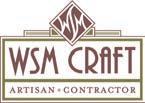
Greenhem Inc.
Joe Vintnell Aberdeen • 910.757.0075 consulting@greenhemusa.com greenhemusa.com
The EnergyWise Home program through Duke Energy is a way for you to help our community to avoid the need to build a new power plant. A free contractorinstalled device on your home's heat pump or electric water heater will reduce consumption during times of high demand. Other than the annual discount applied to your bill, most program participants never notice a difference. Learn more at bluehorizonsproject.com
We have completed many renovations, additions, and several new homes in Asheville since 1996. Now we have begun developing 4 south-facing acres in Oakley, a mile from Biltmore Village. All homes are Energy Star/Green Built Certified — some with breathtaking mountain views.
East West Capital
Brian Nelson Asheville • 828.490.1156 bnelson@eastwestcapitalgroup.com eastwestcapitalgroup.com
East West Capital is a private-equity investment firm with a focus on acquiring, repositioning and managing value-add projects. We focus on driving successful residential and commercial projects in urban areas and in the path of development. Sources of capital include the principals and funding from Asia and the U.S.
JAG Construction is a small company specializing in in-town urban spec construction. Our goal is to make healthy, creative, long-lasting houses more available to the general public. We're examining new ways to reduce the impact of construction on the environment around us and preparing for a future of alternative energy.

Mountain Housing
Opportunities
Geoffrey Barton Asheville • 828.254.4030 ext. 130 geoffrey@mtnhousing.org mtnhousing.org

Olivette Riverside Community and Farm
Allison Smith Alexander • 828.407.0040 allison@olivettenc.com olivettenc.com
Olivette is a 346-acre planned community and historic farm on the French Broad River, just 6.7 miles from downtown Asheville.
***YES
Sure Foot Builders Inc. Raymond Thompson Asheville • 828.242.0925 surefootbuilders@gmail.com surefootbuilders.com


We are a green home building company working in the greater Asheville area. It is our passion to build beautiful and creative homes that add value and comfort to the lives of our owners and community. In each home we strive to articulate modern green building practices.
Village at High Cove, Inc.
Richard Martin Bakersville • 941.780.7817 richardsrq@gmail.com highcove.com
TIP: Use a clothesline when possible to save energy and reduce carbon emissions.
66 | www.GREENBUILT.org
Flooring
Gennett Lumber Company
Philip Gennett
Fletcher • 828.253.3626
pgennett@gennettlumber.com gennettlumber.com
Home Energy Raters
***YES
Eco-Sense

Hunter Dendy Asheville • 828.505.3853 hunter@ecosensedesign.com ecosensedesign.com
Certifying single family and multi-family projects for Green Built Homes, Energy Star for Homes and Duke/Progress rebates.
Residential Energy Diagnostics
Elliott Nailen Fairview • 828.337.1686 elliott@goredforgreen.com
N&M Heating and Cooling Inc
Mick Sleik Hendersonville • 828.489.1308
nmheatingandcooling@gmail.com nmheatingandcooling.com
Design and install custom HVAC systems for customers who are looking for the best product for their needs.
Sustainable Air Inc.
Tyler Healy Asheville • 828.691.9221 info@sustainable-air.com
Indoor Air Quality
***YES
A Healthier Home, LLC

Rick Bayless Asheville • 828.243.5192
rickbayless@ahealthierhomenc.com ahealthierhomenc.com
Immune-system challenges, overall body health and wellness can be connected to your home environment. Board-certified indoor environmental consultant; homehealth investigator.
Insulation
***YES
Conservation Pros
Conservation Pros Asheville • 828.713.3348

harper@conservationpros.com
Energy-efficiency retrofitting firm specializing in insulation, air sealing, crawlspace encapsulation and duct sealing. Serving WNC since 2007.

Insurance
Bankers Insurance 828.242.5068 tnewsome@bankersinsurance.net bankersinsurance.net/locations/as heville-nc-insurance-agency
Interior Designers
Alchemy Design Studio
Traci Kearns Asheville • 828.255.5110 info@alchemy-interiors.com alchemy-interiors.com
Allard & Roberts Interior Design,Inc
***YES
Equinox
David Tuch Asheville • 828.253.6856 David@equinoxenvironmental.com equinoxenvironmental.com
Working to build communities, protect and restore our region’s natural resources, plan for ecological sustainability, and design resilient and regenerative landscapes.
Blue Mountain Design Studio, PLLC
Lisa Cutshaw
Mars Hill • 828.378.4791
lcutshaw@bmdsla.com bmdsla.com
***YES
Equinox
David Tuch Asheville • 828.253.6856
David@equinoxenvironmental.com equinoxenvironmental.com


Providing design inspired by nature for site design, planting design, permaculture, drainage and stormwater to create beautiful and functional landscapes
***YES
Fusco Land Planning & Design, PLLC
Matthew Fusco Asheville • 828.243.6604 Matt@FuscoLA.com FuscoLA.com
Healing Roots Design
Keri Evjy Swannanoa • 828.450.1836 healingrootsdesign.staff@gmail.com healingrootsdesign.com
***YES
Vandemusser Design

Amy Musser Asheville • 828.348.4723 amy@vandemusser.com
vandemusser.com
We provide technical consulting and certification services for green residential construction to builders, architects, developers, and homeowners in Western North Carolina and beyond. Our company is run by an architect and engineer with extensive experience in the industry. We are here to assist with all technical aspects of green building.
Home Inspectors
Energy Home Inspection
Jonathan Gach Saluda • 828.222.0620 jgach@energyhomeinspection.com energyhomeinspection.com
For home sellers, buyers and owners interested in understanding comfort, efficiency, and durability.
Smoky Mountain Home Inspections
Hugh Alexander Candler • 828.712.6829 halexander@smokymtnhi.com smokymtnhomeinspections.com
HVAC Installers
B&R Service, Inc.
Kevin Bauguess North Wilkesboro • 828.783.1177 kevin@bandrservice.com bandrservice.com
Bullman Heating & Air, Inc.
Branson Bullman Asheville • 828.658.2468 natalie@nearu-services.com bullmanheating.com
***YES
Blue Ridge Radon Solutions Tucker Wilson Asheville • 828.252.2212

tucker@blueridgeradonsolutions.com blueridgeradonsolutions.com
Blue Ridge Radon Solutions provides radon testing and mitigation including roughed in radon systems and consultation during construction. Serving all of WNC.
***YES Green R, Inc.
Ron Pariseau Mars Hill • 828.680.9615
Ron@GreenRInc.com
Ventilation is key to the Indoor Air Quality of your energy efficient home. Give us a call and we can help you select the right equipment from bathroom fans to whole house fresh air exchange equipment
***YES Living Stone Design + Build
Alfred Bottego Asheville • 855.720.2435
alfred@livingstoneconstruction.com
livingstoneconstruction.com

Living Stone Design + Build offers an unparalleled luxury building experience for clients seeking to build custom greenbuilt homes. Our team of architects, designers, and trades use the finest quality materials and cutting-edge building techniques while prioritizing quality and collaborative communication throughout the entire building process with our Whole Living approach.
Talli Roberts Asheville • 828.271.4350 talli@allardandroberts.com allardandroberts.com
Griffin Architects PA
Robert Griffin Asheville • 828.274.5979 inquiries@GriffinArchitectsPA.com GriffinArchitectsPA.com
Griffin Architects provide years of experience and interpretations of specific information relative to the clients needs, the site and its orientation, and the neighborhoodÍs relationship to the community. We offer 3-D Energy Modeling/Virtual imaging services of custom residential designs and additions, commercial developments, environmental design, community planning, and historic preservation.
ID.ology Interiors & Design
Laura Sullivan Asheville • 828.252.4403 Laura@idologyasheville.com idologyasheville.com
Natureworks Design
Dawn Bryan
Mountain Home • 828.490.5100 natureworksdesign@gmail.com natureworksdesign.co
Land Planning
EcoForesters
Lang Hornthal Asheville • 828.484.6842 info@ecoforesters.org ecoforesters.org
***YES
Osgood Landscape Architecture, Inc.
Joel Osgood Asheville • 828.337.7496 jo@osgoodla.com osgoodla.com
***YES
Fusco Land Planning & Design, PLLC


Matthew Fusco Asheville • 828.243.6604 Matt@FuscoLA.com FuscoLA.com
***YES
Mary Weber Landscape Architecture,PLLC
Mary Weber Asheville • 828.281.3153 Mweber.asla@gmail.com maryweberdesign.com

Nicholas Anthony Tropeano, PLLC Nicholas Tropeano Morganton • 704.910.9220 nick@tropeanolanddesigns.com tropeanolanddesigns.com
***YES
V & V Land Management and Resource Recovery LLC

Carrie Vogler Weaverville • 828.777.6637 carrie@voglerllc.com voglerllc.com
Planning and execution of sustainable property excavation and grading, including consulting, house site and driveway installation and repair, boulder walls, septic systems and site improvements.
Landscape Architects
BareRoot Designs, PLLC
Jennifer Verprauskus Weaverville • 980.500.9931 barerootdesignsAVL@gmail.com barerootdesigns.com
TIP: During summer months, gardens and landscaping can account for 50 to 70 percent of a home’s water usage. Installing a rainwater-harvesting barrel could take care of your watering needs for the summer.
***YES
Osgood Landscape Architecture, Inc.


Joel Osgood Asheville • 828.337.7496 jo@osgoodla.com osgoodla.com
YummyYards
Laura Ruby Weaverville • 828.785.8624 laura@yummyyards.com yummyyards.com
YummyYards offers full-service landscape consulting and design. We blend form and function to make your landscape and garden the reality of your dreams. We offer a number of services ranging from perennial and annual landscape design to veggie garden installs and designing mini food forests and children’s’ play spaces.
68 | www.GREENBUILT.org
***YES
Landscapers
ecology by design

Teresa Rogerson Alexander • 510.227.7804
tallresa@gmail.com
ecobydesign.net
Ecological landscape designer specializing in native plants, restoration, and maximizing outdoor real estate.


Healing Roots Design
Keri Evjy Swannanoa • 828.450.1836 healingrootsdesign.staff@gmail.com healingrootsdesign.com
Kevin Huckshorn and Associates Inc
Kevin Huckshorn Chapel Hill • 302.824.1218 kevin@kahassociates.com
Living Roofs, Inc.

Emilio Ancaya Asheville • 828.252.4449
emilio@livingroofsinc.com livingroofsinc.com Green roofs and living walls :: design and installation
Mold & Moisture
***YES
A Healthier Home, LLC

Rick Bayless Asheville • 828.243.5192
rickbayless@ahealthierhomenc.com
ahealthierhomenc.com
Immune-system challenges, overall body health and wellness can be connected to your home environment. Board-certified indoor environmental consultant; homehealth investigator.
Precision Restoration Services
Anne Bellizio Weaverville • 828.645.4546
anne@restorewnc.com prs2restore.com
Plumbers
***YES
Blue Planet Plumbing LLC

Georg Efird Asheville • 828.423.6289
info@blueplanetplumbing.com blueplanetplumbing.com
Specializing in premium water filtration (so you can stop paying for bottled water), main line replacements, energy efficient water heater options (hybrid & tankless), well work, inspections, etc. Offering industry leading warranties!
Radiant Heat
***YES
Sundance Power Systems

James Fisher Weaverville • 828.776.5349 jfisher@sundancepower.com sundancepower.com
Sundance Power Systems has empowered people with solar since 1995. Whether it’s a solar system with battery backup or radiant floor heat, Sundance has the expertise and knowledge needed to handle the project. From smaller residential systems to large commercial and institutional projects, the Sundance team is ready to dance!
Realtors
***YES
Be Realty Home Brokerage

Bobbi Holland Owner/Broker 828.275.6170 bobbi@berealtyavl.com berealtyavl.com/
Bold Mountain Team at Nest Realty
Robin Cape Asheville • 828.216.4009 robin.cape@nestrealty.com boldmountainteam.com
Joseph Ruiz at Mosaic Community Lifestyle Realty

Joseph Ruiz Asheville • 828.231.3475 joseph@mymosaicrealty.com mymosaicrealty.com
Kathleen Cook at Mosaic Community Lifestyle Realty
***YES
Love The Green Team Real Estate Consulting Firm -Trade Mary Love Asheville • 828.279.6723 mary@lovethegreen.org lovethegreen.org

Love The Green Team is a women/veteran-owned full-service real estate company. Our mission is to create a sustainable world, one home at a time. We provide services to buyers and sellers, and property management services. We are your matchmaker for the home that you love which fits your budget.
***YES MOSAIC Community Lifestyle Realty
***YES
Amy Smith at Modern Mountain Real Estate

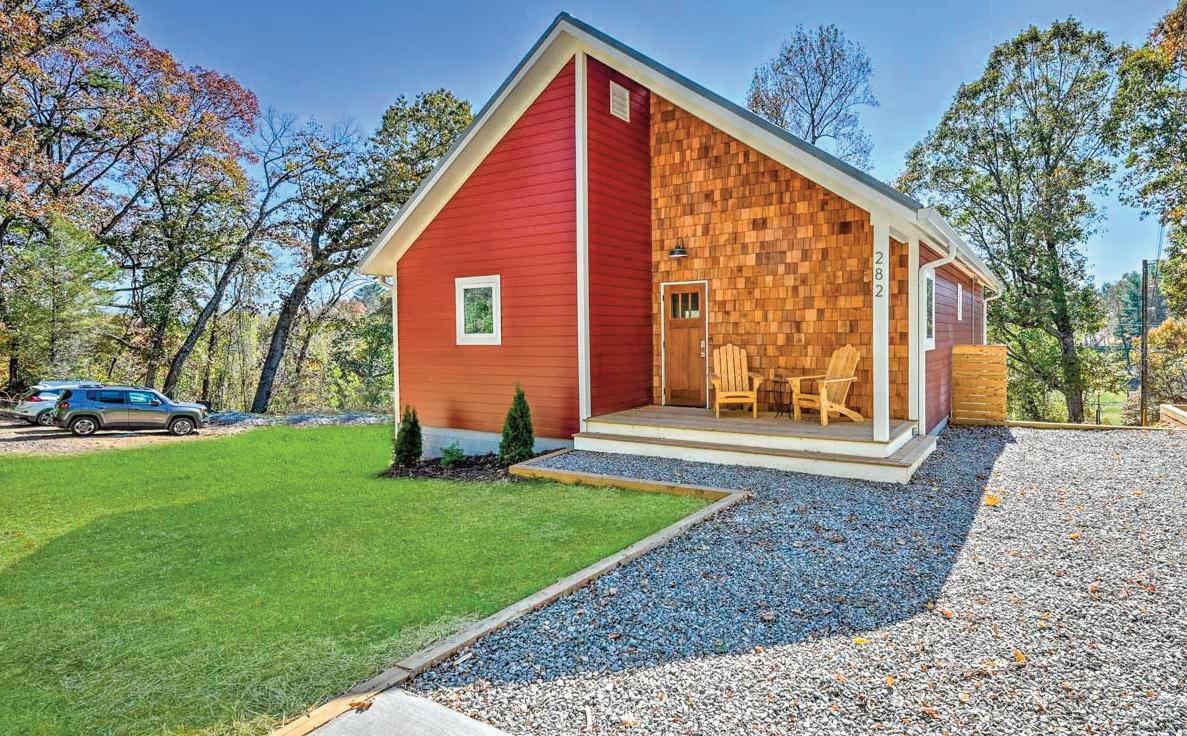
Amy Smith Asheville • 828.333.3235 amy@asmithrealtor.com asmithrealtor.com
Kathleen Cook Asheville • 828.280.6839 kathleen@mymosaicrealty.com mymosaicrealty.com/realestate/ag ent/kathleen-cook
A Building Green Real Estate cerified agent helping residents buy, build, and sell their Green Built Asheville homes.
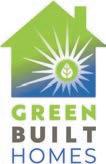

Mike Figura Asheville • 828.707.9556 Mike@mymosaicrealty.com mymosaicrealty.com
We specialize in green real estate and intown properties. Our approach is to advance the interests of our clients by being attentive to their needs and to negotiate aggressively on their behalf. Real estate is our job and passion. Call or email for a free consultation over coffee or tea.
GREEN HOME & LIVING GUIDE 2023-24 | 69
Celebrating More Than 2,800 Certified Green Built Homes in North Carolina With Net Zero Ready, Net Zero, Net Zero Water, & Regenerative Pathways Available greenbuilthomes.org • 828-254-1995 • Save Energy & Money • Improve Comfort & Durability • • Protect The Environment • Third-Party Verification • • City & Utility Rebates Available • A Program Of M AKING YOUR H OME G REENER FOR THE E ARTH , H EALTHIER FOR YOU Certified Home built by Nicholson & Son RE DUCE RE USE RE CYCLE CONNECT WITH US AT INSTAGRAM.COM/GREENBUILTORG
Mosiac Community
Lifestyle Realty
Ward Caldwell
828.424.5231
ward@mymosaicrealty.com
mymosaicrealty.com/realestate/ag ent/ward-caldwell
***YES
National Land Realty

Pat Snyder
Fairview • 828.772.5899
psnyder@nationalland.com nationalland.com
National Land Realty supports clients looking to buy or sell large land tracts (10+ acres) for homestead, conservation, investment, recreation, agricultural, family estate, and residential purposes. Our team leverages best-in-class technology and partners with local experts who focus on sustainable forestry and ecological design to protect our natural resources.
Recycling
***YES
Asheville Area Habitat for Humanity
Asheville & Weaverville
828.254.6706
jbridgman@ashevillehabitat.org
ashevillehabitat.org
The Asheville Habitat ReStores sell donated items to the general public with proceeds supporting Habitat's building programs. Find building materials, appliances, furniture and more. The removal and salvage of usable items such as kitchen cabinets is available through their Deconstruction program.

Junk Recyclers Inc
Phillip Stoltz Asheville • 828.707.2407
junkrecyclers1@gmail.com junkrecyclers.net
Waste Pro
Teri Reedy
Arden • 828.620.0302
treedy@wasteprousa.com wasteprousa.com
Renewable Energy
***YES
Asheville Solar Company
Nate Pembleton Fletcher • 828.808.4153 nate@ashevillesolarcompany.com ashevillesolarcompany.com
Asheville Solar Company is a small, family-run business that places honesty and customer benefit before profit.

***YES
Blue Ridge Power

Luke Bukoski
Asheville • 828.301.1340
lbukoski@blueridgepower.com
We are an engineering, procurement and construction company building utilityscale renewable energy projects from coast to coast.
***YES
SolFarm Solar Co.

Arden • 828.332.3003 office@solfarm.com solfarm.com
Serving both the residential and commercial markets since 2012, SolFarm Solar Co. is a one stop shop for all things solar energy, energy storage, and EV chargers. Our team is ready to design, install, and maintain your solar energy system. From off-grid cabins to MW+ projects, we are here to help you reduce your carbon footprint and save on your energy bills.
***YES
Geothermal Design Center Inc.

Rick Clemenzi, PE, CGD Asheville • 828.712.6786 rclemenzi@geothermaldesigncenter.com geothermaldesigncenter.com
We are Geothermal HVAC Experts focused on using Geothermal Heat Pumps (GHP) to achieve Decarbonization. Geothermal provides the most efficient, costeffective, longest life, and reliable HVAC system possible for all residential, commercial, and industrial sites. We are glad to support those who consider Climate Action important and want to help the planet.
MB HAYNES Corporation
Chris Pennington Asheville • 828.254.6141 cpennington@mbhaynes.com mbhaynes.com
Save energy and slash power bills with solar energy systems. Free analysis and financing, and help with tax incentives.
***YES
Evergreen Construct Inc.

Darren Henegar
Leicester • 828.779.4077
evergreenconstructinc@gmail.com
evergreenconstruct.com
Evergreen Construct specializes in custom-built homes and renovations, using your inspiration to create mindfully crafted structures through a collaborative process.
***YES
JAG & Assoc. Construction, Inc.


Jody Guokas Asheville • 828.216.0914
jody@jaggreen.com jaggreen.com
JAG Construction is a small company specializing in in-town urban spec construction. Our goal is to make healthy, creative, long-lasting houses more available to the general public. We're examining new ways to reduce the impact of construction on the environment around us and preparing for a future of alternative energy.
***YES
Falcon Construction and Development
***YES
Pisgah Energy
Evan Becka Asheville • 828.206.4780
evan.becka@pisgahenergy.com pisgahenergy.com

Providing comprehensive solar and energy storage design and development services for commercial, municipal and institutional clients across the Southeast.
Rhino Renewables
Solar & Electric
Jacob Benton Asheville • 828.214.5126
office@rhinorenewableswnc.com rhinorenewableswnc.com
Dedicated to education based sales and quality craftsmanship, we are helping local owners transition to solar energy. "Charging the Future"
***YES
Sugar Hollow Solar, Inc.

Doug Ager Fairview • 828.776.9161 info@sugarhollowsolar.com sugarhollowsolar.com
As the largest local solar installation company serving WNC for 13 years, we specialize in top-tier solar array design, seamless installations, advanced battery backup solutions, and reliable maintenance services.
***YES
Sundance Power Systems

James Fisher Weaverville • 828.776.5349 jfisher@sundancepower.com sundancepower.com
Sundance Power Systems has empowered people with solar since 1995. Whether it’s a solar system with battery backup or radiant floor heat, Sundance has the expertise and knowledge needed to handle the project. From smaller residential systems to large commercial and institutional projects, the Sundance team is ready to dance!
Renovators & Remodelers
A Neighborhood Carpenter Matthew Agrella-Sevila Brevard • 828.577.4554 matthew@aneighborhoodcarpenter.com aneighborhoodcarpenter.com
A Neighborhood Carpenter is a licensed commercial and residential General Contractor.
***YES’
Best Built Inc.
Adrienne Buck Clyde • 828.506.9943 info@bestbuiltcustoms.com bestbuiltcustoms.com
Veteran Green Built Contractor located in Haywood County. Design-built custom homes tailored to fit your lot or one of ours. Lots or Home/Land packages available.
David Ross Asheville • 828.274.3055
tanya@falconbuilt.com falconbuilt.com
Residential and Commercial construction services. 2012 Parade of Homes Best in Show winner. Specializing in quality green construction and design build of both new homes and remodels of existing.
***YES
RCJ Building Inc.

Robert Jacobelly Asheville • 828.216.4433 rcjbuilding@yahoo.com
RCJ Building Inc.'s custom homebuilding professionals have the knowledge and expertise that you'll need when you have the opportunity to build the house you've always wanted. We understand what goes into the building process, and more importantly, what goes through the minds of future homeowners during the build.
***YES
HomeSource Real Estate & Construction Co., Inc.

Timothy Alexander Asheville • 828.252.1022 tim@homesourcebuilders.com homesourcebuilders.com
Fully licensed and insured custom home builder and remodeling contractor, providing expertise and commitment in construction. Offering turnkey service, including home design, kitchen and bath design, and product selection under one roof. Current and past projects include more than 100 custom homes and hundreds of remodels from large to small.
***YES
River Birch Builders


Pierce Harmon and Griff Gamble Asheville • 828.423.9813 riverbirchbuilders@gmail.com riverbirchbuildersnc.com
We offer quality and craftsmanship in the building of green and energy-efficient homes. We offer design and build services for fully customized homes, and experience with a range of architectural styles and sizes. From start to finish, we'll work closely with you to make your dream home become a reality.
***YES
Jade Mountain Builders & Co. Inc

Hans Doellgast Fairview • 828.216.3948 hans@jademountainbuilders.com jademountainbuilders.com
Jade Mountain Builders is a team of 39 craftsmen who pride themselves on taking an ecologically sensitive approach to building homes.
***YES
RockStar Marble & Granite
George Douglas Fletcher • 828.505.2137 george@rockstarmarble.com rockstarmarble.com
RockStar Marble and Granite is a leading countertop supplier of hand-finished natural stone, quartz and recycled products. Opened in 2006, we have built our customer base by providing top quality products at a fair price and a reasonable time frame.

The Hands of Sean Perry
Sean Perry Asheville • 828.258.7272 hosp@seanperryinc.com seanperryinc.com
70 | www.GREENBUILT.org
The Smart$aver program through Duke Energy provides prescriptive and custom rebates for energy-efficient equipment upgrades. Learn more at bluehorizonsproject.com.
TIP: Using a programmable thermostat that adjusts the temperature when you’re not home saves you money on your energy bill and uses less energy.
Tricob Custom Building and Remodeling
Mary Cobzaru
Fairview • 828.989.3532
Tricobcustom@gmail.com
Residential Designer
***YES
Mountain Sun Building & Design

Emily Boyd Asheville • 828.713.0549
emily@mountainsunbuilding.com
mountainsunbuilding.com
A small design/build firm focused on site-specific design and zero energy homes, we can work with clients from finding the perfect lot through move in and landscaping. Our passion is creating finely crafted, light filled homes that connect interior spaces with their natural surroundings.
Salvage
***YES
Asheville Area Habitat for Humanity
Asheville & Weaverville 828.254.6706
jbridgman@ashevillehabitat.org ashevillehabitat.org
Site-work
***YES
V & V Land Management and Resource Recovery LLC



Carrie Vogler Weaverville • 828.777.6637
carrie@voglerllc.com
voglerllc.com
Planning and execution of sustainable property excavation and grading, including consulting, house site and driveway installation and repair, boulder walls, septic systems and site improvements.
***YES
Timberframe Horizons, LLC
Tom Rouse
Fairview • 828.222.2555
ali.timberframe@gmail.com
TimberFrameHorizons.com
We are a design build firm that specializes in creating energy-efficient custom artisan homes utilizing timber frame construction.
Responsible Investing
***YES
National Land Realty

Pat Snyder Fairview • 828.772.5899
psnyder@nationalland.com nationalland.com
National Land Realty supports clients looking to buy or sell large land tracts (10+ acres) for homestead, conservation, investment, recreation, agricultural, family estate, and residential purposes. Our team leverages best-in-class technology and partners with local experts who focus on sustainable forestry and ecological design to protect our natural resources.
Reuse Retail
***YES
Asheville Area Habitat for Humanity
Asheville & Weaverville 828.254.6706
jbridgman@ashevillehabitat.org ashevillehabitat.org
Structural Materials
***YES
Timberframe Horizons, LLC
Tom Rouse Fairview • 828.222.2555 ali.timberframe@gmail.com
TimberFrameHorizons.com


We are a design build firm that specializes in creating energy-efficient custom artisan homes utilizing timber frame construction.
Supporting Members
Cady/Guyton Construction
Boone Guyton and Claudia Cady Alexander • 828.683.3688 boone.guyton@gmail.com
***YES
Duke Energy

Jennifer Bennet Sumter • 828.258.4362
Jennifer.bennet@duke-energy.com duke-energy.com/newhomes
The Residential New Construction Program helps homebuyers find the best, most energy-efficient and comfortable new homes on the market. Homes are verified by independent, nationally accredited Home Energy Rating System Raters to meet stringent standards. Find participating builders at duke-energy.com/mynewhomewnc. For details on our builder program, visit duke-energy.com/newhomes.
Our team at Blue Horizons Project offers free Home Energy Chats to provide unbiased technical advice and expertise about all your home energy questions, including but not limited to solar energy, weatherization, HVAC replacement, and hot water heaters. Learn more at bluehorizonsproject.com
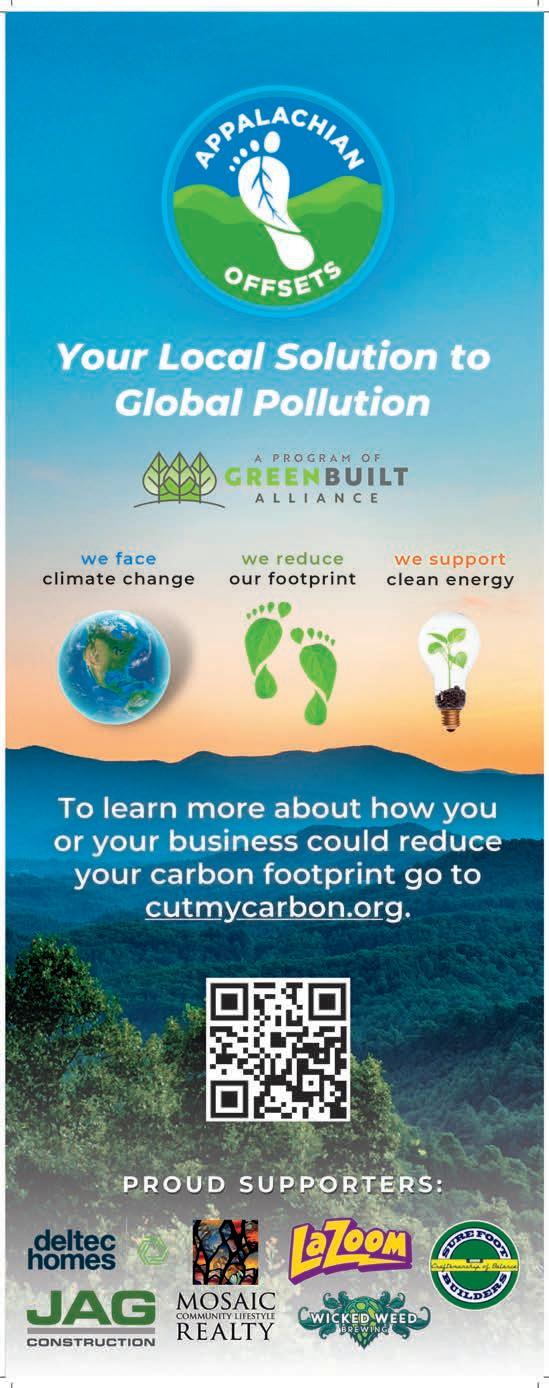
GREEN HOME & LIVING GUIDE 2023-24 | 71
Energy & Environmental Building Alliance (EEBA) 612.325.5719
aaron@eeba.org eeba.org
Integritive
Joy Kirk Asheville • 828.250.0970
joy@integritive.com integritive.com
At Integritive, you can expect the proven results of a large firm with the flexibility of a small creative enterprise. You can expect the professionalism of seasoned experts with the fresh ideas of an avid entrepreneur. You can expect the technical muscle of talented programmers who understand your needs.
Rockbrook Camp for Girls
Jeff Carter Brevard • 828.884.6145

jeff@rockbrookcamp.com rockbrookcamp.com
Sustainable Wood Products
***YES
Architectural Woodcraft
Craig Weis Asheville • 828.258.9977
craig@architecturalwoodcraft.com
architecturalwoodcraft.com
"Fine Cabinetry. Doors Custom DesignBuilt. WNC Locally-made Low VOC Finishes. Grid-Tied Solar Powered Shop Visit www.ArchitecturalWoodcraft.com to Request a Quote"
System Built Homes
Tiny & Small Homes
***YES
Green Source Construction Management, Inc


Josh Scala Black Mountain • 828.337.0284 greensourcebuilder@gmail.com facebook.com/blackmountaingreenbuilder
Nanostead LLC
Jeramy Stauffer Marshall • 828.206.2526 jsstauff@gmail.com nanostead.com
Wall System Installers
***YES
Skyland Environmental
Sally Maher Asheville • 828.390.4983 smaher@exactwater.com skylandenvironmental.com
Turtle Mountain Vacation
Rentals
Karen MacNeil Asheville • 828.242.8003 urbanforestalliance@gmail.com

Surveyors
***YES
Blackrock Surveying and Land Design PC

Jamie Brady Asheville • 828.225.4341
jbrady@blackrocksurveying.com blackrocksurveying.com
Our services include topographic surveying, construction staking, boundary determination and relocation, subdivision designs, elevation certification and consultation on property use.
Deltec Homes

Leigha Dickens Asheville • 828.253.0483
ldickens@deltechomes.com deltechomes.com
Deltec Homes is an award-winning prefabricated homebuilder. Offering round and modern styles, our homes are best known for energy efficiency, great views, and resilience. We pride ourselves on manufacturing homes sustainably in a facility powered with 100% renewable electricity.
***YES
Timberframe Horizons, LLC

Tom Rouse Fairview • 828.222.2555
ali.timberframe@gmail.com
timberframehorizons.com
We are a design build firm that specializes in creating energy-efficient custom artisan homes utilizing timber frame construction.
***YES
K-Wall Poured Walls, LLC

Rich Kubica Fletcher • 828.654.9255 rich@k-wall.com k-wall.com
***YES
Superior Walls of NC
Bob Bauer
Old Fort • 828.606.8371 bbauer@superiorwallsnc.com superiorwallsnc.com
Windows, Doors & Awnings
***YES
Architectural Woodcraft
Craig Weis Asheville • 828.258.9977
craig@architecturalwoodcraft.com
architecturalwoodcraft.com
Fine Cabinetry. Doors Custom Design-Built. WNC Locally-made Low VOC Finishes. Grid-Tied Solar Powered Shop. Visit architecturalwoodcraft.com to request a quote
Morrison Millwork
Stacy Fields Fletcher • 828.545.2194 stacy@morrisonmillwork.com morrisonmillwork.com
Our focus on windows and doors provides unparalleled service, quality products, and competitive pricing. In partnership with clients and vendors, we have established ourselves as a preeminent dealer for windows, doors, and hardware. We invite you to visit one of our showrooms and speak with our knowledgeable and professional staff.
***YES
MudStrawLove LLC

Steve Kemble Asheville • 828.775.4823 connect@mudstrawlove.com mudstrawlove.com
We help plan homes and teach techniques using straw bales, earthen materials (cob, earthbag, etc.), and lime- or clay-based plasters, paints and floors. Site and Design Consultation, Workshops, Aprrenticeships, Crew Trainings, Permaculture since 1990.
Woodworkers & Cabinetry
***YES
Architectural Woodcraft
Craig Weis Asheville • 828.258.9977 craig@architecturalwoodcraft.com



architecturalwoodcraft.com
Fine Cabinetry. Doors Custom Design-Built. WNC Locally-made Low VOC Finishes. Grid-Tied Solar Powered Shop. Visit architecturalwoodcraft.com to request a quote.
• Appalachian Offsets is a voluntary carbon-offset program from Green Built Alliance that offers businesses, organizations, and individuals the option to easily reduce or offset their carbon footprint. Supporters offset their emissions by paying into a community fund that helps make energy-efficiency improvements within local nonprofits, schools and low-income housing. Learn more and donate at cutmycarbon.org
• Duke Energy's Home Energy House Call program offers eligible homeowners a free home-energy assessment to help you learn how your home uses energy, including where you can improve comfort and maybe even save money. You’ll also get a free Energy Efficiency Starter Kit. Learn more at bluehorizonsproject.com
• Land of Sky Waste Reduction Partners helps organizations improve environmental and energy management through efficiency techniques that save money. The WRP team conducts free on-site assessments and provides consulting services to businesses and public facilities throughout North Carolina. Learn more at bluehorizonsproject.com.
***YES
HomeSource Design Center
Danielle King Asheville • 828.712.6860
info@the-homesource.com the-homesource.com
One convenient location providing home improvement, new construction and remodeling products; kitchen and bath design; and all your construction needs. Specializing in cabinets, countertops, hardwood flooring, tile, closet systems, stone, cabinet and bath hardware, and window treatments. Visit our showroom to view samples, make selections or speak with a designer.
***YES
Ironwood Studios LLC

Thomas Gibson Asheville • 978.501.6954
tom@ironwoodstudios.org
ironwoodcustomcabinetry.com
Ironwood Studio provides innovative and artistic solutions to spacial needs, specializing in custom cabinetry, built-ins and finely crafted furniture.
***YES
Narwhal Design Build, PLLC

Joe Archibald Asheville • 828.273.9509 joe@narwhalbuilt.com narwhalbuilt.com
Craft-based design & fabrication firm providing architectural design and custom woodworking, utilizing environmental practices & materials and guided by social consciousness.
***YES
Sage Builders

Doug Keefer Asheville • 828.713.7208 info@thesagebuilders.com thesagebuilders.com
SAGE uses Sustainable, Appropriate, Green and Efficient building techniques to create beautifully hand-crafted homes with passive and active solar amenities.
72 | www.GREENBUILT.org
TIP: Asheville Greenworks offers “Hard 2 Recycle” days throughout the year to recycle items that cannot be included in your curbside pickup and to avoid the landfill.




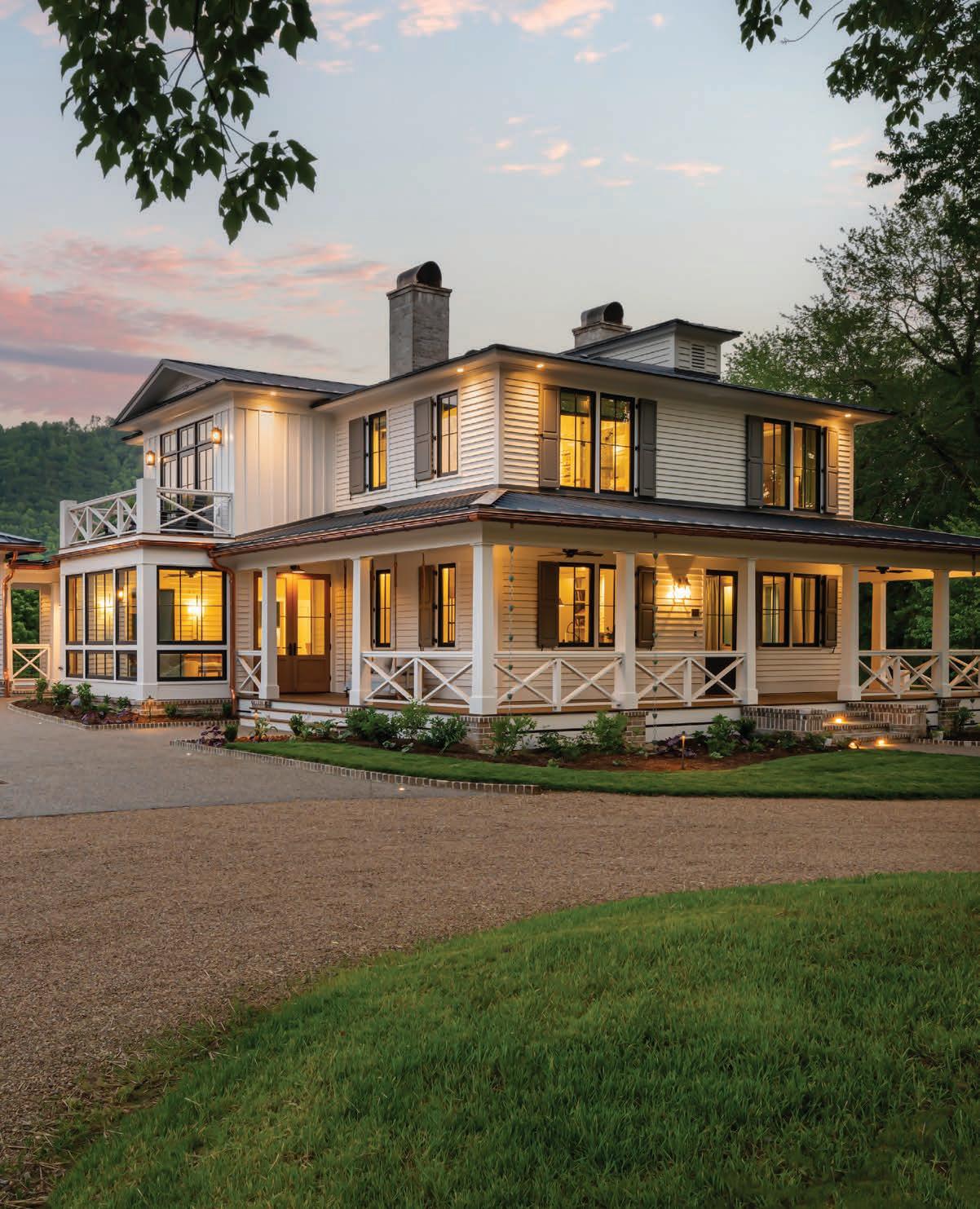



























































































 BY STUART ZITIN
BY STUART ZITIN
























 BY SALLY MAHER
BY SALLY MAHER

















































 BY MATTHEW VANDE AND AMY MUSSER
BY MATTHEW VANDE AND AMY MUSSER






























































 BY MEGHAN LUNDY - JONES
BY MEGHAN LUNDY - JONES

















 BY JOE FRANCO
BY JOE FRANCO






 BY DAVID GORDON
BY DAVID GORDON



















































































































































